TOO HOT TO HANDLE
Discover the Chanel bags rising in price faster than jewellery, watches and art

Stone Me! Drummer Charlie Watts’ book collection under the hammer
SEPTEMBER 2023
SECRET’S OUT
WHY SPYWARE
IS
BACK IN FASHION
7
Rules of Clock Buying
And the makers to look out for
GOLDEN OPPORTUNITY
His paintings may have skyrocketed at auction, but prints by the Austrian artist Gustav Klimt are well within reach...for now
EXCLUSIVE BOOK OFFERS FOCUS ON THE STAITHES GROUP TOP COLUMNISTS ALSO INSIDE Victorian consoles • The Diana Steel Collection • Sale results ANTIQUE COLLECTING VOL 58 N0.4 SEPTEMBER 2023
A FRENCh TOUCH
More than 6,000 auctions across Europe

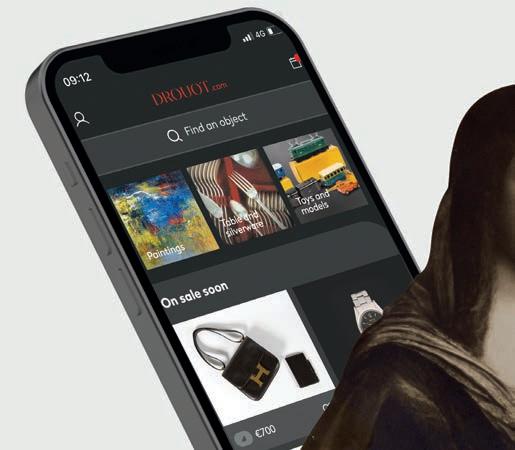
Old Masters paintings - Furniture - Jewellery - Books...

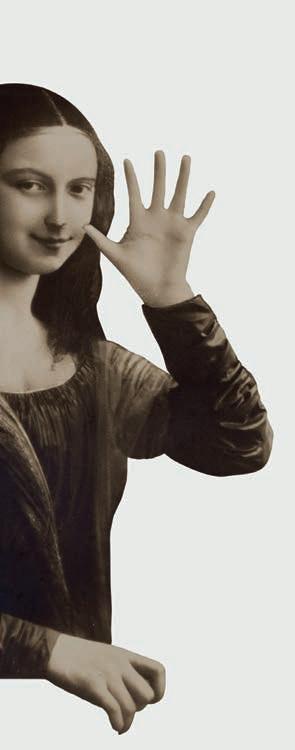
Given my time again I can think of no better career than that of a spy. How successful I would be is open to debate. Not known for bravery, I suspect I would give up state secrets for the promise of a Cadbury’s creme egg. I once met a CIA agent who had spied for the Russians and shared one of the techniques taught to would-be intelligence o cers under interrogation. It was: admit nothing, deny everything and make counter allegations.

It has served me well over the years. Husband: “Did you pay over £100 for that chair?” Wife: “Absolutely not, and besides, what about the screwdriver you bought last week?” I urge you to try it.
So when the exhibition Spies Lies and Deception opens this month at the Imperial War Museum in London I will be among the rst in the queue. In this month’s magazine we go behind the scenes to discover the ingenuity, bravery and downright chutzpah of some of the men and women for whom spy craft was their trade. Did you know about the camou age trees used in the trenches of WWI, or the dummy papier-mâché heads used to attract and trace snipers’ bullets. Have a look on page 18.
Talking of under the radar, on page 34 we take a look at the remarkable band of artists known as the Staithes Group, named after the secluded shing village on the Yorkshire coast which they made their home at the end of the 19th century. e best-known of the artists was Dame Laura Knight, whose work sells for thousands, but at a sale this month estimates for some lesser-known members of the school start at just £100.
You will need slightly more than that if you plan to put Chanel bags at the heart of your collection. To mark this month’s V&A exhibition on the pioneering founder of the French fashion house – Coco Chanel – designer goods specialist, Popsy Kundi, puts bags by the brand in the spotlight. Credit Suisse this year predicted handbags as the hottest collectable of 2023 so reading the article on page 44 may be one of the most pro table things you can do.
Elsewhere, the magazine’s furniture expert David Harvey shines a light on the Victorian makers Wright and Mans eld, Mark Wiltshire previews the sale of the remarkable collection of the Rolling Stones’ drummer Charlie Watts and Simon Frodsham, the great-great-great nephew of the renowned clock and watch maker, Charles Frodsham, gives his low down on clock collecting. Enjoy the issue.
KEVIN FINCH considers the market for prints by the Austrian artist Gustav Klimt, page 30
Georgina Wroe, Editor


KEEP IN TOUCH
Write to us at Antique
Collecting, Riverside House Dock Lane, Woodbridge, Suffolk, IP12 1PE, or email magazine@accartbooks.com. Visit the website at www.antique-collecting.co.uk and follow us on Twitter and Instagram @AntiqueMag
ONLY £38 for 10 issues
is 19th-century blue enamel serpent bracelet, with an opal, diamond and ruby set head, which has an estimate of £3,000-£5,0000 at Noonans’ jewellery sale on September 12.

DAVID MESSUM discovers under-valued work by the unsung Staithes Group of artists, page 34
Call 01394 389969 or email charlotte.kettell@accartbooks.com
POPSY KUNDI reveals the Chanel bags giving some of the best returns in the collectables market, page 44
Editor: Georgina Wroe, georgina. wroe@accartbooks.com
Online Editor: Richard Ginger, richard.ginger@accartbooks.com


Design: Philp Design, james@philpdesign.co.uk
Advertising and subscriptions: Charlotte Kettell 01394 389969, charlotte.kettell @accartbooks.com
ANTIQUE COLLECTING 3 IN THIS ISSUE
THE TEAM
MARK WILTSHIRE previews the collection of the Rolling Stones’ drummer Charlie Watts, page 28
Welcome
SUBSCRIBE
TODAY TO ANTIQUE COLLECTING
FIRST WORD
love!
We

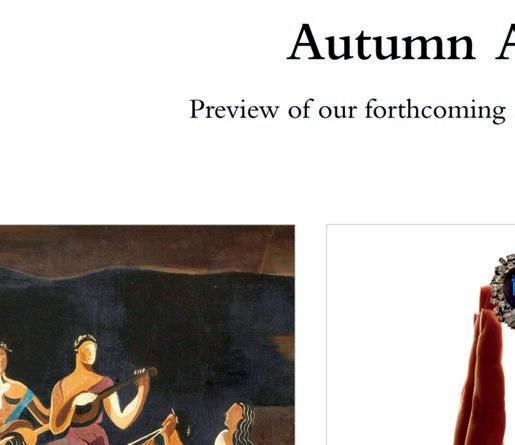




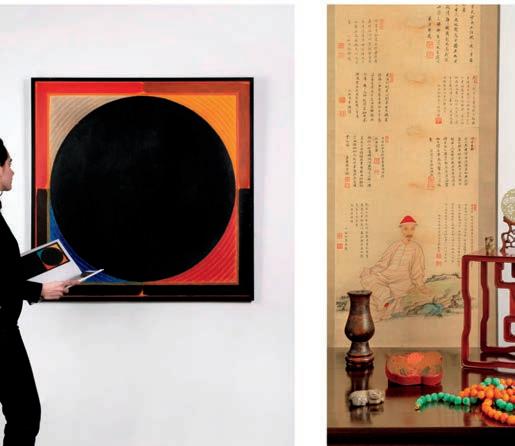



Three Chanel heartshaped bags, each estimated at £15,000£20,000 at Bonhams’ online sale from September 11-21

REGULARS
3 Editor’s Welcome: Georgina Wroe introduces this month’s issue with a special emphasis on spies and their craft

6 Antique News: All the latest events and exhibitions sure to excite collectors in September
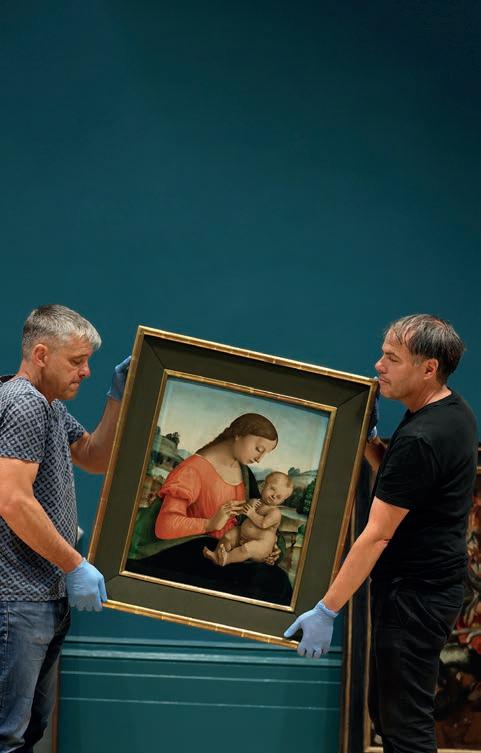

10 Your Letters: e debate over the Lancaster furniture makers Gillows’ role in the transatlantic slave trade continues
12 Around the Houses: A whistlestop our of the country’s leading salerooms o ers some ex sales including a century-old chocolate tin and seven rare Kashmir sapphires

16 Waxing Lyrical: David Harvey puts a pair of consoles with all the hallmarks of being by the Victorian maker Wright and Mans eld in the spotlight
28 Saleroom Spotlight: Behind the scenes at the auction of the surprising collection owned by the Rolling Stones’ drummer Charlie Watts
38 Puzzle Pages: Take on the intellect of quiz and crossword editor Pete WadeWright with this month’s brain teasers
48 Book O ers: Make the most of exclusive deals on a range of books from our sister publisher ACC Art Books

54 Top of the Lots: ree special collections go under the hammer this month in Su olk including that of Diana Steel, co-founder of the Antique Collectors’ Club
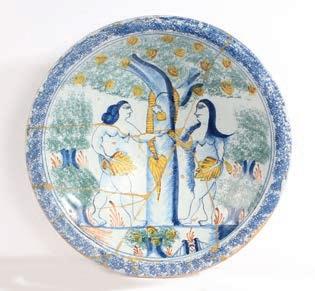
56 An Auctioneer’s Lot: Charles Hanson raises a glass to a special bottle dedicated to glass-making pioneer omas Wedgwood
58 Fair News: Two important London fairs are previewed, as well as a popular event in North Yorkshire
59 Fairs Calendar: Listings of all the major UK events taking place this month
60 Auction Calendar: Get the low-down on all the sales in your area and beyond with our up-to-date guide
66 e Last Word: Antiques Roadshow specialist Marc Allum takes ownership of a very special 120-year -old possession
FEATURES
18 Life of Spy: e ingenious plots of the UK’s intelligence ministries are put in focus at a new exhibition at the Imperial War Museum
22 From Russia With Love: When the contents of the KGB museum went under the hammer, including “bugged” ashtrays and a mini camera in a lipstick, it attracted worldwide interest
24 Hidden Talent: John Ramm puts the work of the real-life intelligence o cer and artist Graham Barry Clilverd in the spotlight
30 Golden Opportunity: While paintings by the Austrian artist Gustav Klimt sell for millions, his prints are within the reach of many collectors, writes Kevin Finch
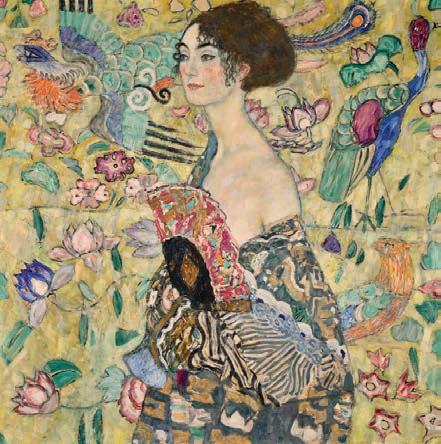
34 Tides of Change: Work by the unsung and undervalued early British impressionists known as the Staithes Group is put in focus
40 Time to Buy: With many varieties of clocks severely undervalued there’s never been a better time to start a collection, writes Simon Frodsham

44 Material Girl: e life and times of the pioneering French designer Coco Chanel is explored along with a collecting guide to the fashion house’s iconic handbags
50 Rich Tapestries: Two rare designs by William Morris have gone on show at his county retreat Kelmscott Manor. Antique Collecting lifts the lid
WEEKDAYS FROM 9.30AM TO 1PM,

ANTIQUE COLLECTING 5 THIS MONTH
COVER
Contents
VOL 58 NO 4 SEPTEMBER 2023 ALSO INSIDE Victorian consoles The Diana Steel Collection Sale results Stone Me! Drummer Charlie Watts’ book collection under hammer TOO HOT TO HANDLE Discover the Chanel bags rising in price faster than jewellery, watches and art GOLDEN OPPORTUNITY SEPTEMBER 2023 His paintings may have skyrocketed at auction, but prints by the Rules of Clock Buying 7 And the makers to look out for WHY SPYWARE FASHION SECRET’S OUT FOLLOW US @AntiqueMag
TO SUBSCRIBE TODAY VISIT WWW.ANTIQUE-COLLECTING.CO.UK/SUBSCRIBE
40 6 12 54 30 28
WHAT’S GOING ON IN SEPTEMBER
A NTIQUE news
Below e portrait soared above pre-sale expectations of £600,000£800,000 at Sotheby’s
New view
Visitors to a Liverpool gallery can feast their eyes on the finest 14th-17th-century art after four of its rooms reopened following a £4m three-year refurb.
The Walker Gallery is staging Renaissance Rediscovered featuring work by Michelangelo, Titian, Rubens and Rembrandt alongside newly acquired masterpieces.

Masterpieces such as Simone Martini’s Christ Discovered in the Temple, Holbein’s portrait of Henry VIII, and Rembrandt’s SelfPortrait as a Young Man feature in the space which covers around 6,000 sq ft.
New acquisitions include Allegory of Painting and Music, the first painting by Giovanni Andrea Sirani to enter a UK public collection, and Flowers in a Glass Vase on a Marble Ledge by 17th-century Dutch artist, Willem van Aelst.
The role of the wealthy Victorian collectors who shaped the Walker Art Gallery is also explored. Joseph Mayer (1803-1886) presented 14,000 objects to the city in 1867, while the MP William Roscoe (1753-1831) also donated important paintings.
Parr for the course
One of two surviving contemporaneous paintings of Katherine Parr, the last wife of Henry VIII, became the most expensive Tudor painting ever sold at auction when it fetched £3.4m going to a UK collector.

Attributed to Master John, the portrait appeared on the secondary market for the rst time in almost 200 years having sold for just over £70 in 1848.
From the collection of the Earl of Jersey, in 1969 it was erroneously described as being destroyed by re in Roy Strong’s Tudor and Jacobean Portraits (where the sitter was identi ed as Lady Jane Grey).
e other portrait of Parr, also attributed to Master John, is in the National Portrait Gallery. e brooch in the portrait was made for Parr by her favourite goldsmith, the Dutch jeweller Peter Richardson.
WINNING STREAK
The Burrell Collection in Glasgow has scooped the prestigious title of ‘museum of the year’, along with a prize of £120,000.
Situated in Pollok Country Park, the 9,000-object collection of Sir William and Constance Burrell, beat the other finalists which included Leighton House in London, the Metropolitan Arts Centre (MAC) in Belfast, the Natural History Museum and the Scapa Flow Museum in Orkney.
One of the judges, the historian and broadcaster Mary Beard, said: “The Burrell Collection is a treasure trove of objects to discover, with everything from one of the UK’s most important collections of Chinese art, to medieval tapestries and stained glass, and works of art by Rembrandt, Degas and more.”
The Burrell Collection welcomed more than 500,000 visitors in 2022 following its closure for a major refurbishment.
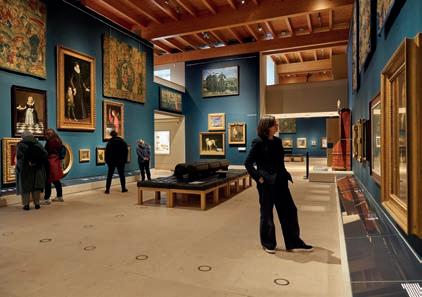
NEWS All the latest
After the summer break it’s back to normal in the antiques world with a packed autumn schedule in prospect
Above Francesco Signorelli (c. 1490-1553) Madonna and Child, being intalled at the Liverpool gallery, photo Gareth Jones
Right e Burrell Collection, © Janie Airey Art Fund
6 ANTIQUE COLLECTING
1Star turner
Watercolour landscapes by J.M.W. Turner (1775-1851) and Richard Parkes Bonington (1802-1828) go on show in London this month – the rst time the works have been on display in 17 years.

Turner and Bonington: Watercolours from the Wallace Collection opens at the gallery on September 20, bringing together four views of Yorkshire by Turner and ve scenes of Normandy and Venice by Bonington. Turner was a British artist, while Bonington was born in Britain but brought up in France. Turner’s relationship with Yorkshire began with his rst visit in 1797 after which he repeatedly returned.
3Bourne again
Ditchling Museum of Art + Craft in Sussex honours the work of its co-founders the modernist textile makers Hilary Bourne (1909-2004) and Barbara Allen (1903-1972).


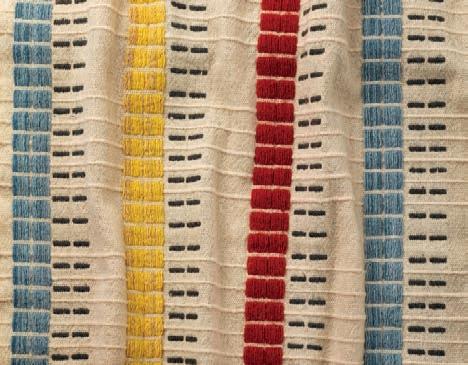
e pair, whose work is largely unknown by most collectors, ran an internationally successful textile studio, designing and making a variety of fabrics including tweed for Fortnum & Mason, furnishing fabric for Heals and scarves for Liberty’s.
ey went on to win commissions to make the costumes for the multi-Oscar winning 1959 lm Ben-Hur and the interiors of the UK’s rst jet planes. Double Weave: Bourne and Allen’s Modernist Textiles runs from September 16 to April 14.
Left J.M.W. Turner (17751851) Scarborough Castle Boys Crab Fishing, 1809, © the Trustees of the Wallace Collection

Below left J.M.W. Turner (1775-1851) Hackfall, near Ripon, c. 1816, © the Trustees of the Wallace Collection
Far right Cicely Mary Barker (1895-1973), the Crocus Fairies from Flower Fairies of the Spring, © the Estate of Cicely Mary Barker 1944
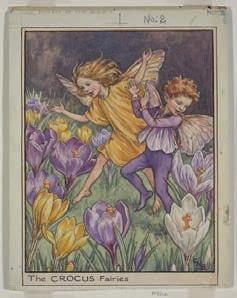
Below right Cicely Mary Barker (1895-1973), endpaper from e Book of the Flower Fairies, © the Estate of Cicely Mary Barker, 1927

3
to see in September
Right Costumes created in quarter scale by Vin Burnham for Frederick Warne & Co. Ltd alongside the Silver Birch Fairy from Flower Fairies of the Trees, © e Estate of Cicely Mary Barker, 1934

Left Richard Parkes Bonington (1802-1828), Venice, e Piazza San Marco, 1828, © e Trustees of the Wallace Collection

Below right Woolen curtain material made as a sample for the Royal Festival Hall competition in 1951, photo credit Sara Morris
Below far right Hilary Bourne and Barbara Allen, 1951
Below Fabric label for Hilary Bourne and Barbara Allen’s textile



2 Fairy dust
e work of Cicely Mary Barker (1895-1973), the illustrator who created the famous Flower Fairies, in the shape of ethereal, smiling children with butter y wings, is celebrated at a Liverpool museum. e Lady Lever Art Gallery is marking 100 years of Barker’s ethereal illustrations in a new exhibition Flower Fairies. As a child, Barker was in uenced by the works of the illustrator Kate Greenaway, but her principal in uence was the artwork of the Pre-Raphaelite Brotherhood. Te exhibition, which runs until November 5, features 45 original illustrat as well as early sketches and digital projections.
ANTIQUE COLLECTING 7
New venue
Tribal Art London (TAL), the largest event of its kind in the UK, has found a new home for next month’s event. Its 16th edition will take place in the mezzanine of a purpose-built pavilion in Battersea Park created for the popular Decorative Fair taking place from October 3-8. TAL fair director, Victoria Rogers, said: “TAL prides itself on being a close-knit community and the fair’s friendly atmosphere will suit us.” 15 dealers from around the world are set to take part in the event previously held at the Mall Galleries in London.
INDIAN TAKEAWAY
Two eighth-century stone Indian goddesses recovered from a British shed have been returned to India. Both statues, known as yoginis were looted from a temple in Lokhari, India in the late 1970s or early 1980s.


e pair was purchased in March by a UK-based salvage company from a woman who kept them in a shed at the back of her garden.
Christopher Marinello, founder of Art Recovery International, said: “ e idols came to light during due diligence, thanks to one of the brilliant art historians working with Art Recovery.”


Yoginis represent a group of powerful female divinities, associated with the Tantric mode of worship. ey are worshipped as a group, often 64, and are believed to possess in nite powers.
30 seconds with...
Matthew Lafite, the new head of silver and objects of vertu at the Moreton-inMarsh auction house Kinghams Auctioneers

How did you start in the business?
I fell into it. I have an interest in history which piqued my love of antiques. It really started at a Melbourne (my home town) antiques fair I was visiting with my parents, where I became intoxicated by a silver dealer’s stand. I later wrote to him asking if I could volunteer in return for his mentorship. I worked with him for years, until starting on my own after he retired.
Light show
Lumiere, the UK’s light art biennial, has revealed the ve artists who will showcase their work at this year’s event in Durham from November 16-19. For four nights the city will be transformed into a nocturnal art experience with light installations by the contemporary Chinese artist Ai Weiwei, Mexican-Canadian electronic artist Rafael Lozano-Hemmer, Liverpool artist Chila Burman, the artist and designer Olayinka Ilori and the Spanish photographer Daniel Canogar.
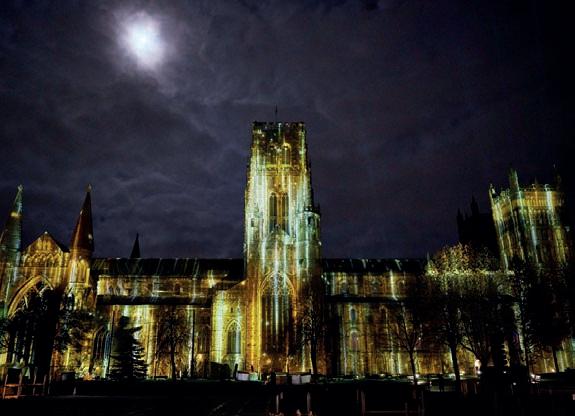
Lumiere which debuted 14 years ago is the UK’s rst light art biennial, with this year’s event set to include 35 artworks made with light exhibited on buildings, streets and waterways.
How does the UK antiques world compare to that of Australia?
The UK antiques world is Australia times a thousand! Australians are intrigued by antiques. Our televisions are full of UK antiques-related programmes. I would say the key difference is the UK really is the world centre for so many specialisms. My field, for example, is silver, and the UK (especially London) is the place to be. The history and expertise in the UK is unrivalled.
What has been your greatest ‘find’?
I wouldn’t say that I have a single ‘grail’ item. But I do very much like discovering pieces that have been misdescribed. There are many anomalies attached to British silver hallmarking which can make a big difference to the collectability (and value) of


an object. For example, York silver is often confused for London hallmarked pieces. Far less silver was made and assayed at York, especially hollowware (items other than flatware, such as spoons, forks, etc.) so I always keep my eyes peeled.
Do you collect? If so, what?
One of the (many) lessons my mentor taught me, was if you want to be a good dealer, you cannot be a collector. Aside from silver, I am always on the look out for pieces to decorate my thatched stone cottage...art pottery by Pilkington, Lalique glass, or even a piece of Martin Brothersbut I may need to save my pennies!
Kinghams’ inaugural silver and objects of vertu sale is on September 8.

8 ANTIQUE COLLECTING NEWS All the latest
Below A ceremonial headdress made from the dyed feathers of an African grey parrot. Bamileke Culture, Cameroon on offer from Bryan Reeves
ago
Below A book shows the statue in situ at the temple in Lokhari
made Above In Our Hearts Blind Hope, Palma Studio, part of the 2021 event. Photo Matthew Andrews
Above e yogini Gomukhi (the cowfaced one) has been returned to India
Suits you
Fortnum & Mason has bought a rare fashion treasure designed by one of its most amboyant couturiers for its archive.

e chi on tea dress was the work of Neil “Bunny” Roger (19111997), the couturier, socialite and dandy who sported a bowler hat, rouged cheeks, frock coat and spats. e dress, which had been found in a charity shop, was sold by the Surrey auctioneers Ewbank’s for £390.
Made in Chelsea
18th-century botanical porcelain made by Chelsea porcelain – the first English porcelain factory – is the inspiration for a new line of gardening accessories from the Royal Collection Trust.
Featuring traditional florals, insects, fruits and vegetables. Chelsea porcelain was collected by Charles III’s grandmother, the Queen Mother, with many pieces on show in the morning room at Clarence House in London.
The Chelsea Garden range consists of gardening gloves, a gardening tool belt, and a gardening tool gift set including a trowel, fork and transplanter.

View to a killing
Bonhams is to sell the personal collection of Sir Roger Moore (19272017), the seven times Bond actor. e sale, on October 4, marks the 50th anniversary of Sir Roger’s rst appearance as 007.

SALTO OF THE EARTH
Artist and author Edmund de Waal is curating an exhibition of pots by the acclaimed Danish ceramicist Axel Salto (1889-1961), considered by many as one of the greatest 20th-century ceramists.

The exhibition is set to open in Denmark next month before coming to The Hepworth Wakefield, West Yorkshire, in 2025. Born in Copenhagen in 1889, Salto studied at the Royal Danish Academy of Fine Arts where he became intrigued by modernism and a progressive aesthetic, which led him to travel to Paris where he met Picasso and Matisse.
An accomplished poet and author,
Hop to it

Salto also founded the influential Danish art journal Klingen (The Blade), a forum for critical thinking.

e 180-lot auction includes the famous all-white ski suit Moore donned in his nal lm for the series, A View to a Kill in 1985. e snow suit, which has an estimate of £15,000-£25,000, was also worn by the veteran actor during personal adventures, including skiing near his home in Switzerland.
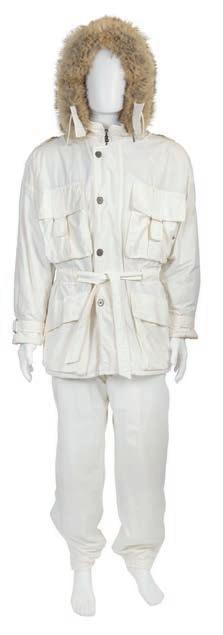
Other items on sale include Moore’s Gucci contact book and an Omega 007 Seamaster, which has a guide price of £20,000-£30,000. Photographs and lm stills will also be on sale
Sotheby’s New York celebrated a musical milestone at a special auction marking 50 years since the birth of hip-hop. August 11, 1973 was the rst time Jamaican-born DJ Clive Campbell, aka DJ Kool Herc, broke new ground by spinning the same record on two turntables. Few realised it would spawn a billion-dollar phenomenon inspiring music, sports and fashion. e sale included a ruby and diamond ring worn by rapper Tupac Shakur who was murdered in 1996. Estimated to sell for up to $300,000 it sold for $1m making it the most expensive piece of hip-hop memorabilia ever sold at auction. Also on sale were several SP-1200s, hip-hop’s must-have piece of studio gear which combined a drum machine and sampler into a single piece of equipment.

ANTIQUE COLLECTING 9
Below Edmund de Waal with pots by the in uential Danish potter Axel Salto (1889-1961)
Left e dress was designed by Neil “Bunny” Rogers
Above e gardening gloves, priced £19.95, are inspired by designs from the Chelsea porcelain factory
Above A Bogner white ski suit worn by Moore in A View to a Kill, 1985, has an estimate of £15,000- £25,000
Above right A large black and white portrait photograph of Sir Roger Moore is expected to make £1,000- £1,500
Left Ice-T and Afrika Islam’s SP-1200 sampler, c. 1987-88, signed by Ice-T, with four discs
Right A Nike plimsoll known as ‘FLOM,’ standing for ‘For Love or Money,’ one of only 24 ever made is a collector’s holy grail
Your Let ters
Regarding the Lancaster exhibition, however disgraceful the events of nearly 300 years ago were, little publicity is given to modern-day slavery which is very much alive and well.
Roderic Mather, Skipton, North Yorkshire, by email

ank you for bringing the links between the world famous Lancaster furniture maker Gillows and the transatlantic slave trade to the fore. I think everyone will appreciate what a turbulent and contentious issue it is. As a Lancaster resident I would like to mention that a couple of years ago the Robert Gillow pub on Market Street changed its name to the Jailor’s Barrel after learning about the rm’s involvement in the deplorable activitiy. It was part of, what a statement called, “decolonising of Lancaster.” It was, in my opinion, a bold attempt to rewrite history’s wrongs.
Anonymous,
 Lancaster
Lancaster
is exhibition is part of a deeper and broader e ort to undermine the appreciation of artefacts produced when the transatlantic slave trade was in operation. Activists want to reframe these objects as capitalist products, forever tainted by their association with the slave trade. It’s not about righting the wrongs of the past, or setting the record straight, it is about conditioning the British public to view the material culture of their country as irredeemably racist.
Adrian Lawrence, by email


Our star letter receives a copy of British Designer Silver by John Andrew and Derek Styles worth £75. Write to us at Antique Collecting magazine, Riverside House, Dock Lane, Melton, Woodbridge, Suffolk, IP12 1PE or email magazine@ accartbooks.com

last month’s behind-the-scenes look


at the sale of Freddie Mercury’s personal collection and had to share memories of one of the best days of my life: being one of the 70,000 people taking part in the Live Aid concert on July 13, 1985.

Take it from someone who was there on the day: Queen’s six-song performance not only stole the show, they were also the loudest act on the bill after –allegedly – their sound engineer ddled with the mixing desk.
Left e Judges’ Lodgings, Lancaster, formerly a town house and now a museum, is hosting the exhibiton on Gillows and global trade

Above right Freddie and Elton at Live Aid, Wembley Stadium, London, 1985, © Nils Jorgensen/Richard Young/Shutterstock
Below Mahogany cutting in Honduras in the 19th century. Lithograph from Chaloner and Fleming, e Mahogany Tree, 1850

I’d queued overnight at my local concert venue to secure a £5 ticket for the show and, while I’d got soaked in line, it was worth every minute. When the crowd took part in Freddie’s “ay-oh” it was mesmerizing and a moment I will never forget.
e idea the 20th-century’s ultimate showman spent his quieter moments making tasselled shades for his Ti any lamps is all the more remarkable. What an incredible man.
Jessie Hughes, Luton, by email
The answers to the quiz on page 38
Q1 (b). The UK Post Office only first allowed postcards to be sent in Nov. 1899. Raphael Tuck & Sons immediately issued the first series. Q2 (c). Q3 (a). Especially 18th-century patterned tiles and pottery Q4 (b). 17th-century German drinking vessels with marks down to which the drinker could imbibe but no further. Q5 (c). He was especially known for his pâte-de-verre work. Q6 (d). Using a different colour, usually red. Q7 (a). Art with a distorted image when viewed normally, but not when viewed from the side, for instance. Q8 (d). Their sand-pictures were often used as table decorations and tourist mementoes of the island. Q9 (i) – (b), (ii) – (d), (iii) – (a), (iv) – (c). There were many floral codes, often contradictory. These associations are taken from Dr. D. G. Hessayon The Armchair Book of the Garden (1983). Q10 (c).
The words reliable cog could be rearranged to make the phrase cabriole leg; the words fetal war could be rearranged to form the word flatware; the words equip pal could be rearranged to make the word applique and gaslit pesterer can be rearranged to make the words register plates
Have
say 10 ANTIQUE COLLECTING
LETTERS
your
Star letter
Last month’s feature on an exhibition linking the furniture maker Gillows to the slave trade sparked a number of letters, along with memories of the rock band Queen to and
Signature










ASIAN ART
® Auction
21
Large and Fine Chinese Carved Celadon and Russet Jade Liu Hai Boulder, 18th/19th century
$30,000 - $50,000
All Lots and Bid at HA.com/8138
Moyun Niu 牛默耘 +1.310.492.8659 | MoyunN@HA.com Charlene Wang 王璁瓏 +1.212.486.3731 | CharleneW@HA.com
| September
A
Estimate:
View
Inquiries:
FORTHCOMING AUCTIONS JEWELLERY, WATCHES & SILVER THURSDAY 24 TH AUGUST | THURSDAY 21 ST SEPTEMBER FINE ART & ANTIQUES THURSDAY 31 ST AUGUST | THURSDAY 28 TH SEPTEMBER A rare silver-cased Atmos clock by Christopher Nigel Lawrence for Jaeger LeCoultre Sold for £13,000 WWW.DAWSONSAUCTIONS.CO.UK ALL ENQUIRIES: 0207 431 9445 | info@dawsonsauctions.co.uk Liberty & Co, Arts & Crafts Cymric silver bowl. Sold for £6,400 COTSWOLD AUCTIONEERS & VALUERS SPECIALISTS IN SINGLE-OWNER COLLECTIONS NATIONWIDE VALUATIONS & ADVICE Jewellery | Watches | Silver | Ceramics | Glass | Decorative Arts Paintings | Furniture | Clocks | Design | Books | Designer Goods 10-12 Cotswold Business Village, London Road, Moreton-in-Marsh, GL56 0JQ 01608 695695 adrian@kinghamsauctioneers.com www.kinghamsauctioneers.com ANTIQUE COLLECTING 11
Paul R. Minshull #16591. BP 15-25%; see HA.com. Licensed by the City of New York #1364738/9-DCA73400
A ROUND the HOUSES
Mallams, Oxford
A miniature portrait by the engraver and convicted felon Edmund Edgar (1804-1854) who was deported to Australia in 1826 sold for seven times its low estimate of £1,000 when it fetched £7,200.

Edgar was arrested in Marylebone in 1825 with a swagbag of silver, watches and jewellery.
Soon after his arrival in the antipodes, he took up work with the artist Augustus Earle (1793–1838) and after being pardoned in 1844, continued to paint miniatures. Mallams’ Rupert Fogden said: “Most works by Edgar are in institutional collections in Australia and very rarely come up for sale.” e minature is set to return to New South Wales where it was painted.
The stuffed perch had a label for the well-known maker
Also at the auction house’s Abingdon saleroom four early 20th-century stu ed sh in bow-fronted cases, consisting of a perch, chubb and two trout, sold for £900, three times their low £300 estimate.
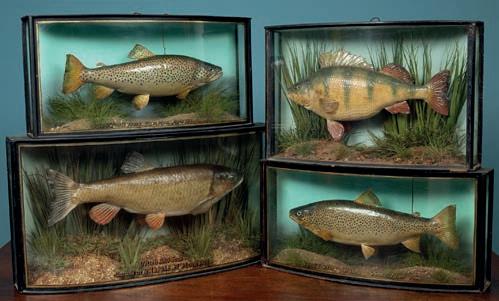
Elmwood’s, Mayfair
Seven Kashmir sapphires shone at the London auction house’s recent important jewels sale, with bidders from around the world pushing them well beyond their pre-sale estimate of £70,000 to reach £320,000.

Kashmir sapphires hold an almost legendary status, due to their intense corn ower colour, velvety texture and extreme rarity. e gemstones were discovered in remote almost inaccessible part of the Himalayas in the 1880s following a landslide, after which the local maharajah purchased the mine they were found in. It was active for just ve years, from 1882 until the supply ran out 1887. e sapphires’ scarcity and quality adds to their collectability.
Elmwood’s director, Samuel Hill, said: “ e result shows the unwavering strength of the market for important and rare coloured stones, even in these uncertain times.” In 2019, a necklace featuring 21 Kashmir sapphires sold for nearly $14.9m.
Clarke and Simpson, Campsea Ash
An early 18th-century London Delft apothecary’s jar, expected to make £250-£350, sold for £2,700 at the Su olk auction house’s recent sale.

From the middle of the 17th century, designs on such jars include a cartouche (label) with a Latin abbreviation indicating the jar’s contents.
e word “Mithridat” comes from the Greek ruler Mithridates (c.135–63 BC) who claimed to have developed immunity to poisons by regularly taking small doses of a drug.
e dry potion was made from more than 50 ingredients, including myrrh, sa ron, frankincense and opium, it was used as an antidote to poisons and venoms, as well as a treatment for a range of ailments, including ulcers, deafness, blindness, atulence, and infertility.
AUCTION Sales round up 12 ANTIQUE COLLECTING
From a fresh-to-market Egyptian co n to a “paranormal” rocking horse, the UK’s salerooms continued to delight bidders over the summer
The rare Kashmir sapphires delighted bidders in the London sale
The 18th-century drug jar sold for £2,700
The miniature was by the convicted felon Edmund Edgar (18041854)
J. Cooper & Sons
Tennants, Leyburn
A chalcedony, sapphire and diamond ower brooch, by the renowned French jeweller Suzanne Belperron (1900-1983), expected to make £5,000-£6,000, sold for £38,000 at the North Yorkshire saleroom’s recent sale.

Belperron began her career in jewellery design in 1919 at the House of René Boivin, the famed Parisian jewellers, before leaving to become the chief designer at Bernard Herz in 1932.
She pioneered the use of semi-precious materials such as agate, rock crystal and the chalcedony and never signed her pieces, famously saying “my style is my signature”’
Canterbury Auction Galleries
A “paranormal” antique rocking horse used in seances galloped past its pre-sale estimate of £200-£350 when it sold at the Kent auctioneer’s recent sale for a spirited £1,750 to a museum of the occult in Las Vegas. e horse had been used by the Folkstone medium

Dick Godden in the 1970s to conjure up the spirit of a young girl called Angela.
Since then the dapple grey mare possibly made by Lines in the early 20th century, had been kept in the family who for years had been spooked by its eerie equine presence.
Family legend claimed the rocking horse moved from room to room on its own.
Roseberys, London
An angular slab vase by the ceramicist Jacqueline Poncelet (b.1947), a student of Hans Coper, sold for £2,600, beating its guide price of £800-£1,200 at the auction house’s recent sale.
Belgian-born Poncelet was part of a group of radical female artists (along with Elizabeth Fritsch, Carol McNicoll, Jill Crowley, Glenys Barton and Alison Britton) who graduated from the Royal College of Art in the early 1970s laying the foundations for e New Ceramics movement which sought to re-establish the vessel as an abstract form.
Ceramic works by Poncelet are held at various public collections worldwide, including MOMA in New York, the V&A, and Tate Gallery London.
Cotswold Auction Company, Cirencester

A rare late 19th-century papier-mâché bulldog, thought to be by the French automaton company Roullet and Decamps, sold for £850 at the Gloucestershire auctioneers, nipping past its estimate of £300-£500.

Toy French bulldogs, known colloquially as ‘growlers’ because of their growling mechanism, were originally created in France in the 1890s, and included a hair collar, similar to the real ones the breed wore to stop them getting their heads stuck in the openings to badgers’ dens.
French bulldogs were hugely popular in high society during the early 20th century, in both France and the UK, and a variety of decorative items were produced celebrating the breed, including music boxes, porcelain gurines – even cuckoo clocks.
Bonhams, London
A rare Egyptian painted wooden co n sold for £406,800 at the London auction house’s recent antiquities sale, leaving its pre-sale guide price of £80,000-£120,000 for dead.

e elaborately decorated co n, made for the lady Irtwrw (c. 747-525 BC), was described as “the best example of an Egyptian anthropoid co n that we have had at Bonhams”. Head of antiquities, Francesca Hickin, said: “Egyptian painted wood co ns, complete with their full lid and back, rarely come up for auction.”
e dead woman’s name appears on the co n in a scene showing her lying on a funeral bed, while being tended by the jackal headed god of mummi cation, Anubis. Osiris, the god of the underworld is depicted, along with his wife Isis and the four sons of Horus.
From the Bodo Bless collection of Egyptian antiquities, it was the rst time the co n had appeared on the market since it was acquired in 1965.
ANTIQUE COLLECTING 13
The haunted rocking horse sold to an American museum of the occult
The Egyptian coffin dated from the 25th26th Dynasty, and was 173cm in length
The large (26cm high) slab-built piece was acquired direct from the artist in 1977
The striking flower brooch sold for multiple times its estimate
The growler was made by the French automaton company Roullet and Decamps
AUCTION Sales round up
Lawrences, Crewkerne
Obrad Nicolitch (1898–1976) designed the poster, one of a pair, which hammered at £2,400
A silver presentation centrepiece of the Duke of Wellington astride his horse Copenhagen sold for more than £32,000, more than 10 times its low estimate of £3,000, at the Somerset auctioneer’s recent sale. It was by the British sculptor Edmund Cotterill (1794-1860), head of design at R & S Garrard & Co. in London, who established the company’s reputation for high-end centrepieces. Lawrences’ Richard Kay, said: “ e combination of Garrards’ name, Cotterill’s skills, Wellington’s renown, unbroken provenance and superb condition proved irresistible to bidders.”
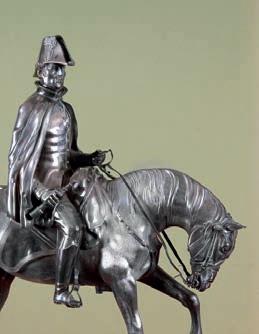
The eye-catching piece was almost 65cm (25½in) high on its base and weighed 59 ounces
At the same sale two vintage posters depicting women golfers by the French designer Obrad Nicolitch (1898–1976) de ed their pre-sale guide price of £100-£150 to sell for £2,400.
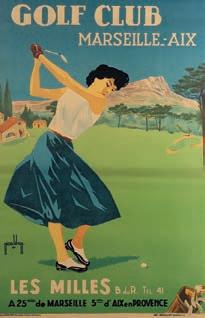
Hansons, Etwall
A tin of coronation chocolates more than a century old sparked a bidding war between India, the US and Spain, at the Derbyshire auction house, before selling for £1,000 – 10 times its low estimate.
Chiswick Auctions, London
Four giant shop display models of classic Leica cameras sold for a total of £23,000 at the London auctioneer’s recent photographica sale.
e quartet of painted wood models, each around 2ft (60cm) across were made in the 1950s for use at trade fairs, exhibitions, or at retailers to help publicise the release of new models.
Created with an almost obsessional attention to detail, the replicas had textured Rexine coverings, hand-painted dials, branding, trim and even transparent ‘lenses’ – each a feature of the original cameras. e range included a model of a 1934 Leica 250 Reporter camera, a 1950 Leica IIIf, a 1954 Leica M3 and a 1932 Leica III range nder camera.

The vanilla chocolates sold for 10 times their low estimate
e Cadbury’s vanilla chocolates, commemorating the coronation of Edward VII and Queen Alexandra on June 26, 1902, had been given to nine-year-old Mary Ann Blackmore by her Durham school. ey were consigned by her granddaughter who said generations of self-restraint meant the tin’s contents remained intact.

Auctioneer Charles Hanson, said: “We had a crazy amount of interest in this century-old chocolate. Emails were coming in from all over the world. It’s an astonishing result.”
Cadbury’s dairy milk chocolate was not introduced until 1905, meaning the chocolates in the tin were vanilla.
Zinaida Serebriakova (1884-1967), depiction of the young actor sold for €76,200


Sotheby’s Paris
Dozens of pieces from the private collection of Oscar-winning actor, playwright, and raconteur Sir Peter Ustinov (1921-2004) sold well at the French auction house’s recent sale. Annotated scripts for Spartacus, directed by Stanley Kubrick in 1960 in which Ustinov played the slave trader Lentulus Batiatus, sold for €5,080, some 10 times their low estimate of €500. More poignant lots came from Ustinov’s mother the artist Nadia Benois (1896-1975). Her portrait Young Woman in a Dotted Blouse, expected to make €1,000€1,500, sold for €1,651. A portrait of the actor as a boy by the Russian artist Zinaida Serebriakova (1884-1967), one of Ustinov’s relatives, estimated at €15,000-€20,000 it sold for €76,200.

14 ANTIQUE COLLECTING
A portrait of a young woman by Nadia Benois (18961975) sold for €1,651
One of the giant Leica cameras which sold for their midestimate price at the London auctioneers
The script for Spartacus directed by Stanley Kubrick in 1960 sold for €5,080

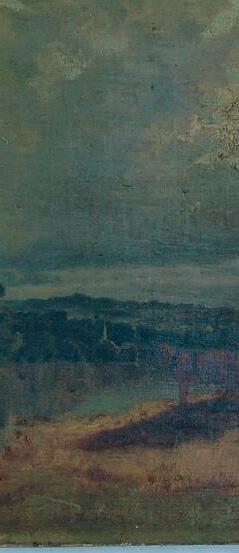










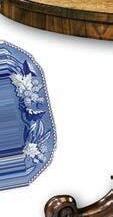

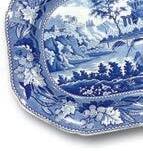






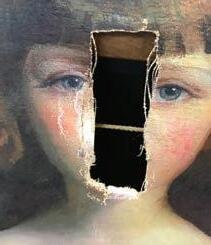
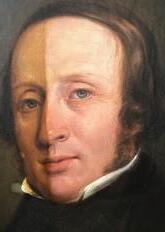

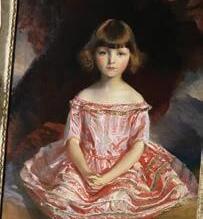





ANTIQUE COLLECTING 15 fineart-restoration.co.uk ati n i e e ti n an e i er er i e erien e n er at r , in u in a re ite nta t u f r ur free n iti n a rai a n er ati n f fine art, furniture an e rati e e t Treasures like yours belong on eBay List your art & antiques in our new collectables category. For more information, scan the QR code Amy Kent Senior Category Manager, Art & Antiques UKCollectables@ebay.com
Waxing lyrical
maker omas Chippendale.
Although for the past seven decades Harvey’s has become well known for pieces dating from between about 1680 and 1840, when my father started the company back in 1951 it was selling Victorian and Edwardian furniture to dealers all over Europe.

So I know, like me, he would have been unable to walk away from this irresistible pair of late 19th-century console tables which are of the very nest quality of design, materials and craftsmanship.

e colour and grain are of the rarest type, with the satinwood having the most exciting guring I have seen in years. It is a reminder some Victorian pieces are as worthy of praise as those by earlier makers. While the date is later, the consoles have much in common with the work of celebrated London cabinetmakers Ince and Mayhew a century earlier.
Ince and Mayhew
e partnership of William Ince (1737–1804) and John Mayhew (1736–1811) ran from 1758 to 1804 and was one of the most enduring collaborations in Georgian London’s tight-knit cabinetmaking community.
e partners’ clientele was probably larger, and their work arguably more in uential over a longer period, than most other leading metropolitan makers – perhaps even than that of their older contemporary, the celebrated
Above e neo-classical console tables are of the nest quality, design and craftsmanship
Above right With its swags and anthemions, the console’s top is clearly in the neoclassical style of Ince and Mayhew
Right e Wright & Mans eld cabinet dates from the second half of the 19th century
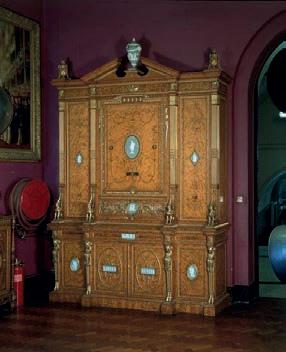

In some key areas, namely marquetry decoration and popularising painted furniture, Ince and Mayhew led fashion. ey worked closely with Robert Adam, most notably for Sir John Gri n at Audley End in 1767, for the Duchess of Northumberland in 1771, for the Earl of Kerry in 1771 and, most importantly, for the Duchess of Manchester in 1775, creating the Kimbolton cabinet.

Neo-classical revival
A century later from designs of Ince and Mayhew, we come to the work of the London makers Wright and Mans eld – one of the most prominent Victorian furniture makers in England and responsible for the very nest pieces in the Adam and Sheraton revival style. Geo rey Beard’s 1992 book,
e Work of Robert Adam, writes: “A rm revival of interest in Adam’s work did not really begin until 1867, when Wright and Mans eld, a London rm of cabinetmakers, won
16 ANTIQUE COLLECTING EXPERT COMMENT David Harvey
David Harvey discovers imitation is the nest form of attery when it comes to a ne Victorian interpretation of a pair of neo-classical consoles
the highest honours at the Paris Exhibition for a superb Adam-style cabinet.”

Established at 184 New Bond Street between 1860 and 1886, Wright and Mans eld were described in volume two of the 1880 edition of e Cabinet Maker and Art Furnisher, as “... the leaders of that pleasing fashion which was happily brought back into our houses many of the charming shapes of the renowned 18th-century cabinetmakers.”
A much more recent book by Hugh Roberts and Christie’s international deputy chairman, Charles Cator, (who trawled private family archives, county record o ces and bank archives to identify work by the pair) Industry and Ingenuity: e partnership of William Ince and John Mayhew, has proved a valuable source of information.
Swagged husk chains
It is widely accepted that Wright and Mans eld both admired and copied pieces made by Ince and Mayhew in the neo-classical style a century earlier.
When we look at the tops of this pair of consoles in question (below), the similarity is striking. We see much of the iconography of Ince and Mayhew, including the elliptical tops with a central fan sunburst and classical urns alongside swagged husk chains held by gri ns. e square tapering legs are also typically neoclassical in style.
Right e Kimbolton cabinet made by Ince and Mayhew is a clear example of the neoclassic style
Below left Ince and Mayhew’s iconography can be seen on the top of the commodes
Below Ince and Mayhew’s designs for a demilune commode for the Countess of Derbyshire
Below right Wright and Mans eld’s version of the same piece
Adam and the neo-classical
Much has been written about the neo-classical period of the 18th century, on which the consoles are based. The greatest proponent of the style was the architect and designer Robert Adam who, with his brother James, moved taste from the mid-century rococo, gothic and Chinese style towards the iconography seen in their projects from Harewood House in west Yorkshire to Osterley House in west London.
For the first time the interior and exterior of a house were designed as complementary and the carpets, walls and ceilings were also designed in harmony.
Furniture also reflected the new taste, none more so than in the Kimbolton cabinet, designed by Adam, and made by Ince and Mayhew for the Duchess of Manchester in the 1770s. Mounted on the cabinet are 11 pietra dura panels showing romantic seascapes and mountainous pastoral scenes.
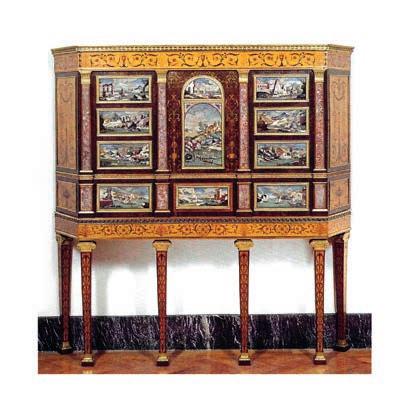
ere are many illustrations which illustrate Wright and Mans eld’s obvious admiration for the works of Ince and Mayhew, but possibly the clearest example is their copy of the demilune commode (below right) based on the demilune commode Ince and Mayhew created (to Adam’s design) for the Countess of Derbyshire in November 1775.
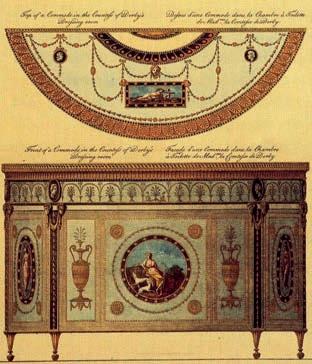
Plans for the original design show how the earlier makers combined strongly contrasting, richly-engraved satinwood and harewood marquetry in an ‘Etruscan’ taste with painted panels and giltbronze mounts. I have shown both the original design and a copy by Wright and Mans eld.

It has been a privilege to acquire this outstanding example of Victorian craftsmanship and I look forward to carrying out further research on this brilliant pair of tables. e foresight of the V&A in London in acquiring a selection of Wright and Mans eld pieces will be appreciated for generations to come and I would like to thank colleagues for their research in articles for the Furniture History Society and other publications.
David Harvey is the owner of Witney-based W R Harvey & Co. (Antiques) Ltd. For more details go to the website www.wrharvey.com
ANTIQUE COLLECTING 17
‘It is widely accepted that Wright and Mansfield both admired and copied pieces made by Ince and Mayhew in the neo-classical style a century earlier. When we look at the tops of the pair of consoles in question, the similarity is striking with so many points of comparison’
Life of Spy
Antique Collecting goes undercover at the new spying exhibition at the Imperial War Museum discovering some of the more ingenious gadgets and the endish minds behind them - and what they mean for collectors
From the Trojan Horse to the cracking of the Enigma Code, espionage has played a key role in war and protecting the interests of nations around the globe. It was the Chinese military strategist Sun Tzu’s e Art of War in the 5th century BC which rst included tactics for intelligence gathering, while Niccolò Machiavelli stressed the signi cance of intelligence gathering in his works, advocating secretive measures to maintain political power.
In the 20th century, two global con icts and the subsequent tensions between the superpowers sparking the Cold War, saw the founding of intelligence agencies across the globe, including the British Secret Intelligence Service (MI6) in 1909, the Soviet Union’s KGB in 1954, and the American Central Intelligence Agency (CIA) in 1947. Both wars saw signi cant espionage activities, with intelligence agencies playing crucial roles in gathering information, executing covert operations, and countering enemy spies.
Above Russian troops photographed by a member of the littleknown intelligence organisation British Commanders’-in-Chief Mission (BRIXMIX). Operating from 1946 to 1990, BRIXMIS gathered valuable military intelligence on potential threats to the West ©

IWM
Right Tree sketch by artist G.C. Léon Underwood (1890-1975). Underwood’s sketches were used to create hidden observation posts that were exact copies of real trees in the trenches © IWM
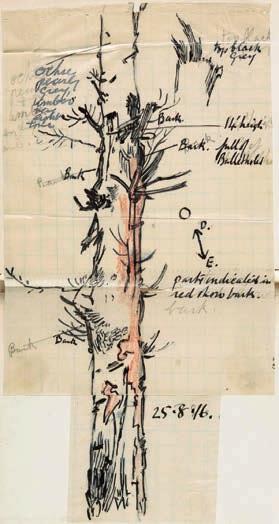
Today’s digital technology has seen the rise in cyber espionage, with state-sponsored and non-state actors conducting cyber-espionage to gather intelligence and carry out attacks. is month the Imperial War Museum (IWM) in London explores the tricks, tools and elaborate plots at the heart of the secret world of spying and deception. From the battle elds of WWI, to the betrayals of double agent Kim Philby and the recent Salisbury poisonings, Spies, Lies and Deception, from September 29 to April 2024, features more than 25 of the most intriguing, inspiring and shocking stories of the last century.
Trees of life
e outbreak of both world wars called on the skills of many - not least (as can be seen in the article on page 24) those of British artists. Not only were their talents required as war artists to document the con ict, their knowledge of colour and ability to sketch were in demand by the camou age department, part of the Royal Engineers.
One of the more unusual uses of concealment was adopted in WWI and involved the unlikely subject of
18 ANTIQUE COLLECTING
THE EXPERT COLLECTOR Spy ware
a camou aged tree. e fake trees, designed to hide observation posts and snipers, were the brainchild of two men: Solomon J. Solomon (1860- 1927), a British artist whose family was Jewish, and Bernard S. Fowler, an o cer in the Royal Engineers.
By the outbreak of WWI Solomon was already an accomplished painter, having studied at various art schools, including École des Beaux-Arts, and was a member of the Royal Academy. In 1886, he became one of the founding members of the New English Art Club.
e camou age tree, sometimes referred to as “Solomon’s trees,” were highly valuable in areas where troops were locked in trench warfare and needed to track enemy movements without being seen.
To build the trees, a military artist would rst choose a tree to sketch in no man’s land. After plans were drawn up, a hollow metal cylinder would be shrouded in branches and foliage attached using chicken wire. e rst British tree observation post was put up on 22 March, 1916.
One of the men working with Solomon was the west London-born George Claude Leon Underwood (18901975), an artist, sculptor and printmaker one of whose tree sketches (below left) appears in this month’s exhibition. His 1919 oil painting Erecting a Camou age Tree (above) was purchased by the Imperial War Museum.
e world of espionage was a small one. Solomon’s daughter, Iris, went on to marry Ewen Montagu, one of the brains behind Operation Mincemeat in WWII, a project described later in the article.
Stalking heads
As well as fake trees, the trenches were home to a number of papier-mâché dummy heads designed to draw out enemy snipers. e Germans were the rst nation to use snipers, with the British infantry having no way of detecting them without looking over the trenches and
Left G.C. Léon Underwood (1890-1975) Erecting a Camou age Tree, oil, 1919, public domain

Right Women making papier-mâché dummy heads in France during WWI. ese were used in the trenches to draw enemy re and thus locate enemy snipers, © IWM

Below right A papiermâché dummy head, image public domain, not in exhibition
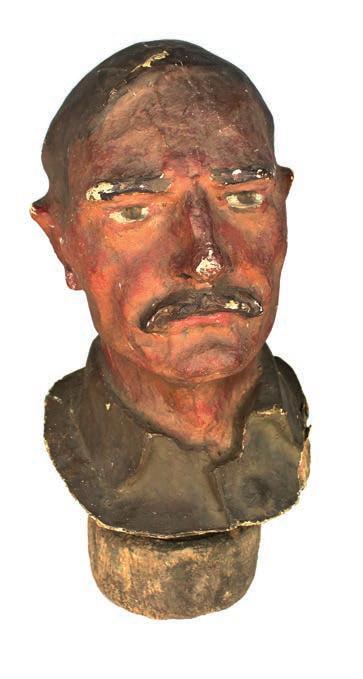
Below Solomon J. Solomon (1860- 1927), self portrait, the artist who was credited with inventing the camou age tree. His daughter Iris was married to Ewen Montagu, one of the brains behind Operation Mincemeat

risking their lives. By the end of 1915, the German sniper dominated the battle eld, in icting countless British fatalities, and severely weakening morale.
To counter the attacks fake heads were raised above the parapet with the attacking bullets’ entry and exit holes examined to work out the exact line of re and the sniper’s position.
Major H. HeskethPrichard wrote in his 1920 book Sniping in France: “In this way we found ourselves looking along the path of the bullet, only in the opposite direction to that in which it had come, and, in the optical centre of the two holes, would be seen the German sniper who had red the shot, or the post which concealed him.”
Such was the accuracy sought by the camou age makers some dummies even had a cigarette in its mouth, smoked through a rubber tube. French troops expanded on the idea of dummy heads to make a papier-mâché horse carcass, which they were able to hide in for three days, watching and killing enemy troops.
Making Mincemeat
e exhibition also pays homage to Operation Mincemeat, one of the most audacious, and successful, deception operations of WWII. It’s objective was to dupe Germany into thinking the Allies were about to launch an invasion of Sardinia and Greece, rather than the actual target, which was the island of Sicily.
Ewen Montagu an intelligence o cer at MI5, hit upon the plan of disguising the body of a deceased Welsh vagrant as that of Acting Major William Martin RM. Attached to the body was a briefcase containing a

ANTIQUE COLLECTING 19
‘One of the more unusual uses of concealment was adopted in WWI and involved the unlikely subject of a camouflaged tree. The fake trees, designed to hide observation posts and snipers, were the brainchild of two men’
THE EXPERT COLLECTOR Spy ware
Left A sketch of Ewen Montagu by Sir Peter Markham Scott (19091989), image courtesy of Halls, not in exhibition
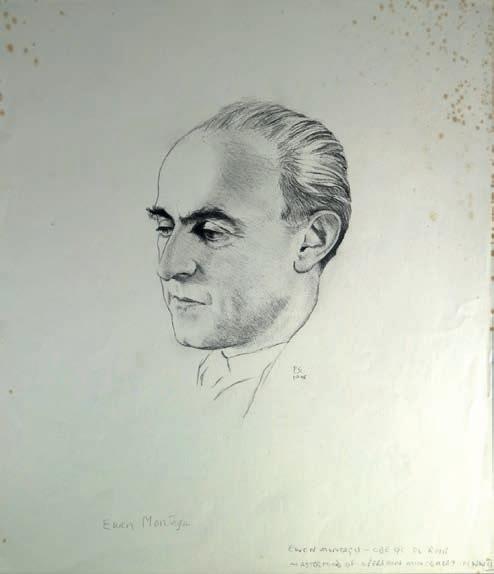
Below left A decoy ‘Most Secret’ message from Ewen Montagu to the naval attaché in Madrid asking him to recover papers of “great importance and secrecy” from the body of ‘Major Martin’, © IWM
Below right Dummy parachutists, known as “Ruperts”, were dropped from aircraft to draw German troops away from the D-Day beaches just before the landings © IWM
Love story
Following the war, the episode became a book by Ewen Montagu called e Man at Never Was and made into a lm. Such was the extent of the deception the dead captain’s back story included a girlfriend (Pam) and an overdraft letter from his bank along with a receipt for £53 (from the London jeweller S. J. Phillips) for an engagement ring.
Montagu explained in a later newspaper interview: “Every young o cer has some romantic attachment and ‘Major Martin’ had to have one. e chief event in his ‘life’ as we drew it for him was that he had recently met a charming girl called Pam. He carried a snap of her and two letters from her in his wallet.”
In 2020, the auction house Halls sold a 1948 portrait of Montagu by Sir Peter Markham Scott (1909-1989) –one of a group of ve – for £210.
Dummy decoy
Meet Rupert. His mission? Deceit. On D-Day in June 1944, the Allies dropped hundreds of burlap dummies stu ed with sand and straw across France, far from where the real paratroopers were landing in Normandy.
collection of supposedly top secret papers outlining the allies’ plans for the false invasion.

e body, dressed in uniform battledress, was loaded into a canister of dry ice and put aboard HMS Seraph who subsequently placed it in the sea o Huelva in Spain (where there was a known German intelligence agent) to be discovered by a sherman.
It was assumed that “Acting Major Martin” had drowned following an air crash.
e body was then handed over to the British authorities in Spain for post-mortem and burial, followed later by the briefcase of documents, which had been secretly copied by the Germans who had swallowed the entire ction, directing valuable forces away from Sicily.
Given the codename Operation Titanic, paradummies were dropped to the south of where the two US airborne troops were landing, some to the south-west of Caen, and the remainder near Saint-Valery-enCaux (on the French coast, to the north-east of the real landings).
e paradummies were a third the size of a person although would have looked larger in the air. Some were tted with a timed detonator to ensure they exploded on landing, destroying evidence of the trick. is gave the illusion of a paratrooper burning his parachute.
Ruperts do occasionally pop up for auction. In 2017, an unused dummy found in the loft of a former soldier’s house on Merseyside sold at Adam Partridge Auctioneers in Liverpool for £2,500.
It was bought by the House on the Hill Museum in Stansted, Essex.

20 ANTIQUE COLLECTING
‘The paradummies were just a third the size of a person, the fakes—nicknamed “Rupert”— would have looked larger in the air. Some were fitted with a timed detonator to ensure they exploded on landing, destroying evidence of the trick. This gave the illusion of a paratrooper burning his parachute’
Special Operations Executive (SOE)
The SOE was a British covert organisation established in 1940. Its primary role was to conduct espionage, sabotage, and irregular warfare behind enemy lines in occupied Europe. It recruited agents from various backgrounds, including soldiers, civilians, and women. The SOE had various secret research and development laboratories, including Station IX at the Natural History Museum and Station XII at the Frythe Hotel in Hertfordshire.
The real “Q”
One of the SOE’s leading lights was Charles Fraser-Smith, later immortalised as “Q”, in the James Bond films. To his friends and family Fraser-Smith was a junior officer in the Ministry of Supply’s Clothing and Textile Department (Dept. CT6). But, in reality, the unsuspecting civil servant was developing gadgets and other equipment for section XV of the SOE in Borehamwood – one of 70 country houses around the UK taken over for covert operations in WWII.
Among the items he supplied were cigarette lighters containing miniature cameras, torches with one genuine battery and one dummy and shaving brushes where the bristles unscrewed to reveal a hidden compartment.
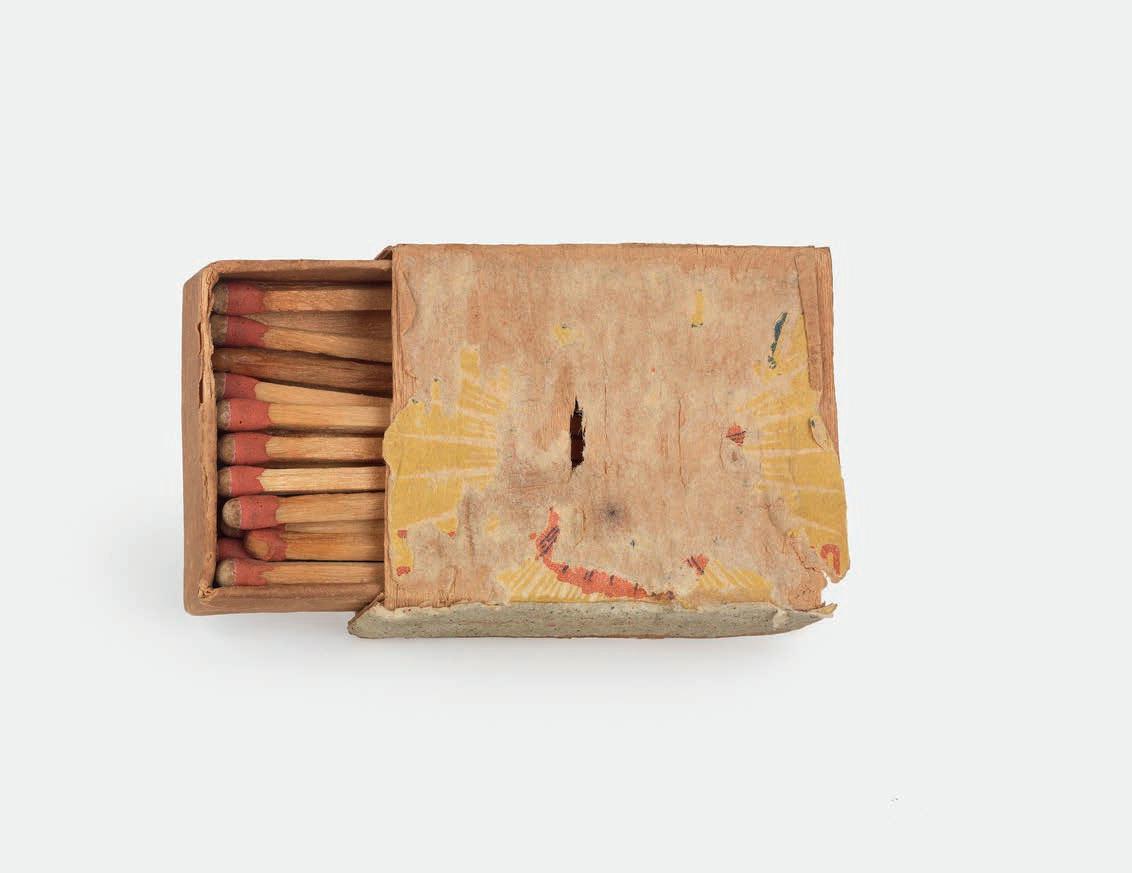
Other designs were more ingenious and included a match containing a magnetised needle that could be dropped in a puddle to form a compass. He was also tasked with providing a container 6ft 2in long by 3ft wide, to carry a ‘deadweight’ of 200lb, which was later revealed as the box used to transport the body of “Major Martin” in Operation Mincemeat.
When the dry ice evaporated, the trunk filled with carbon dioxide driving out the oxygen, and preserving the body with no need for refrigeration.
Fraser-Smith called his inventions “Q gadgets”, after the Q ships, warships disguised as freighters which were deployed in WWI. This may have been why Fleming named his character ‘Q’.
Gadgets at auction
The exhibition includes a box of matches with one match specially adapted for writing secret messages and a pair of footprint overshoes made by SOE and used in southeast Asia during WWII. The intention was to disguise the wearer’s real footprints making the discoverer think they were made by villagers rather than troops.


Battle-used examples of the SOE’s kit come to auction occasionally and cause huge excitement when they do. A dagger concealed
Top right A box of matches containing one match specially adapted for writing secret messages used during WWII, © IWM
Above right Hollow battery made during the 1960s for Secret Intelligence Service (SIS) to hide reels of miniature lm, © IWM

Right
Auctioneers in Ashford in Kent in 2017.
The dagger had been intended for use by a SOE operative to slash the tyres on an enemy vehicle, or in some cases kill.
A radio transmitter hidden in a suitcase realised £1,900 at the same auction. It had been used in Belgium during the 1939-1945 war.
ANTIQUE COLLECTING 21
Footprint overshoes like this were created for Special Operations Executive (SOE) agents operating in southeast Asia during WWII to disguise the wearer’s footprints, © IWM
‘Among the items he supplied were cigarette lighters containing miniature cameras, torches with one genuine batter y and one dummy and shaving brushes where the bristles unscrewed to reveal a hidden compartment’
FROM RUSSIA WITH LOVE
1 Smoking was endemic in Soviet Russia making a cigarette pack an ideal secret camera cover
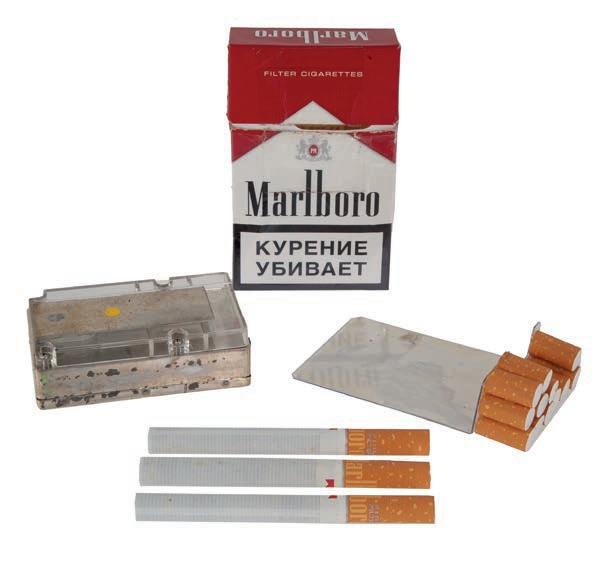
2 e camera click was disguised by a cough
3 A KGB photo demonstrates how the neck ties should be operated. e same tie would have been worn at a number of meetings

1A Russian FSB (Federalnaya Sluzhba Bezopasnosti, the successor of the KGB) spy pack of Marlboro brand cigarettes containing a hidden digital camera. e lens was operated through a small hole on the side. e Kiev Arsenal factory produced civilian cameras to order, copied from the ultrasmall Minox camera. Estimated to make $800-$1,200 at Julien Auction’s sale of Cold War relics in 2021, it sold for $11,500.
4 e rare ring camera demanded a steady hand
5 e shoe shine kit was an ideal way to brush up on spy craft
3A
Soviet KGB spy silk necktie with a hidden “Tochka-58” camera concealed with the use of a fake tie clip. Includes hand-activated shutter release mechanism. KGB agents on secret missions sported the same ties and fake pins, to accustomise the target. After the second or third time, the same tie would be worn but with a Tochka camera in it with a remote control in the pocket. Expected to make $2,000-$3,000, it sold for $8,750 at the same sale.

4A
rare gold-plated Soviet miniature camera designed to look like a ring. It includes a highde nition single-speed lens, single diaphragm and xed focusing. It was possible to make only one shot, so there was no margin for error, meaning the owner had to keep his hand rock steady. Estimated to make $6,000$8,000, it sold for $15,600 at the same sale.

5A
Soviet KGB spy shoe polish brush with a secret compartment, accessed by a safety pin in a small hole, concealing a Minox “Riga” miniature camera. Only the agent would know the exact location of the brush hole, meaning to everyone else it appeared an innocuous accessory. Expected to sell for $400-$600, it sold for $6,400 at the same sale.

2A
Soviet KGB spy belt designed to hold a hidden “Ajax” camera behind the buckle. e tiny holes in the buckle allow for a clear shot while a brief cough could hide the sound of a camera click. e belt features in e Secret History of KGB Spy Cameras by Melton, Alekseenko, Hasco, and Vreisleben (Schi er Publishing, 2018). Expected to make $400-$600, it sold for $3,750 at the same sale.
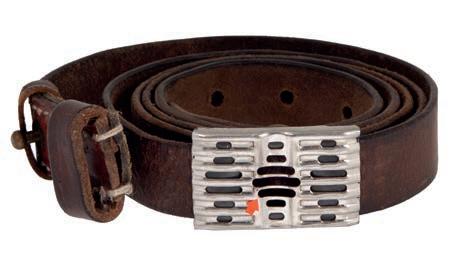
22 ANTIQUE COLLECTING COLLECTING GUIDE Spyware
For true spyware a cionados no one did it better than the KGB. From dinner plates to lipsticks, everything was fair game to the Soviet eavesdoppers. A recent US sale proved how popular the gadgets are among collectors
6A Soviet KGB spy cosmetic kit containing a hidden “Kiev-30” camera, with the lens operating through a small window on the side. It was built in Vilnius by KGB order. e Russian agent would use the kit to freshen up but at the same time manipulate the lipstick, or powder, to take undercover pictures of the targeted person. e next negative frame was reloaded by secretly pulling out the built-in clasp. Expected to make $600-$800, it sold for $22,400 at the same sale.

6 e cosmetic kit with a hidden camera was one of the auction’s top sellers

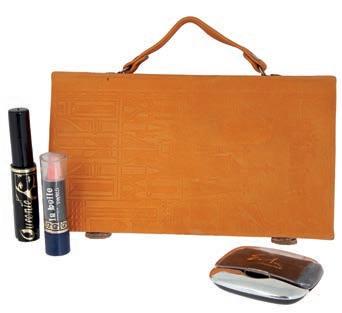
7 e wallet allowed live conversations to be broadcast
8 e KGB spy dinner plate concealed a listening device
9 Ashtrays allowed waitresses to place the listening device where they wanted
8Even tableware was adapted as listening devices. is Soviet KGB spy dinner plate contains a hidden microphone, demonstrating how “bugs” can be concealed in ordinary objects. It includes a matching bowl without microphone. Ideal for eavesdropping on ambassadorial dinners. Expected to sell for $500-$700, it sold for $2,880 at the same sale.


7A Russian FSB spy Justo Creazione brand wallet containing a hidden microphone. e wallet has no external attributes indicating that there is a bug in it. Secret conversations were broadcast on digital channels and combined with the multi- channel receiver MPK 040 A. Expected to sell for $500-$700, it sold for $2,560 at the same sale.
10 e tooth was designed so captured agents could take their own lives
10If all else failed and the operative was caught there was only one solution. KGB dentists made a cavity in a spy’s molar tooth to contain a fatal dose of potassium cyanide. If caught, the agent would break the head o the tooth with a strong bite releasing the poison, causing paralysis of the central nervous system and death. In this way the agent took his or her secrets to the grave. Expected to make $800$1,200, the deadly tooth sold for $7,680 at the same sale.
9Foreigners arriving in Moscow could only stay in ‘Intourist’ hotels, which were known to be highly surveilled with bugs in most of the rooms and all of the restaurants. After Western agents got wise to the listening devices, they demanded to choose their own tables. e KGB retaliated with bugged ashtrays which waitresses were able to move around the dining room at will. is example, expected to make $800-$1,200, sold for $12,800 at the same sale.

ANTIQUE COLLECTING 23
‘The Russian agent would use the kit to freshen up but at the same time manipulate the lipstick, or powder, to take undercover pictures of the targeted person’
Hidden talent
In WWII when the Admiralty commandeered Kingswood school near Bath, few could have guessed the pivotal role it would play in one of the most important turning points of the con ict.
Within its walls a top-secret team was brought together to oversee the nal designs for the Mulberry harbours, two giant oating pontoons designed to facilitate supply ships for the D-Day landings. An important component of the Kingswood operation was a small group of accomplished artists who made up the Admiralty camou age team.
e work undertaken by the men in the Bath unit was a far cry from their peacetime concerns. e team included the talented fashion illustrator Francis Marshall (1901-1980), known for his work with BritishVogue, and the well-known painter and book illustrator Leslie Atkinson (1911-2004).
But the name of the 56-year-old bespectacled artist heading the close-knit group is less well known. It was Graham Barry Clilverd (1883-1978) who, prior to the war had already exhibited at the Royal Academy, the Royal Society of British Artists, the Paris Salon and various international and provincial galleries.

Today, almost forgotten as a war artist, his life and works are long overdue a reappraisal.

Early days
Clilverd was born in London on April 6, 1883, the son of Ellen Mary and William John Clilverd, a bankers’ clerk.
24 ANTIQUE COLLECTING
A key player in WWII’s secret camou age unit, the work of the war artist Graham Barry Clilverd has long gone under the radar, until now.
John Ramm sets the record straight
COLLECTING GUIDES the war artist Graham Barry Clilverd
Above Graham Barry Clilverd (1883-1978) A Blackburn Skua, taking o from an aircraft carrier, image courtesy of Sim Fine Art
Left Graham Barry Clilverd (1883-1978) Nocturne, watercolour. Clilverd’s London views show the unmistakeable in uence of Whistler
His aptitude for drawing, as well as fencing – a sport he enjoyed long after he left - was evident at his south London grammar school.
After school he enrolled at the Central School of Arts and Crafts, established by London County Council in 1896 “to encourage the industrial application of decorative art”.
Many of the rst generation of the school’s tutors were drawn from the Art Workers’ Guild and their practicecentred approach marked a distinct break from the generally more prevalent drawing-based education o ered elsewhere.
Practical skills

Printmaking also took centre stage, as well as architectural history and draughtsmanship, which helped steer Clilverd towards architecturally precise etchings of buildings in Britain, Italy, France and Belgium. Almost all drypoints, they were exhibited at the Royal Academy between 1926 and 1947. ey were published in London by Jas. Connell & Sons in editions ranging from 60 to 150 impressions.
But Clilverd’s marriage in 1907 required a steadier income and the 1911 census describes the 27 year old as a life assurance clerk. Any hopes he had of making a good living from his art must have looked bleak as the dark clouds of the impending Great War began to loom.

Right e Admiralty camou age team in Bath. Clilverd, in spectacles is on the far left, with his colleagues Francis Marshall, Jim Mitchell and (far right) Leslie Atkinson. A poster of Atkinson’s cartoons relating to the Kingswood era has been superimposed on it. Image courtesy of Julia Gibson (née Atkinson)

Below left Graham
Barry Clilverd (18831978) Self-portrait. He is wearing a suit made of camou age material with a walking stick that serves as a folding chair. Image courtesy of Black Swan Books, Richmond, Virginia
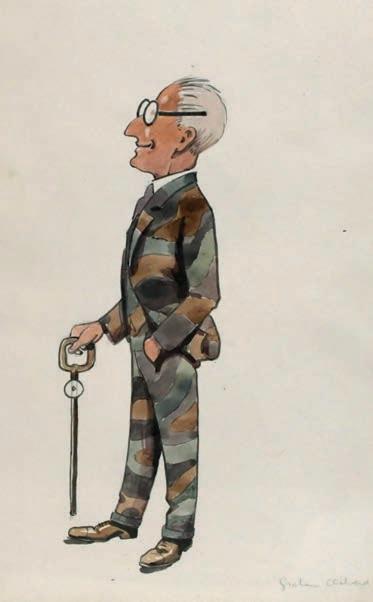
Below right Graham Barry Clilverd (18831978) Buoy Stall, Blackwall, watercolour, c.1918, image courtesy of Sim Fine Art

Bath Blitz
The two nights and three days of April 25-27, 1942, were probably the most harrowing in the city’s history. Bath was targeted in a series of reprisal raids by the Luftwaffe for Britain’s fire bombing of Lübeck. In Bath more than 400 people died and 19,000 buildings were damaged or destroyed, of which 218 were of architectural or historic importance.
War artists including John Piper (1903-1992) were sent to the city to paint the bomb damage while Clilverd’s team set to work immediately making records of the devastation.
Many of their sketches and paintings are now in the permanent collection of Bath’s Victoria Art Gallery. One of Clilverd’s finest shows the city’s ruined Regina Hotel, the morning after the Blitz.
‘A number of artists joined the team, including the fashion illustrator Francis Marshall (19011980) known for his work with BritishVogue and the well-known painter and book illustrator Leslie Atkinson (1911-2004). But the name of the 56-year-old bespectacled artist heading the close-knit team is less well known’
ANTIQUE COLLECTING 25
COLLECTING GUIDES the war artist Graham Barry Clilverd
Camou age section
When hostilities commenced Clilverd joined one of the British military’s four camou age sections. It was the French Army in 1915 that was the rst to create a dedicated camou age unit. e word camou age coming from the French verb meaning ‘to make up for the stage’ and its practitioners, many of whom were artists, were known as camou eurs.
e following year the British Army established its own camou age section, the rst of several, under the command of Lieutenant-Colonel Francis Wyatt which was known as the Special Works Park, RE (Royal Engineers).
Perhaps the most celebrated o shoot was the Dazzle Section, conceived and developed by the celebrated marine artist and then naval commander Norman Wilkinson (1878-1971).
Wilkinson used his web of personal connections to secure artists suited to the task with many drawn from the Central School of Arts and Crafts. In his autobiography Wilkinson reveals very little of the artists themselves but that they were often allocated to di erent UK ports as ‘Dazzle O cers’ to supervise the painting of ships.
One of Clilverd’s earliest known watercolours, Buoy Store, Blackwall, dates from this period and shows various types of navigational marker buoys, the di erent shapes (conical and spherical) having di erent meanings.
European travel
With the war over, Clilverd, who divorced in 1915, was able to dedicate himself to his art. Although he could paint sensitive watercolours with a hint of Whistler about them, he mostly produced detailed etchings of London buildings, especially the interiors of various Inns of Court, or else views of the English countryside with gypsy encampments or farm workers toiling with their horses.
He also took inspiration from trips abroad with On the Ponte Vecchio, Florence becoming his rst RA exhibit in 1926 and with Porta Romana, Florence, another drypoint, shown the following year. Italy was his preferred destination, especially the cities of Florence and Venice.

Below left Graham Barry Clilverd (1883-1978) On the Ponte Vecchio, Florence, drypoint.
e rst of 10 etchings Clilverd exhibited at the Royal Academy between 1926 and 1947, image courtesy of McTague of Harrogate
Below right Graham Barry Clilverd (18831978) Brunelleschi’s Christ, drypoint on cream laid paper. e wooden cruci x depicted hangs in the church of Santa Maria Novella in Florence, one of the artist’s favourite cities


However, the fact that he attended the 1932 annual general meeting of the Society for Nautical Research at the Royal Naval College, Greenwich suggests he was aware world peace was not something to be taken for granted.
By that time he had also married again, his new wife was named Winifred Love. Judging by a set of mixed media sketches showing stylish, black-stockinged women in four stages of undress, auctioned by Golding Young in September 2014, Clilverd had an appreciative eye for the female form.
e pair set up home at 73 Fellows Road, Hampstead, a comfortable house in a street that later su ered much damage during the Blitz.
Back in uniform
In 1939, aged 56, Clilverd re-enlisted as a captain in the Royal Engineers. His time as a WWI camou eur was to prove invaluable. e art of deception through camou age was a major thrust of England’s wartime defences and, by September 1941, along with 4,000 Admiralty sta and their families, Clilverd found himself heading the Camou age Unit in Bath.
Judging from a series of caricatures the artist made of people he worked with at this time, all from various walks of life, he had a ne sense of humour and a sharp eye for an individual’s quirks and idiosyncrasies.
Among a portfolio of 30 drawings is a wonderful self-portrait in which he sports a suit fashioned out of camou age material and brandishes a gentleman’s walking stick that doubles as a folding seat.
26 ANTIQUE COLLECTING
Peace time
e war over, Clilverd, now living with Winifred at 181 Adelaide Road, only a short walk from their previous address, continuedto devote much of his time to painting and print-making, e quality of his best work had earned him election as a Fellow of the Royal Society of Arts and, in the 1950s, he sold paintings at Harrods and John Lewis.
Many of his post-war compositions were still life paintings which seem rather tame and uninspired compared to his earlier work but one ne oil, Carousel, bought from John Lewis in the ‘50s and probably depicting a scene at the annual Easter fair on Hampstead Heath, is fresh, full of movement and colour, and shows a willingness to experiment.
Luton-based academic John Ramm has been researching and collecting work by Graham Barry Clilverd for many years.

Carousel, oil, a partial view of the Easter fair on Hampstead Heath, close to the artist’s home

Left Graham Barry Clilverd (1883-1978) Lincoln Inn Hall, drypoint. Clilverd’s accurate interiors of historic buildings are much prized by lovers of ne prints

Below left Graham Barry Clilverd (1883-1978) Gypsy Encampment, drypoint

Below right Graham Barry Clilverd (18831978) Feeding the Horses, watercolour
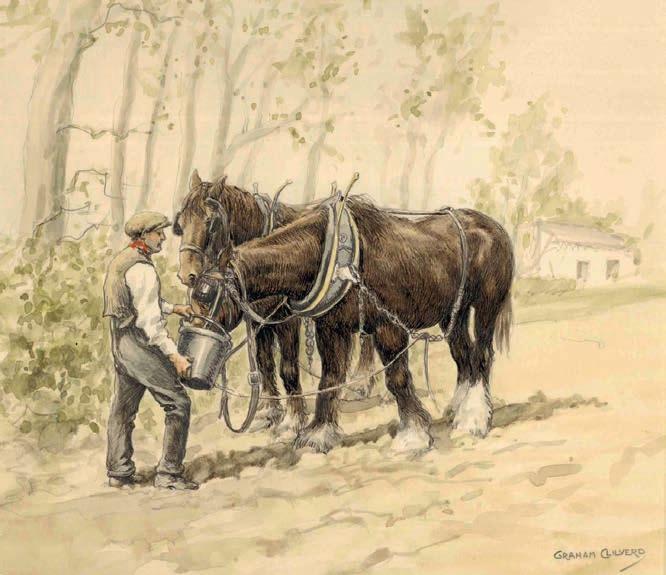
Collecting Clilverd
Works of the quality of Carousel can still be found for very affordable sums, often in the hundreds rather than thousands of pounds. His work presents a wonderful collecting opportunity for works by a remarkable artist. Even some of his finest etchings –which featured in periodicals like Fine Prints of the Year – can be bought for less than a hundred pounds.
When Clilverd died on the April 21, 1978, aged 95, only a short obituary appeared in the Daily Telegraph three days later. He had already slipped into an undeserved obscurity.
It can only be hoped that this brief review will reawaken a new interest in his life and works.
ANTIQUE COLLECTING 27
SALEROOM SPOTLIGHT
Few people knew that the real passion of Charlie Watts, the rock-steady centre of the Rolling Stones, in fact beat to a very di erent drum. When he died in 2021 aged 89, tributes dubbed him “one of the greatest drummers of his generation”, but away from the stage he harboured a much quieter passion – as a dedicated book collector.
His penchant was for 20th-century literature with a particular love for English whodunnits from the “golden age of crime” and the gentle humour of PG Wodehouse.
According to Paul Sexton, author of Watts’ biography, the drummer enjoyed reading both on the road with the band and in quieter nights in at his home
Above Watts (far left) with the rest of the Rolling Stones, © Rolling Stones

Below far left e Great Gatsby by F. Scott Fitzgerald, leads the sale with an estimate of £200,000-£300,000 at this month’s sale
Below left e book is inscribed on the inside front cover to “the original Gatsby”
4 A rst edition of F. Scott Fitzgerald’s Tender Is e Night, originally published in 1934, has an estimate of £200,000£300,000

5 e Dain Curse by Dashiell Hammett has an estimate of £25,000£35,000

6 Murder at the Vicarage by Agatha Christie, has a pre-sale guide price of £4,000-£6,000
1 e irteen Problems by Agatha Christie, has an estimate of £40,000-£60,000 at this month’s sale
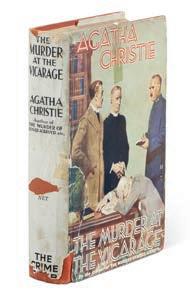

2 Carry on Jeeves by P.G. Wodehouse, is expected to make £4,000-£6,000

3 e Hound of the Baskervilles by Sir Arthur Conan Doyle has an estimate of £70,000-£100,000
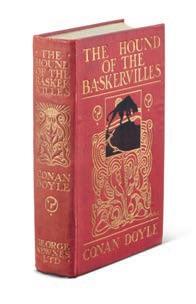
Now, two years after his death, his collection –representing the “best collection of modern rst editions to come to auction in over 20 years” – will be sold at two sales at Christie’s. e drummer’s collection of memorabila from the world of jazz - Watts’ greatest musical love – will also go under the hammer.
Sale highlights
Leading thelive sale will be an inscribed copy of e Great Gatsby by F. Scott Fitzgerald, expected to make £200,000£300,000, in which the author dedicated the book to MGM screenwriter Harold Goldman (whom he dubbed “the real Gatsby”). e inscription goes on to say: “With thanks for letting me reveal these secrets of his past.”

Also for sale is a proof copy ofEvelyn Waugh’s Brideshead Revisited, which the author sent to friends for their comments in 1944. Waugh later made several changes to the novel, including rewriting the ending and changing some of the names.

e rst edition of the Sherlock Holmes’ adventure Hound Of e Baskervilles is signed with the comment: “I perambulated Dartmoor beforeI wrote this book,” a reference to the book’s setting.
Long-time band member, Watts joined the Rolling Stones in 1963. Mick Jagger, who celebrated his 80th birthday inJuly, said: “Charlie was the heartbeat of the Rolling Stones for nearly 60 years, he was totally unique and devoted to jazz and literature from boyhood. He was the quintessential English gentleman and his absence is a great loss forus all. We miss him hugely.”
28 ANTIQUE COLLECTING
ANTIQUES UNDER THE HAMMER the Charlie Watts collection
As well as being the Rolling Stones’ drummer for 60 years, Charlie Watts had a passion for the quieter things in life, including book collecting and jazz memorabilia. His “once-in-a-lifetime” collection goes under the hammer this month
1 2 3 4 5 6
ALL THAT JAZZ
Watts’ passion for jazz underpinned his collection. In 1991 he formed the Charlie Watts Quintet, whose performances at Ronnie Scott’s were a highlight of his multifaceted career.
He admired all the greats including Billie Holliday, Duke Ellington and Benny Goodman.
But central to the collection is one man – his favourite saxophonist, Charlie Parker, one of the most important gures in the development of jazz, who pioneered bepop, but died tragically young at the age of 34.
Watts’ extensive collection of Parker’s possessions include the legendary saxophonist’s Associated Musicians membership card, as well as a number of signed memorabilia ranging from concert posters to restaurant menus.
Watts’ childhood friend, Dave Green, said: “Since early childhood and in our early teens we both developed a lifelong love of jazz. Charlie, of course, became a member of the greatest rock band in the world but his love of jazz never left him. His collection of jazz memorabilia which he started in his teens and built up during his years with the Stones is truly astonishing; it re ects his enduring love of the music and the musicians who made it.”
Christie’s books and manuscripts specialist, Benedict Winter, said: “Charlie built his collection of modern literature and jazz with great passion, intelligence and dedication, and this two-part auction celebrates his distinguished collecting taste in both elds.”
IN MY OPINION...
We asked Christie’s rare books and manuscripts specialist, Mark Wiltshire for his sale highlights

Above A pair of Charlie Parker’s “Down Beat” awards from 1952, which has an estimate of £10,000-£15,000 at this month’s sale

AUCTION fact file
WHAT: Charlie Watts: Gentleman, Collector, Rolling Stone – Literature and Jazz Where: Christie’s, 8 King Street, St James’s, London When: Part I takes place live on September 28, alongside an online sale (Part II) from September 15-29
Viewing: A pre-sale exhibition takes place at Christie’s from September 20-27
How important a collector was Watts? His collection of modern first editions and jazz memorabilia is the finest to come to auction in a generation. It was built on a few clear principles, the first being an instinct for excellence and buying the very best examples.
What insights does the sale give us into the musician?
Charlie’s life and character clearly shine through in his library. I think it’s wonderful that the top book in the Charlie Watts’ collection is The Great Gatsby, the book that defined the Jazz age.
The range of detective fiction in his collection, by authors such as Agatha Christie and Arthur Conan Doyle, reflects an impulse for patterns and suspense that also drove his drumming career. In his collecting and his music, Charlie Watts never missed a beat.
Which pieces especially excited you when cataloguing?
It is hard to look past the extraordinary presentation copy of The Great Gatsby, inscribed by Fitzgerald to “the Original “Gatsby”’. I also love Dylan Thomas’s own copy of his first book of poems, which he subsequently gave to two different girlfriends.
2
In terms of the jazz memorabilia, it is extraordinary to see the range of Charlie Parker material: original music manuscripts, autograph letters, handwritten notes, sketches, signed records, rare acetates and test pressings, original reel-to-reel recordings, signed club menu cards and concert programmes.
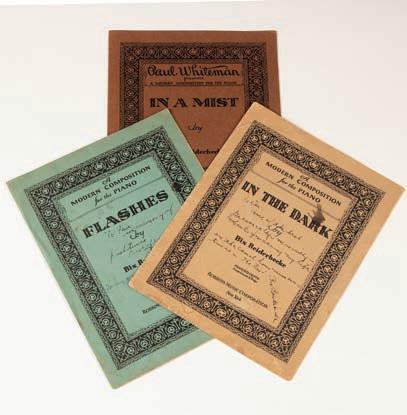
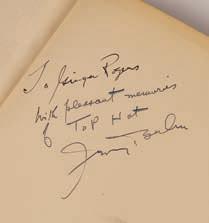
3 An annotated, printed score for Porgy and Bess by George Gershwin will also be on o er with a pre-sale guide price of £10,000-£15,000

There are also original reel-to-reel recordings, signed club menu cards and concert programmes, original concert posters and handbills, signed contracts and documents, photographs and even an instrument case.
Where are you expecting the interest to come from?
Interest will be global, reflecting the unique quality of the collection and the love for Charlie Watts from all corners. With estimates ranging from less than £1,000 to £300,000, we expect interest from a huge range of collectors and fans of Charlie Watts’ extraordinary musical career.
ANTIQUE COLLECTING 29
‘Although he had made his name in rock as an essential part of the “greatest rock ‘n’ roll band in the world” , Watts greatest love was jazz, with an especial fervour for the saxophonist, Charlie Parker’
1 2 3
1 Two inscribed piano scores by the in uential cornetist Leon ‘Bix’ Beiderbecke have an estimate of £6,000-£8,000
Two scores by Irving Berlin: Songs from Top Hat and Songs from Follow the Fleet, inscribed to Ginger Rogers have an estimate of £4,000-£6,000
Golden Opportunity
Gustav Klimt’s ethereal painting e Kiss is undoubtedly one of the world’s most recognisable – and reproduced – works of art.
e artist ourished in Austria’s Viennese Secession era at the turn of the 20th century, and is best known for his sensuous, richly ornate portraits, especially the luxuriant creations adorned with gold leaf that de ned his “golden phase”.
e Kiss and Portrait of Adele Bloch-Bauer I (also called e Woman in Gold), commissioned by the sitter’s husband, are among the most iconic works from this period, although Klimt’s oeuvre is much wider, and includes several verdant and mesmerising landscapes.
Klimt’s nal painting Dame mit Fächer ( e Lady with
Above right e Kiss from Gustav Klimt’s 50-print portfolio Das Werk, 1914. e portfolio is on sale from Peter Harrington for £135,000
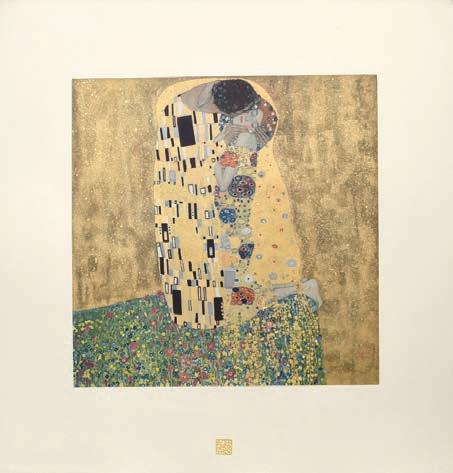
Below Klimt’s Dame mit Fächer ( e Lady with a Fan) sold for £85.3m at Sotheby’s in July, image courtesy of Sotheby’s
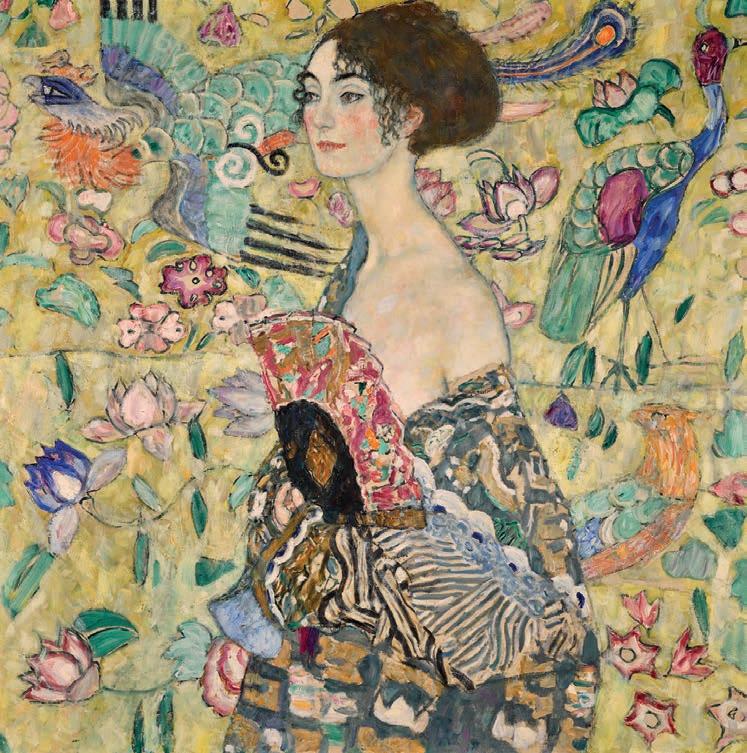
Below right Judith and the Head of Holofernes, from Gustav Klimt’s 50-print portfolio Das Werk, 1914. e portfolio is on sale from Peter
a Fan), which was famously found on his easel at the time of his death in 1918, brought in $108.4m at the Sotheby’s auction earlier this summer, setting an auction record for the artist and making it the most expensive public sale of any artwork in Europe, beating the $104.3m a Giacometti sculpture sold for in 2010.
Klimt’s works have historically fetched some of the highest prices achieved for any artist. e Portrait of Adele Bloch-Bauer II sold at a New York auction in 2006 for $87.9m, while his landscape Birch Forest sold at Christie’s in New York in 2022 for $104.6m, setting the previous record for the artist. Two more of his portraits were reportedly sold privately for more than $100m.
Collecting Klimt
While original artworks by the artist remain out of reach for all but only the most serious collectors with very deep pockets, Klimt’s editioned prints present a much more accessible – and highly sought after – opportunity to acquire one of the artist’s collectable works.
Traditionally considered an entry point into the market, signed and limited-edition prints have become a coveted area for collectors and is the fastest growing segment within collectable art, with a few names including Edvard Munch, Pablo Picasso, Andy Warhol and Banksy recently achieving seven- gure sales.
Prices for limited-edition prints from Klimt’s three editioned portfolios currently sell in the range of £1,750 to £20,000, dependent on the image in question.
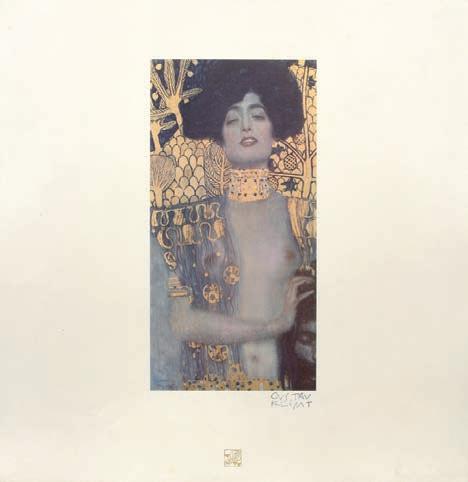
30 ANTIQUE COLLECTING COLLECTING GUIDES Klimt prints
While a painting by Gustav Klimt hit the headlines this year for being the most expensive European artwork ever sold at auction, his prints are both charming and a ordable, writes Kevin Finch
Das Werk
In the nal decade of his life, Klimt worked on a collaborative project that would be widely recognised as a graphic masterpiece.
Das Werk Gustav Klimts ( e Work of Gustav Klimt) was the only editioned set of Klimt prints produced during the artist’s lifetime. It was a project planned in conjunction with the Kunstschau 1908 exhibition (held in celebration of the 60th anniversary of the reign of Emperor Francis Joseph I) and overseen by Klimt and the Galerie Miethke.
Right Lying, Female Nude, red pencil, by Gustav Klimt, 1919, from the Fünfundzwanzig Handzeichnungen portfolio. For sale from Peter Harrington for £1,750.

Left Water Serpents II from Gustav Klimt’s 50-print portfolio Das Werk, 1914. e portfolio is on sale from Peter Harrington for £135,000
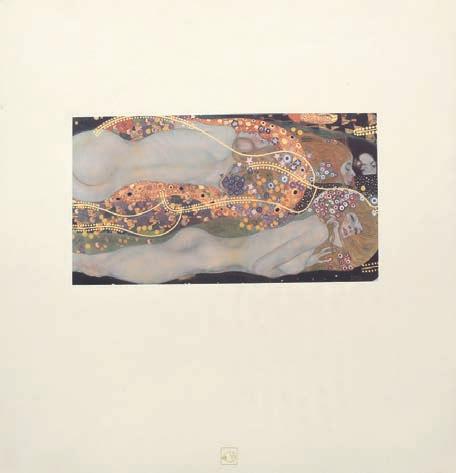
Below right Pallas Athena from Gustav Klimt’s 50-print portfolio Das Werk, 1914. e portfolio is on sale from Peter Harrington for £135,000

Erotic scenes
Fünfundzwanzig Handzeichnungen (Twenty Five Drawings) was a portfolio published a year after Klimt’s death containing 25 collotypes after line drawings. It was produced in an edition of 500 and 10 proofs and printed by the Art Institution Max Jaffé in Vienna. Containing mainly erotic scenes, some art historians suspect the artist had some involvement with its planning due to the meticulous nature of the printing.
The first 10 editions of the portfolio also contained an original Klimt drawing.
It contained 50 collotype prints on heavy wove paper with deckled edges, issued unbound. Intended as a means of advertising his work to a wider audience, the monograph was issued in a limited edition of 300, and includes prints of some of Klimt’s most important paintings such as e Kiss and Judith and the Head of Holofernes.
Because Klimt supervised the project and insisted on the greatest quality, the project, which was started in early 1908, was not completed until 1914. Each print featured a di erent gold signet specially designed by Klimt.
Complicated process
Originally the prints were divided into ve groups of 10 that were issued every 18 months to subscribers over a period of six years. Each set of 10 prints included two coloured images. e rst instalment was prepared to be introduced at the Kunstschau and much to the excitement of all involved in the project, Emperor Franz Joseph bought one of the sets from the rst issue. Collotypes were considered the best quality reproduction method at the time. Hand-printed collotype
plates cannot be reused, so the run must be completed on the rst go and in only a limited number. e complicated process involves gelatin colloids mixed with dichromates. in 16-colour separation glass lters achieve the lightsensitive internegative images, which capture the original tonal gradations. Finally, the plates are printed on delicate chine colle paper allowing greater colour saturation.
Complete examples of Das Werk are scarce today, as Klimt died shortly after the project’s completion, and the Viennese publishing company led by Hugo Heller, who published the prints, went into bankruptcy.
Many of the portfolios were subsequently lost or split, although several complete portfolios have been identi ed in high-pro le private collections, including that of the American architect Frank Lloyd Wright.
‘Klimt’s editioned prints present a much more accessible – and highly sought-after – opportunity to acquire one of his collectable works. Some depict Klimt’s most important paintings dating from between 1898 and 1913, including The Kiss and JudithandtheHeadofHolofernes’
ANTIQUE COLLECTING 31
COLLECTING GUIDES Klimt prints
in gold and Jurisprudence, from Klimt’s Faculty Paintings, created for the ceiling of the Great Hall of the University of Vienna but deemed too risqué for such a public and venerated setting.

Also on the premises were collections con scated by the Nazis. One of the most signi cant being the Lederer collection which featured many works by Gustav Klimt such as Girlfriends II and Garden Path with Chickens.
In many instances, Eine Nachlese is our only link to these lost treasures.
Lost Klimts
e Gustav Klimt Eine Nachlese (An Aftermath) portfolio was published in 1931, 13 years after the artist’s death. e 30-plate portfolio, which included 15 plates in colour was issued in an edition of 500 in three languages.
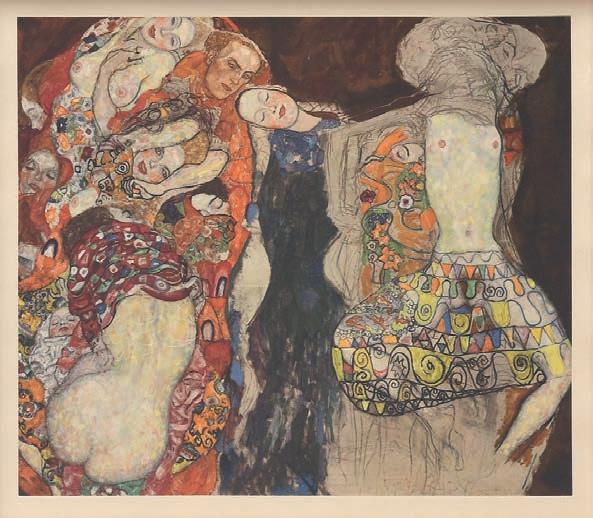

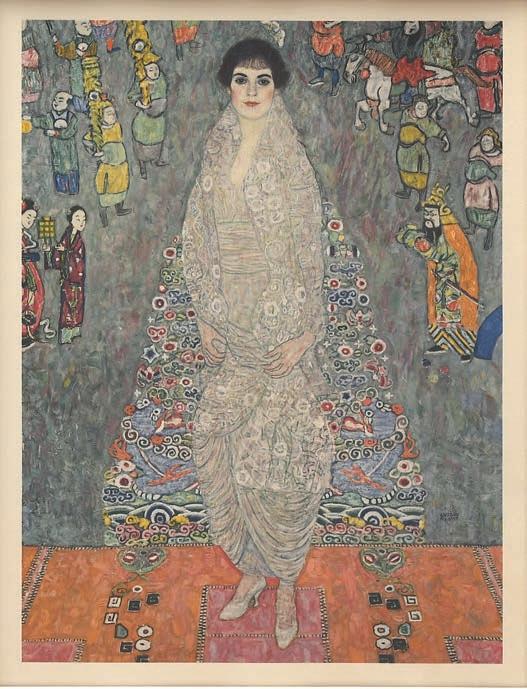

e publisher, Max Eisler (1881-1937) was an art historian at Vienna University who had worked on the publication of the rst Klimt monograph Das Werk and intended this portfolio to complement it.

Six of the paintings reproduced in the Eine Nachlese portfolio are of original artworks which were destroyed on May 8, 1945, when retreating Feldherrnhalle, a tank division of the German Army, set re to the Schloss Immendorf used to store objects of art. ese six include two paintings: Medicine, printed in colour and heightened
Above left Brautzag ( e Bride) (un nished) by Gustav Klimt, collotype print from the Eine Nachlese portfolio, 1931. For sale from Peter Harrington for £4,500.
Above Adam und Eva (un nished) by Gustav Klimt, a collotype print from Eine Nachlese portfolio, 1931. For sale from Peter Harrington for £4,500
Right Baroness Baronin Bachofen-Echt by Gustav Klimt, a collotype print from Eine Nachlese portfolio, 1931. For sale from Peter Harrington for £4,500
Left Medizin (Medicine by Gustav Klimt a collotype print from the Eine Nachlese portfolio, 1931, one of two paintings from Klimt’s Faculty Paintings. For sale from Peter Harrington for £7,000
Below right Baroness Friederike Maria Beer by Gustav Klimt, a collotype print from the Eine Nachlese portfolio, 1931. For sale from Peter Harrington for £4,500.
32 ANTIQUE
COLLECTING
Look out for
While editioned prints of Klimt’s most recognisable and famous works remain immensely desirable, the colour prints remain more obviously popular on account of their dynamism and hence tend to command higher prices.
Prints of the destroyed paintings, which can now only be recreated from images already printed, also command higher values.
Prints of extremely popular and well-known Klimt artworks such as Die Umarmung Die Erwartung (Expectation), remain highly collectable.
Kevin Finch is the gallery manager at Peter Harrington which has a complete portfolio of Das Werk for sale, as well as individual collotype prints of Klimt’s works from the Fünfundzwanzig Handzeichnungen and Eine Nachlasse portfolios. For more details go to www. peterharringtongallery.co.uk
Klimt and the Vienna Secession movement
Gustav Klimt (1862-1918)
was an Austrian symbolist painter and one of the most prominent figures of the Vienna Secession movement. He was born on July 14, 1862, in Baumgarten, a suburb of Vienna, Austria, and grew up in a family of artists.
Above left Die Umarmung ( e Embrace) by Gustav Klimt, 1931. From the Eine Nachlese portfolio. Sold by Peter Harrington for £6,500
Above Die Erwartung ( e Expectation) by Gustav Klimt a collotype print from Eine Nachlese portfolio, 1931. Sold by Peter Harrington for £6,500
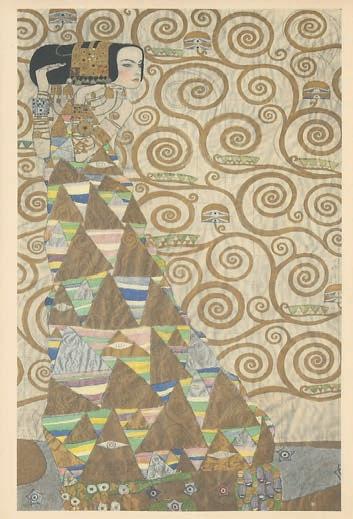
Left Bauerngarten mit Hühnern (Garden Path with Chickens) by Gustav Klimt, collotype print from the Eine Nachlese portfolio, 1931. Sold by Peter Harrington for £5,000
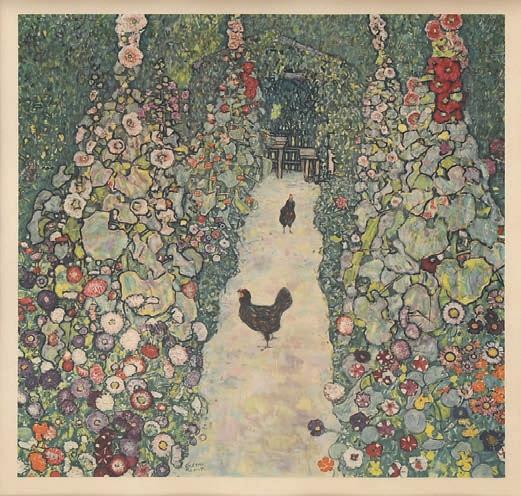
Below Der Tod und das Leben (Death and Life) by Gustav Klimt, a collotype print from Eine Nachlese portfolio, 1931. For sale from Peter Harrington for £4,500
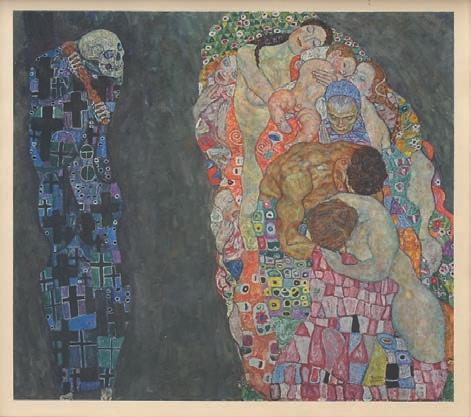
His work, characterised by its intricate and decorative style,was influenced by various art movements, including art nouveau, symbolism, and the arts and crafts movement. In theme, Klimt’s paintings often explored sensuality, love, and the human condition.
Klimt’s artistic contributions were not limited to painting; he was also a skilled draftsman and produced numerous sketches and drawings throughout his career.

He was a co-founder of the Vienna Secession, a group of progressive artists who aimed to break away from the traditional art institutions and promote innovative and modern art.
Dissatisfaction with traditional art
Many artists in Vienna during the late 19th and early 20th centuries felt constrained by the conservative rules and regulations of the established art institutions. They wanted to break away from the traditional academic style promoted by the Vienna Academy of Fine Arts and other art organisations.
Wealthy patrons and collectors, including some industrialists and members of the Viennese bourgeoisie, supported the Secessionists financially and by purchasing their works. This backing provided the artists with the necessary resources to thrive and create innovative art.
The movement launched its own magazine called Ver Sacrum, meaning Sacred Spring, which showcased the group’s artistic vision and featured contributions from various artists and writers. The magazine played a vital role in promoting the movement and its ideas.
The Secessionists were not limited to painting and sculpture but also engaged in architectural projects and interior design. Their innovative architectural creations, like the Secession Building in Vienna (designed by Joseph Maria Olbrich), demonstrated their commitment to modernity and artistic unity across different disciplines.

ANTIQUE COLLECTING 33
Above e Secession Building in Vienna, designed by Joseph Maria Olbrich, image Shutterstock
TIDES of CHANGE
While artist colonies on Newlyn and St Ives are well known by collectors, less celebrated are painters from the Staithes Group which, for a short spell, was an important artistic centre at the forefront of the British Impressionist movement. Inspired by their French
Above Richard Marshall (1944-2006) StaithesFishermen Bringing in a Coble, signed, oil on board, 22.5 x 30cm. It has an estimate of £100-£150 at this month’s sale at Tennants

Above right Owen Bowen (1873-1967)
Bringing the Cows Home, signed and indistinctly dated, oil on canvas, 44 x 59cm. Estimated to sell for £1,500-£2,500, it sold for £2,800 at Tennants’ sale on July 16

Left Arthur A.
counterparts, the group worked en plein air to capture eeting moments of light, air, and water, albeit with an edge of harder, northern grit.
e secluded community had largely avoided the dramatic changes that industrialisation had brought to nearby Tynemouth and the Shields, preserving the traditional existence of the people that lived there within the natural harbour that sheltered it from the rest of the world.
At its height, the group was made up of nearly 40 artists, some of whom lived permanently in the area while others visited for extended periods each year.
is July, 120 works from its leading artists, from the collection of the dealers Tom and Rosamund Jordan went under the hammer at Tennants Auctioneers in North Yorkshire, with many ying past their pre-sale estimates before nally selling for a total of £108,560.
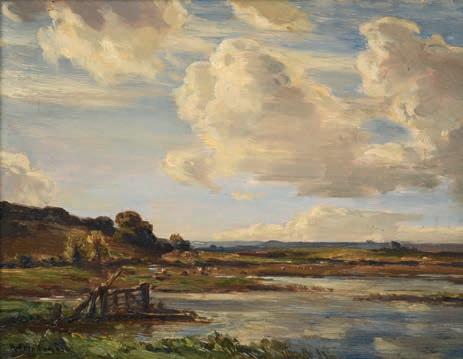
With the second part of the sale, made up of 50 more works on September 16, now is the time for collectors to take note of this undervalued group.
Secluded community
e artists lived among the shermen and women, often lodging in their homes. Not only did this provide a muchneeded boost to the local economy, it allowed the painters to understand the hardships of the shing community, enabling them to depict scenes with insight and empathy.
e movement began with omas Barrett, a professor at Nottingham School of Art, who rst visited the village in 1880, soon followed by William Gilbert Foster, who bought a cottage in Runswick Bay in 1890.
e completion of the Staithes railway in 1883 had greatly improved accessibility, gradually luring more and more artists to the area, some staying for a summer, and others putting down roots.
Perhaps the most widely recognised artists today are Harold Knight and Laura Johnson (later Laura Knight), pupils of Barrett in Nottingham who told them “there is no place like it in all the world for painting”. In 1897, they visited for a month with Laura’s aunt, before moving to the area full time from 1898 to 1907. Knight loved the area, later stating in her biography: “Staithes had been one of the most vital in uences in my life”.
1901 saw the formalisation of the Staithes School of Art with their rst exhibition at the Staithes Fishermen’s Institute. ey would exhibit annually, later moving to the Anderson Gallery in Whitby, until 1907.
At this point, the growing group was unable to nd a venue large enough to accommodate the exhibition. is,
34 ANTIQUE COLLECTING
For a short time the small Yorkshire shing village of Staithes was in the vanguard of British Impressionism. is month sees work by the in uential school of artists go under the hammer
COLLECTING GUIDE e Staithes Group
Friedenson (1872-1955) Purbeck in Dorset, signed, oil on board, 20 x 26cm. It has an estimate of £200-£300 at this month’s sale
Ernest Rigg (1868-1947)
Bradford born Rigg (1868-1947) was part of a later wave of artists arriving in Staithes in the 1890s, settling in Hinderwell, near Runswick Bay, close to fellow painter Frederick William Jackson.
Rigg had studied at the School of Art in Bradford before travelling to Paris to enrol at the Académie Julian to see close up the influence of the French Impressionists and the prevailing fashion for painting en plein air
Rigg’s paintings are characterised by their vibrant colours and his figure scenes which capture the relationship between humans and nature.
In 1886, Rigg, his brother Arthur and the artist Henry Herbert La Thangue (1859-1929) established the Arcadian Art Club.
La Thangue, while growing up in Croydon, spent much of his early career working in Bradford painting local portraits.
The club’s goal was to promote local artistic talent and raise the profile of plein air painting.
After the Staithes colony broke up, unlike many artists who migrated southwest to Newlyn, Rigg stayed close to his roots in the north east.
He enjoyed some success during his lifetime, exhibiting regularly at the Royal Academy, but his acheivement was better measured in the work he did to promote the arts in Yorkshire, including being a founding member of the Staithes Art Club, as well as the Yorkshire Union of Artists.
Right Ralph Hedley (1848-1913) e Cider Press, signed and dated 1895, oil on canvas, 43.5 x 33.5cm. Estimated to make £500-£800, it sold for £2,000 at the sale on July 16

Below left Ernest Higgins Rigg (18681947) Sheep Grazing in a Summer Landscape, signed, oil on canvas board, 29.5 x 39.5cm. It has an estimate of £200£300 at this month’s sale

Below right Rowland Henry Hill (1873-1952)
A View of Whitby Castle, signed and dated 1932, pencil and watercolour, 18 x 26cm. It has an estimate of £150-£250 at this month’s sale

combined with the exhibition clashing with the Royal Academy Summer Exhibition in London, a scarcity of patrons in the area, and many of the artists looking for new pastures to paint, meant 1907 would mark the end of the Staithes School.
Fred Jackson, Mark Senior, Rowland Hill and Albert Stevens continued to work in the Staithes area, but others drifted away. Knights moved south to Cornwall, others such as Henry Hopwood moved abroad, Ernest Dade and Hannah and Fred Mayos moved to London, Arthur Friedenson went to Dorset, becoming known for his landscapes of the area. e artists remaining in Staithes went on to amalgamate with the Yorkshire Union of Artists.
ROWLAND HENRY HILL (1873-1952)
Another later arrival to the Staithes colony was Rowland Henry Hill, who was born in Halifax, west Yorkshire. Following extensive periods of studying and working abroad in France and Belgium, Hill settled in Hinderwell near the sheltered settlement of Runswick Bay, just south of Staithes.
Here, he painted local landscape scenes with a brand of ruralism which tended to concentrate on traditional cottages and their exterior.
As seen above, his vibrant colour palette is particularly suited to capturing the atmosphere and light of the northeast coast.
‘Perhaps the most widely recognised artists today are Harold Knight and Laura Johnson (later Laura Knight), pupils of Barrett at Nottingham School of Art. Barrett had told them “there is no place like it in all the world for painting”. In 1897, they visited for a month, before moving to the area full time from 1898 to 1907’
ANTIQUE COLLECTING 35
COLLECTING GUIDE e Staithes Group

Left Staithes in the early 1960s was still a sleepy backwater, image public domain

Right Dame Laura Knight (1877-1970) Fisherfolk
Baiting Lines on the Cobbles, Staithes sold for £18,900 in 2022, beating its low pre-sale estimate of £15,000, image courtesy of Christie’s
Below e charming shing village has been a magnet for artists for years, image Shutterstock
e Collectors
Rosamund Jordan, a former art teacher from Stockton turned collector and dealer, was first drawn to these particular paintings in the early seventies, before the artists had even been identified as a distinctive group.
Her collection started after an aunt left her some uninspiring Victorian oil paintings. She said: “I decided to sell them and get some I liked.”
At the time, the Staithes artists were simply described as “northern impressionist painters” but Rosamund and her geography teacher husband, Tom, recognised their skill and bought half a dozen works. In 2012, Rosamund told The Northern Echo: “They painted in a free-flowing, impressionist manner, with vibrant colours and broad brush strokes, but the greatest influence on all these artists was the area itself. The light in this part of the world is fantastic, the mood and the colours of the sky and the sea always changing.”
For more than 40 years the couple established a reputation as leading specialists in the Staithes Group of painters, believing that this pioneering yet neglected group should be written into the history of world art. The Jordans were equally passionate about Staithes itself, restoring a small fisherman’s cottage there and donating works to the village.
Part II of the TB & R Jordan Collection, including works by the Staithes Group takes place at Tennants Auctioneers, Leyburn, on September 16.
Harold and Laura Knight
In 1897, six years before they married, Harold Knight and the then Laura Johnson, visited Staithes. Both were students at the Nottingham School of Art, where Harold was the star pupil; Laura having enrolled there in 1890 at the age of 13. Interspersed by three periods in Holland in Laren artists’ colony, the pair remained in Staithes until 1907.
In her autobiography Oil Paint and Grease Paint she describes her affection for the village: “Staithes…. It was there that I found myself and what I might do. The life and place were what I yearned for – the freedom, the austerity, the savagery, the wilderness.
“I loved the cold and the northerly storms when no covering would protect you. I loved the strange race of people who lived there, whose stern almost forbidding exterior formed such contrasts to the warmth and richness of their nature.”
It may have been Laura’s own turbulent background (her father abandoned the family when Laura was a baby leaving her mother Charlotte to bring up three daughters) that allowed her to seek out the community’s most disadvantaged members and portray them with honesty and dignity.
Move to Newlyn

In 1907, when the group disbanded realising the west of England was becoming an artist’s mecca, the couple moved to Cornwall, joining the Stanhope Forbes School in Newlyn.

It was a tremendous wrench, described by Laura in her autobiography: “Staithes had been one of the most vital influences in my life. To turn away from all that it had meant, fearing never to return, hurt me terribly.
“I hated leaving the moorland and the North Sea, the struggle that made you strong, the wild race of fisher people I loved so well. It was there that I had found what I might do.”
36
ANTIQUE COLLECTING
Q&A
We asked David Messum from the fine art gallery Messum’s, which specialises in British Impressionists, why collectors should take note of the Staithes school

QHow important were the artists’ colonies in Newlyn and Staithes?

AVery. British Impressionism has come a long way since we published a book on it in 1985, back then people thought it was a joke, or at least an oxymoron. But British Impressionism can trace its roots back to Turner, Constable and Gainsborough, and I am pleased to say even Tate now has a British Impressionism room. Art schools like the Staithes Group was central to this movement and its role is now being recognised.
It was the 1970s when we started looking seriously at the Newlyn School of Art, at that time Victorian art was popular and it was seriously undervalued. Back then you could buy a work by Stanhope Alexander Forbes (1857-1947) for a couple of thousand, now they sell in their hundreds of thousands. The same can be said of the Staithes Group as the Newlyn School of Art.
QWhat is the importance of painting en plein air for both the Staithes Group and Newlyn School of Art?
AThe portrayal of honest endeavour was a by-word for the artists who settled within both communities. Newlyn artists recorded the mood and tragedies of the villagers – there were losses at sea as well as losses from those young men who had gone to fight in WWI. As in Staithes, the artists were connected to the everyday. Central to both colonies was the importance of plein air painting which involves being in front of the subject in the open air.
To catch the moment the artist developed a square brush technique which allowed them to add colour quickly to catch the moment before the sun moved around and the shadows changed.
They captured the light reflecting off the subject and forming shapes, rather than the more traditional approach of beginning with the outline of a solid shape. There was a freedom of expression central to both schools. Most of the artists had an international outlook having studied at Académie Julian in Paris, and the Académie Royale des Beaux-Arts in Antwerp.
Loaded hay wagon and haymaking before a sun drenched coast, signed and dated 1894, oil on canvas, 28.5 x 44cm. Estimated to make £1,000-£1,500, it sold for £6,200 at Tennants on July 16

QHow innovative was their style?
AIt is difficult to imagine today how revolutionary work by the Staithes Group was at the time. The stark realisation of a life led by these local folk was a revelation to the people visiting the Royal Academy and it suddenly bought such themes to national prominence at a time when much of the Academy exhibits were of neo-classical subjects. This form of social realism is seen by many as a precursor to the school of British Impressionism which followed.
QWhich artists should we look out for? A

It’s very subjective but I would say Arthur Friedenson (1872-1955) is one at the forefront. He was originally apprenticed as a sign painter, before studying in Paris and Antwerp. He exhibited at the Royal Academy from 1889, many of his early works being landscapes and coastal views around Runswick and Staithes, before moving to Dorset.
Others include Robert Jobling (1841-1923) who was a native of the northeast and had a great interest in the lives of fisherfolk local in the Tynemouth area. Previous to Staithes Jobling had spent much time working in the fishing village of Cullercoats, situated not far north of North Shields, where he formed the Cullercoats Artists’ Colony. However, his future wife, Isa Jobling, had visited Staithes in 1892 and after their marriage in 1903 persuaded him to forego painting trips to Cullercoats in favour of Staithes.
QIs now the time for the Staithes Group to shine?
ACollectors like the Jordans, and others, have been hugely influential in putting Staithes on the map. The art market is fickle and art itself is very subjective, it only takes a few people to get behind an artist and the market can become invigorated. Certainly the work of the Staithes Group is undervalued at the moment and it’s high time collectors picked up on it.
Discover more about the Staithes Group and their work at www.messums.com
ANTIQUE COLLECTING 37
‘The art market is fickle and art itself is very subjective. It only takes a few people to get behind an artist, or school, and the market can become invigorated. Certainly the work of the Staithes Group is undervalued and its high time collectors picked up on it’
Abiove Arthur A. Friedenson (1872-1955)
TEST YOUR KNOWLEDGE
Puzzle TIME
It’s not just youngsters going back to school this month, sharpen your antiques knowledge with the latest puzzles from our quiz editor Peter Wade-Wright
SEPTEMBER QUIZ
Q1 If you collected the Tuck series would your interest be? (a) cigarette cards, (b) postcards, (c) certain rst edition novels, (d) Nutritious WWII food recipe lea ets?
Q2 What is a Spanish foot? (a) an 18th-century paella dish measurement, (b) an ornate 19th-century clock base, (c) a late 19th-century scroll-shaped furniture terminal, (d) 18th-century (and later) Flamenco dancers’ steel-capped shoes.
Q3 What were John Sadler and Guy Green famous for? (a) transfer printing on porcelain, (b) book binding, (c) ‘rustic’ furniture, (d) small tapestries for those hard to conceal wall deformities.

Q4 What are pasglas? (a) European Medieval spectacles, (b) a cylindrical beaker for communal drinking games, (c) Austrian paperweights with pastoral motifs, (d) German glass plate for High Church use at Easter.
Q5 In 2000, Sotheby’s London sold a gure by the French designer Gabriel Argy-Rousseau (18851953) for £35,000. For what medium is he most remembered? (a) porcelain, (b) precious metals, (c) glass, (d) wood.
Q6 In calligraphy what is rubrication? (a) wall-like gapping between paragraphs, (b) in a ‘homeland’ or ‘farmyard’ style, (c) ourishes that look like horns, (d) emphasis of initial letters, instructions etc.
Q7 What does anamorphosis mean? (a) distortion of an image, (b) overexposure in early photographs, (c) changes to religious commentaries from one edition to another, (d) use of wood grain for decorative purposes.
Q8 What links the 18th-century artists Benjamin Zobel, George Haas and F. Schwiekhardt to the Isle of Wight? (a) some of their best work was done at Ventnor, (b) they were all marine artists, (c) ammonite-based designs, (d) coloured sand.

Send your answers to Crossword, Antique Collecting magazine, Riverside House, Dock Lane, Melton Woodbridge, Su olk, IP12 1PE. Photocopies are also acceptable, or email your answers to magazine@ accartbooks.com. e rst three opened by September 15 will win a copy of Jackson’s Hallmarks, Pocket Edition: English, Scottish, Irish Silver & Gold Marks From 1300 to the Present Day, worth £6.95

furniture leg?
Q9 Link the following owers and their ‘interpretations’ according to the Floral Code.




(i) lilac, (ii) marigold, (iii) bluebell, (iv) pink…(a) constancy, (b) rst love, (c) boldness, (d) grief.

Q10 Broken glass added to a new batch under production is called, by professionals (a) mullet, (b) bullet, (c) cullet, (d) dammit?
Finally, here are four anagrams reliable cog , fetal war, equip pal and gaslit pesterer. Rearrange them to form, in order, (a) S-shaped furniture support (two words), (b) plates, salver and cutlery (c) separately made ornamentation to an object, (d) barometer scales (pl.) against which the mercury level is read (two words).
For the answers turn to page 10.
SOLUTION TO LAST MONTH’S CROSSWORD:
The letters in the highlighted squares are L, S, V, A, R, I, E, S, E and L which, rearranged, form Versailles. The three winners who will each receive a copy of the book are K. Radford, Herts, by email; Cissie Howarth, Leiceister and Dr P. Goodman, by email.
38 ANTIQUE COLLECTING
1 2 3 12 5 11 13 4 7 6 9 10 16 23 22 24 14 15 8 17 18 2021 19
Q8 What links three artists to the Isle of Wight
to a new batch under production is called, by professionals (a) mullet, (b) bullet, (c)
barometer scales (pl.) against which the mercury
J A CANAPES S K SIT E T EID O GA REE B A D AUAU S TE O NOSE EKY S R LL EAVE NUT A T C IWSP A R A S O LLOR E H S UAM U R E CS L S PO
Q9 What, according to tradition, do lilacs represent?
4 ACROSS CLUE
Across
1 Valued gem, often ‘milky’ but always with a play of changing colours. (4)

4 The name of a sea and Bronze Age civilization and artefacts of the coasts and islands between Greece and Asia Minor. (6)

7 Giant grass used as material and oriental motif. (6)
8 Greek hero of the Trojan war and son of King Telamon. (4)
9 Variation of the ball foot terminal for table legs etc. it made its first appearance in the 17th century (3)
10 Sir Hans _____ (1660-1753). His collections and library formed the nucleus of the British Museum. (6)
12 Written (hence collectable) instrument of law. (4)
15 Indispensable tiny tools of the dressmakers’ art. (pl.) (4)
18 Shape and size of a book. (6)
21 Screech - ___. Medieval-bestiary harbinger of bad news…or worse. (3)
5 DOWN CLUE
22 Egg-type shape used on clockfaces etc. …and a Surrey-based source of cricket memorabilia. (4)
23 Decorative metalwork of gilded bronze. (6)
24 Having exchanged commodities for money or other goods. (6)
25 Examples include ‘Davenport’, ‘knee-hole’, Escritoire use, etc. (4)

Down
1 Mollusc-formed concretion…sounds dreadful, but is highly prized. (5)
3 Seventh sign of the zodiac…on balance that is. (5)
4 Sun-dried clay/mud building covering. (5)
5 ____ Tour. 18th and 19th-century peregrination through Europe. Much of antiquity was carried back home. (5)

6 Beautifully variegated/banded semi-precious stone used for stunning decoration. (5)
10 Soft ___-wood between bark and heart-wood. Used for the ‘belly’ of longbows. (3)
11 Make yours…by a successful bid at auction? (3)
13 Timber traditionally used for house weatherboards. (3)
14 Single element of Ben-Day ____s used in the Pop Art of Roy Lichtenstein. (3)
16 Iron-nickel alloy with very low expansion properties, hence used in scientific instruments. (5)

17 Not molten or soft, hence a metaphor eg. ____oak. (5)
18 Universal term for ancient water damage. (5)
19 Covered with frost…real or decorative. (5)
20 Paper size and the name of a geographical guide first published by Mercator in 1595. (5)
Finally, rearrange the letters in the highlighted squares to form the name of a container for the display of plants/flowers. (10)
ANTIQUE COLLECTING 39
12 3 12 5 11 13 4 8 6 9 10 16 23 22 24 14 15 7 17 18 20 21 19
1 ACROSS CLUE
What is the name of this “milky” gemstone?
John Brown (1752-1787) Gentleman on the __ Tour
What is the name of this European sea?
25
elapsed since their rst sale) fall into several di erent categories. Some are more collectable than others and some go in and out of fashion so the values can change but some standard rules apply across all categories. Here are three types of clock that are worth considering in the early days of establishing a collection.
Carriage clocks

More accurately described as travelling clocks (the French call them pendule de voyage which removes any assumption they were solely designed for use in a carriage). When clocks were rst produced, they were hugely expensive luxuries, so it was rare for even a well-todo household to have more than one.
us a portable clock (which eliminated the need for a pendulum) was a good idea not only to take on your travels but also around the house.
For bedside use, some re nements were developed such as a repeat button on top of the case which, when depressed, repeats the last hour struck (clocks strike the hours and chime the quarters). erefore, on waking in the night, you could avoid going to all the trouble of igniting a match to light a candle just to see what the time was by using the repeat button to tell you it was between two hours. Others have a built-in alarm. e more features, the more desirable the clock will be.
Complicated business
In addition to a striking clock, a repeater strike and an alarm, you can nd carriage clocks which show the day, the date and even moon phase. A clock known as a petite sonnerie strikes the hour and the quarters, whereas a grande sonnerie strikes the hour then repeats the last hour and each quarter so you know the hour every 15 minutes without having to look up at the clock. ey are highly collectable.
TIME to BUY
I’ve always been fascinated by clocks. Like cars, they’re a magni cent blend of those odd bedfellows – engineering and aesthetics. It helped that my forebears were clockmakers, including the noted horologist Charles Frodsham who was clockmaker to Queen Victoria and known for his exceptional craftsmanship and precision. So, growing up I occasionally came across clocks whose dials bore my unwieldy surname. Quite a show stopper for a young boy. Once retirement beckoned, I turned my hobby into something a little more involved – buying and selling clocks.
Antique clocks (de ned as over 100 years having
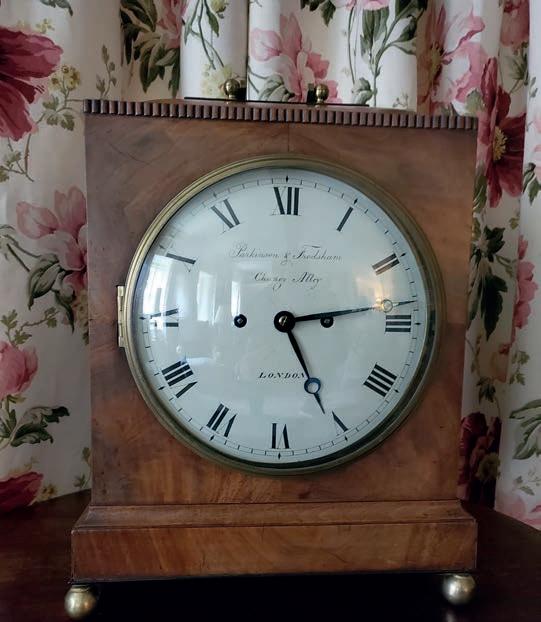
40 ANTIQUE COLLECTING
ere’s never been a better time to start a clock collection, writes Simon Frodsham
– and he should know he is the great-greatgreat nephew of the renowned clock and watch maker Charles Frodsham
COLLECTING GUIDES Starting a clock collection
Above Charles Frodsham repeater carriage clock, on sale from Frodsham Clocks priced £2,500, all images unless otherwise stated courtesy of Frodsham Clocks Right Parkinson & Frodsham mahogany cased eight-day table clock
e carriage clock we know today was developed from earlier spring-driven travelling clocks by the French maker Abraham-Louis Breguet (1747-1823) in the rst quarter of the 19th century. e English clockmakers quickly followed suit and so the best examples are generally either French or English.
It’s always a good idea to buy clocks with a recognised name which is usually found on the dial (dial, not face, in horological-speak) but it is complicated by some dials being signed by the retailer rather than the maker.
Best examples
Some specially commissioned clocks bore the name of the customer. e better clocks tend to be numbered and signed on the movement itself. is all falls under the category of: research always pays o .
Better French makers include Jean-Paul Garnier (18011869); Pierre and Alfred Drocourt, who were arguably the most celebrated carriage clock makers in France in the second half of the 19th century; and the Jacot family of clockmakers who also worked in Paris during the second half of the 19th century and whose clocks all bear the maker’s mark of a parrot (the meaning of ‘jacot’).
Also look out for the Japy Frères, founded by Frédéric Japy in 1777; Achille Brocot (1817-1878) and Joseph Soldano, an early carriage clock producer who was largely responsible for the improvement of ne quality carriage clock production.
And, for the really well-heeled are pieces by the already mentioned Abraham Louis Breguet, said to have invented the carriage clock when he created a version for Napoleon at the close of the 18th century which he called a pendule d’o cier (‘o cer’s clock’).
is side of the Channel well-known English makers
Above Parkinson & Frodsham dial clock, £1,750, from 1779 to 1850, a partnership existed between William James Frodsham (17791850) and William Parkinson (d. c. 1842) under the name of “Parkinson & Frodsham”
Right A Victorian ebony and gilt chiming boardroom clock

7 rules of clock collecting
1 Always prioritise quality over quantity.
2 In the early days, find dealers you like and can trust. You can always find anything for less money but the pitfalls (fakes, wrecks and failures) will undoubtedly end up costing more in repairs alone.
3 Always spend as much as you can afford. And more if you can. You won’t regret it.
4 Think about the next clock you want carefully and take time to find the right example.
5 Concentrate on a specific type, especially for the first purchase.
6 Don’t be tempted to buy anything that appeals, or trust whatever you are buying will work.
7 Research is an essential part of buying antique clocks. Start with a simple search of the clock’s maker, value, and if it is the first clock they made.
of
Time to buy
Carriage clocks tend to go in and out of fashion. At the moment, the market is more depressed than it has been in the past so now is a good time to think of taking the carriage clock plunge.
By way of budget, there is no price limit that rare carriage clocks can achieve (well into six gures) but I would suggest that somewhere between £2,000 to £3,000 is the best starting point to buy a good example.
I would counsel against clocks that sell for less than £1,000. Many of which were mass-produced in the decades after 1970 and 1980 and can be nothing short of absolute horrors and should be avoided at all costs.
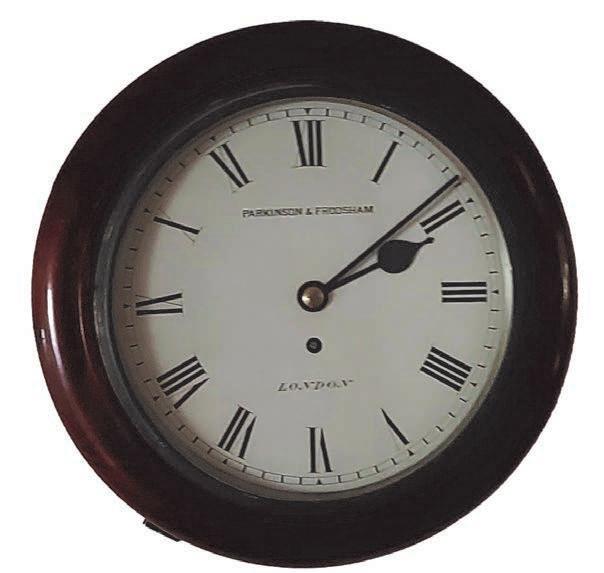
‘The market for less collectable examples of longcases has dropped like a lead weight in the past 20 years. So you might find a longcase clock selling for a fraction of the price it would have attracted 30 years ago’
include Edward Dent (1790-1853) the founder of the London manufacturer of luxury clocks and watches; James McCabe (1748-1811) one of the most eminent makers of the 19th century who produced precision clocks and chronometers from his work shop at the Royal Exchange; and,
course, my forebears – Frodsham.
ANTIQUE COLLECTING 41
Dial clocks

Wall, station, railway and school clocks are known collectively as dial clocks and you’ll have seen them everywhere. ey’re known by any of the descriptions above which gives a clue what they were for. ey’re usually in a mahogany case with painted Roman numerals on a white 12in dial.
Originally designed for use in servants’ quarters, mass production after around 1840 meant they were manufactured in huge numbers and deployed almost everywhere as a result. Every o ce, station, school, post o ce had at least one – it’s said that St. Pancras Station alone had more than 400.
ose made by well-known makers will attract a premium, as do examples that di erentiate them from the normal design. Clocks with a railway history (usually the train company is identi ed on the dial), examples that strike, dials that are eight, 10 or 14in (sometimes bigger), brass dials, drop pendulum cases (where the pendulum is longer so needs an addition to the case), unusual wooden cases and RAF sector clocks all attract specialist collectors with the resultant price hike.
Best makers
Some better makers also produced the standard format, including examples by the likes of Smiths, founded in 1851, and once the largest clock manufacturers in Europe, or the Anglo-German clockmaking rm Camerer Cuss which was founded in Bloomsbury by two German immigrants in 1788. Another well-known maker is waites & Reed,
Left Carriage clock by Joseph Soldano, on sale from Frodsham Clocks £2,250, image courtesy of Frodsham Clocks

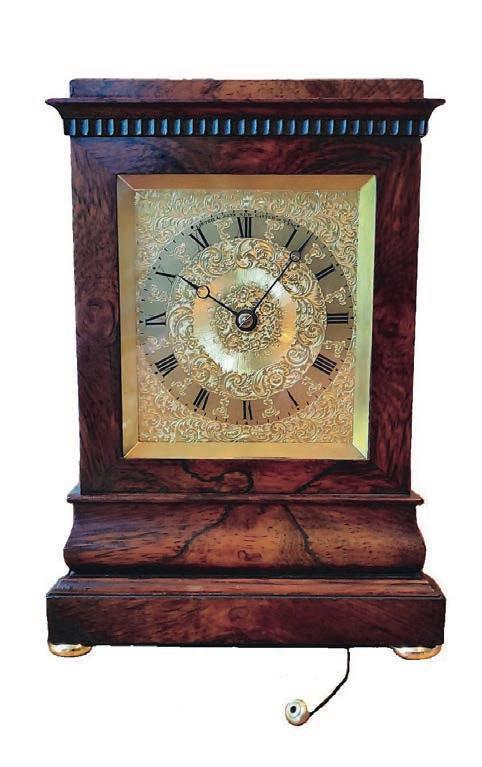
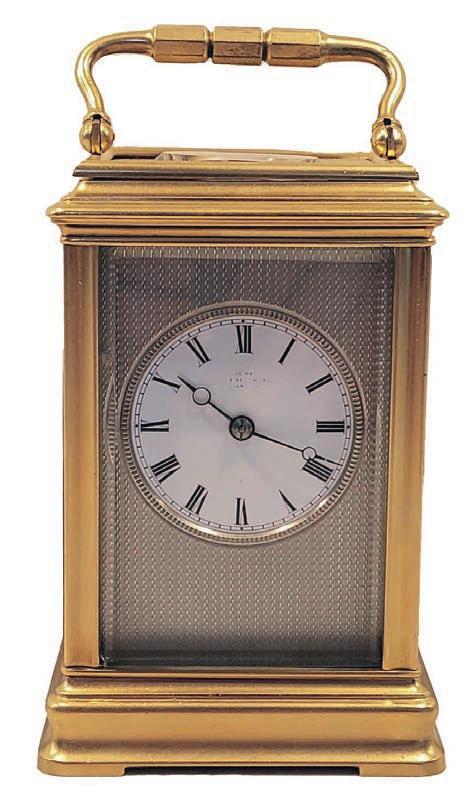
Right George III brass mounted bracket clock by Handley & Moore c. 1810, image courtesy of Frodsham Clocks
Below right Rosewood cased mantel clock by Lister of Newcastle, on sale from Frodsham Clocks £18,500, image courtesy of Frodsham Clocks
founded in London in 1740 and, of course, Frodsham (there’s that name again) .

But the standard dial clock with a 12in, white dial in a mahogany case is a great starting point for any collection. Nowadays they are often used as kitchen clocks to give depth to a modern kitchen design. A simple mechanism also means the repair and servicing bills are more manageable.
As ever, unusual examples attract heavier premiums but a good example of the standard design should cost somewhere between £500 to £1,000. Make sure you nd an eight-day rather than a 30-hour version though, otherwise you’ll have to wind it every day rather than once a week.
42 ANTIQUE COLLECTING
COLLECTING GUIDES Starting a clock collection
Longcase clocks
More commonly known as a grandfather clock, longcases are tall, weight-driven pendulum clocks. ey were to be found in sophisticated town houses or more humble surroundings like a farmhouse, although the quality obviously varied somewhat.
e majority of British longcases were made from around 1660 to 1920 although, by 1840, most production in London had petered out in favour of provincial clockmakers. e early versions had brass dials and most have cases made from walnut veneer, mahogany, satin wood or rosewood. e cheaper, mostly rural, clocks often had oak cases. Painted dials appeared from around 1770. Typically, a longcase will strike the hours and a few chime the quarters or play a selection of tunes.

Below left omas Tompion (1639-1713)
the dial indicates hours and minutes, subdivided into 10-second intervals, calendrical information and the phases, aspects, and ages of the moon in its monthly cycle, as well as times of high tide at London Bridge, image courtesy of the Metropolitan Museum of Art
Who were the Frodshams?
Charles Frodsham (1810-1871) – the most celebrated of the Frodsham watchmaking family – was born in London in 1810 into a family of chronometer, watch and clock makers. At the age of 14 he was apprenticed to his father, William James Frodsham FRS (1779-1850) a chronometer maker. Charles showed his talent from an early age entering two chronometers for trial at Greenwich, at the age of 20 for which he won second prize.
By 1834, Charles had established his own business and 10 years later, following the death of chronometer maker John Roger Arnold, he purchased Arnold’s business and moved into Arnold’s former premises at 84 Strand. Charles Frodsham went from strength to strength, exhibiting successfully at the Great Exhibition in 1851 and expanding further in 1854 with the purchase of the late Benjamin Lewis Vulliamy’s business. Charles succeeded Vulliamy as superintendent and keeper of clocks at Buckingham Palace and in 1855 served as Master of the Worshipful Company of Clockmakers, a role he repeated in 1862. Charles Frodsham died in 1871 and was succeeded by his son Harrison.
Frodsham watches and clocks are known for their elegance and fine proportions with some said to be worthy of Breguet.
Best makers
Longcase clocks were made by some of the nest 17th and 18th-century English clockmakers. An example by omas Tompion (1639-1713) – known as the father of English clockmaking – will separate you from a healthy six- gure sum and are highly sought after. As are those by George Graham (1673-1751), Edward East (1602-1697), Joseph Knibb (1640–1711), omas Mudge (1715-1794) and John Ellicott (1706-1772).
But the market for less collectable examples has dropped like a lead weight in the past 20 years or so. As we’re all living in smaller spaces, most of us simply don’t have room for a huge clock. So you might nd a longcase clock selling for a fraction of the price it would have attracted 30 years ago.
But if you do have room, a longcase can add another dimension to a house. e long pendulum sweeps at a statesman-like pace, usually at the same rate as the human heartbeat so instantly adds serenity to its surroundings. ese clocks were produced in both eight-day and 30-hour con gurations so to have any chance of maintaining value let alone avoiding the hassle of a daily wind, always make sure you opt for an eight-day. I would suggest you budget from around £2,000 upwards to ensure a good example.
Simon Frodsham owns Frodsham Clocks which buys and sells antique clocks, as well as nding time pieces to order. He will be among the dealers at this month’s Northern Antiques Fair at the Garden Rooms at Tennants Auctioneers, Harmby Road, Leyburn, North Yorkshire from September 28 to October 1. Go to www.northernfair.com for more details.
ANTIQUE COLLECTING 43
‘The long pendulum sweeps at a statesman-like pace, usually at the same rate as the human heartbeat so instantly adds serenity to its surroundings’
Material Girl
An exhibition at the V&A shining a light on the pioneering French designer Coco Chanel has sparked a season of auctions of the iconic French fashion house. Antique Collecting investigates

Without the in uence of the pioneering French designer Gabrielle Bonheur ‘Coco’ Chanel (1883-1971) fashion today may look very di erent.
It was Chanel who revolutionised women’s clothing in the early 20th century – freeing women of corsets, voluminous skirts, and ornate accessories. Her designs, including trousers for women, introduced a new sense of ease and comfort, emphasising functionality and simplicity. She popularised the use of comfortable fabrics like jersey and introduced the “little black dress,” a versatile and timeless wardrobe staple.
Even her own lifestyle fuelled ideas of how modern women everywhere should look, act, and dress. Her own slim, boyish gure and cropped hair became an ideal, as did her tanned skin, active lifestyle, and nancial
independence. As a brand and business model Chanel set a precedent for other luxury houses combining fashion, accessories, cosmetics and fragrances.
is month sees her story told in a new exhibition at the V&A London, while Bonhams is devoting an online sale to the iconic French fashion house.
Early hardships
Gabrielle Bonheur Chanel was born on August 19, 1883, in Saumur, in the Loire Valley to a poor family. Her father, Albert Chanel, was a street vendor, and her mother, Eugénie Jeanne Devolle, worked as a laundrywoman. After her mother’s death, aged 12, she and a sister were sent to an orphanage in Aubazine to be raised by nuns.
It was here she learned how to sew before quitting the orphanage in her late teens to move to Paris where she worked as a seamstress and a singer in cabarets. It was during this time that she acquired the nickname ‘Coco’. One theory being the moniker was derived from the two songs she was known for Ko Ko Ri Ko and Qui qu’a vu Coco?
In her early 20s, she started a relationship with Étienne Balsan, a wealthy French textile heir, and through him she was introduced to the lavish lifestyle of the belle époque. Unused to long periods of leisure time while living at his chateau she started to make her own hats, later creating them for socialites in her new circle.
Above left ree Chanel out ts part of Gabrielle Chanel. Fashion Manifesto at the Sainsbury Gallery of the V&A London from September 16 to February 25
Above right A selection of Chanel ballet ats, with estimates starting at £350 at Bonhams’ online sale e Art of Luxury: Chanel from September 11-21

Chanel’s motifs
As well as clothes Chanel pioneered signature accessories all indelibly associated with the French maker. These include the quilted bag, two-tone pump (above), the gilt chain belt, pearl necklaces, and crystal Maltese and Byzantine crosses.
Her other motifs included bows, stars, camellias, and lion heads (derived from Chanel’s astrological symbol of Leo – she was born on August 19.)
The two-piece suit ,although introduced in the 1910s, only became popular in the ‘50s – when it incorporated gilt buttons and braiding to its outline reinforcing the hem, cuffs and lapels of the jacket.
44 ANTIQUE COLLECTING
COLLECTING GUIDES Coco Chanel
Left Gabrielle Chanel, 31 rue Cambon, Paris, 1937, photo Roger Schall/ Condé Nast/Shutterstock
Below A Chanel beige straw wide-brim sun hat, it has an estimate of £150-£200 at Bonhams’ online sale e Art of Luxury: Chanel from September 11-21

Chanel at auction
Found in an attic in Grasse, Chanel’s ‘Russian’ tunic from her spring 1922 collection sold for a record €100,000 (£86,000) at a sale in Paris in November 2022 held by Kerry Taylor with Maurice Auction. The dress, previously known only from photographs and illustrations, was made in the years following the Bolshevik revolution when many Russian refugees fled to France.

Kerry Taylor said: “The spring 1922 collection is one of Chanel’s most acclaimed yet hardly anything has survived – this piece had been on my wish list for decades. It is a real milestone piece in the history of the house.”
Boy Capel
In 1908, while living at Balsan’s chateau in Royallieu Chanel met the British army captain and aristocrat Arthur “Boy” Capel who, despite his numerous a airs – even marrying another woman while they were together –became the love of her life.
It is even said Chanel’s double ‘C’ represented Captain Capel and Coco Chanel. By 1908 the pair were living in an apartment in Paris. Keen to establish her independence she started a milliner’s business, Chanel Modes, located at 21 rue Cambon, a project nanced by Capel and Balsan –with whom she remained friends all her life.
Initially selling to upper-class acquaintances her business really took o when the French actress Gabrielle Dorziat wore one of Chanel’s hats in a play. e stage was set, Chanel took full advantage of the unexpected publicity and soon expanded her range to include simple but elegant clothing.
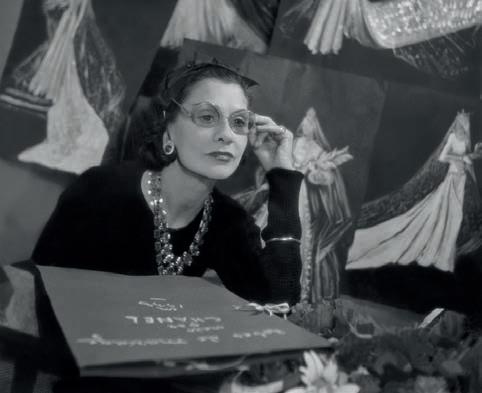
Sportswear and jersey
Restricted nances in the early days necessarily limited the extravagance of her designs, a solution coming when she stole upon the idea of using lowcost jersey as a material. At the time it was more commonly used for men’s undergarments and swimwear, but it was ideal to facilitate Chanel’s style trademarks: ease and comfort. By adding hand-sewn details to the pieces she elevated the humble material into a luxurious fashion statement.
Jersey was just one element borrowed from menswear—others included the use of
Below right Gabrielle Chanel’s 1922 ‘Russian’ tunic sold for a record €100,000 (£86,000) in Paris, image courtesy of Kerry Taylor/Maurice Auction
Bottom right A 1996 Chanel evening coat by Karl Lagerfeld with embroidery by Maison Lesage sold for €220,000 (£189,200), image courtesy of Christie’s Paris

Bottom far right Andy Warhol (1928-1987), Chanel no. 5, screenprint in colours, 1985, sold for £165,500, image courtesy of Christie’s
Four days later, on November 22, a Coromandel evening coat and skirt, designed by Karl Lagerfeld (who was the creative director of Chanel from 1983 until his death in 2018) sold for €220,000 (£189,200).
The ensemble had been worn by the model Kate Moss at The Ritz London for the unveiling of Chanel’s winter 1996 collection.
Last year at Sotheby’s Paris the Chanel crocembossed lambskin tote owned by Lagerfeld, set a world record when it sold for €94,500 ($107,000), making it the most expensive Chanel bag ever sold at auction. Prior to this the record price for a Chanel bag at auction was $32,500 (set in 2018).
This June a screenprint by Andy Warhol (19281987), Chanel no 5, from his 1985 Ads series was the top lot at Bonhams’ prints and multiples sale when it sold for £165,500 outstripping its pre-sale estimate of £80,000-£120,000.

‘As well as clothes Chanel pioneered signature accessories all indelibly associated with the House of Chanel. These include the quilted bag, the two-tone pump, the gilt chain belt, pearl necklaces, and crystal Maltese and Byzantine crosses’
ANTIQUE COLLECTING 45
COLLECTING GUIDES Coco Chanel
Switzerland. But in the ‘50s when Christian Dior’s “New Look” took the fashion world by storm, she felt compelled to return to the industry.
Chanel considered Dior’s celebration of femininity –with its nipped-in waists and fancy ourishes – was at odds with the post-war urge for greater freedom for women.
THE MADEMOISELLE’S LOVE AFFAIRS
Chanel was fiercely independent, never married and always used “mademoiselle” as her preferred form of address. She did however enjoy a number of high-profile love affairs. After Boy Capel died in a car accident in 1919, leaving Chanel devastated, she had an affair with Grand Duke Dmitri Pavlovich, a member of the Russian imperial family. She also had a relationship with the French illustrator and designer Paul Iribe, followed by a romantic involvement with the wealthy British aristocrat Hugh Grosvenor, the Duke of Westminster, who in the 1920s was one of the richest men in the world. Chanel allegedly refused his proposal saying: “There are lots of duchesses, but only one Coco Chanel.” During WWII Chanel was involved with the German Nazi intelligence officer Hans Günther von Dincklage.
the colour black with contrasting white cu s and collar, a reference to dandy fashions.

In 1926, in contrast for the prevailing fashion for white, she introduced her iconic “little black dress”. Chanel believed black was a colour of chic simplicity that could be both practical and fashionable.
While a straight, linear silhouette characterised her designs of the 1920s, her dresses of the 1930s were more gurehugging, feminine and romantic using printed chi ons in her daywear designs and long, slim line shapes for her evening wear.
e comeback
Despite her great success in the ‘30s, in 1939, along with other Paris couturiers, Chanel closed her salon at the start of WWII. Her role in the con ict, including a love a air with a Nazi intelligence o cer, has been questioned. It seems undeniable she “slept with the enemy”, whether to secure the release of her nephew from a POW camp, or to secure her assets.
After the con ict her collaboration with the Nazis put her out of favour with the French public and she spent a decade in exile in
By then Chanel was in her seventies and her relaunch in 1953 was not an critical success. But she persevered. and within three seasons, Chanel was enjoying newfound respect. Soon the classic Chanel two-piece suit was the status symbol for a generation. Jackie Kennedy famously wore a pink Chanel suit with a matching pink pillbox hat on November 22, 1963, in Dallas - the day her husband, the president JFK, was assassinated.
Above left Arthur Boy Capel, said to be Chanel’s biggest love, image public domain

Above Gabrielle Chanel haute couture jacket, it has an estimate of £500£800 at Bonhams’ online sale e Art of Luxury: Chanel from September 11-21

Below left A Chanel, Karl Lagerfeld, haute couture pink tweed skirt suit, has an estimate of £2,500£3,500 at Bonhams’ online sale e Art of Luxury: Chanel from September 11-21

Right Lydia Sokolova and choreographer
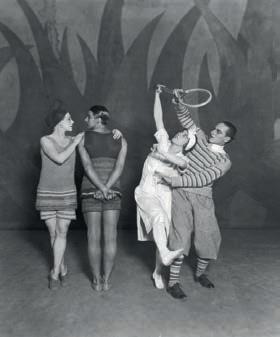
Anton Dolin, Bronislava Nijinska and Leon Woizikowsky after the rst performance of Le Train Bleu at the Coliseum eatre, London, 1924. Photo © V&A, London. © Sasha/ courtesy Getty Images
Below right Gabrielle Chanel, costumes for Le Train Bleu, hand-knitted wool, 1924. © Chanel, photo Nicholas Alan Cope, courtesy of V&A, London
Karl Lager eld
When Karl Lagerfeld took the reins of Maison Chanel in 1983, Chanel had been dead for 12 years, and the brand was struggling. e German-born designer looked to past designs to reinvigorate the failing maison. His designs incorporated signature Chanel details, tweed fabrics, colours, gold chains, quilt-stitched leather, and the linked “CC” logo. He also played with some of the ladylike polish of Chanel’s in the Sixties. His ability to mine Chanel’s archive for inspiration testi es to the fashion house’s contribution to women’s fashion in the 20th century. Once more Chanel was back on the fashion map.
Gabrielle Chanel. Fashion Manifesto is at the Sainsbury Gallery, V&A London, from September 16 to February 25, 2024.
e Blue Train
Chanel’s outfit for The Blue Train, also known as Le Train Bleu, is one of her most iconic ensembles. The train was a luxurious overnight service connecting Calais to the French Riviera, popular among wealthy and fashionable travellers.
In 1924, Chanel famously wore a casual and sporty nautical-inspired outfit when she boarded the train, including a Breton striped sailor shirt and wide-leg trousers and a widebrimmed sun hat with a ribbon or bow detail.
The same year the train became the subject of a one-act ballet choreographed by Bronislava Nijinska, with the libretto by Jean Cocteau for which Chanel designed the costumes.
The ballet’s characters included a tennis player, based on the 1920s French champion, Suzanne Lenglen, and a golf player said to be modelled on the Prince of Wales.
46 ANTIQUE COLLECTING
Q&A
This year Credit Suisse called handbags one of the best collectable investments of 2023 outranking both jewellery and art. We asked specialist Popsy Kundi for her collecting tips when it comes to Chanel
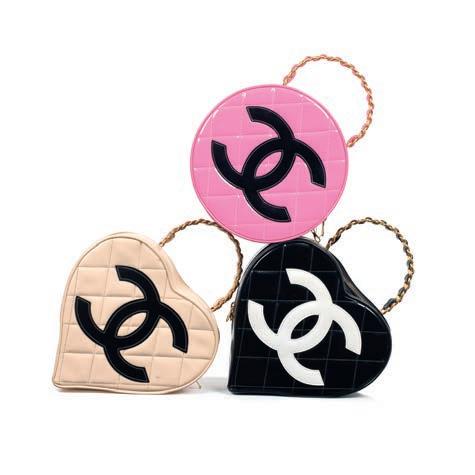
Below left Chanel patent leather round and heart-shaped bag, each estimated at £15,000-£20,000 at Bonhams’ online sale The Art of Luxury: Chanel from September 11-21
Right A Chanel black lambskin jumbo double flap bag, has an estimate of £4,000-£6,000 at Bonhams’ sale
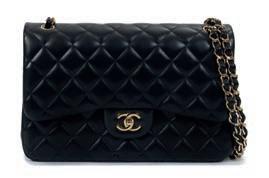
Below right A Chanel Boy bag, image courtesy of Chiswick Auctions

of the recent price increases by Chanel (of up to three per cent a year post pandemic) has seen the secondary market prices increase in line with Chanel’s.
Generally, the price of luxury goods has catapulted at twice the rate of inflation over the past decades. The demand for Chanel pieces is far outweighing supply, with rumours of Chanel limiting the market on new purchases, demand on the secondary market will rise. The house’s decision to stop using exotic skins in 2018 has seen the demand for snake, lizard and crocodile price rises at an expediential rate, with crocodile flap bags listed on pre-loved sites upwards of £20,000.
QWhat are the designs that should be at the heart of a collection?
A The basis for any collector should be the classics such the classic flap bag, a timeless piece and a celebrity favourite; also the original 2.55 flap bag designed by Coco Chanel in 1955; another is the Boy bag introduced in 2011 by Karl Lagerfeld, with its boxy masculine design and named after Coco Chanel’s lover Arthur ‘Boy’ Capel. Another one to look out for is the Chanel 19 bag introduced in 2019 and the last design by Lagerfeld. It has a modern, slouchy silhouette.
QHow does Chanel bags’ investment potential compare to other brands?
AHermès bags, in particular its Birkin and Kelly, have always been the investment bag due to their exclusivity and the way Hermès limits the market making new bags difficult to obtain. However, Chanel has caught up fast with pieces increasing up to 15 per cent a year. Inspired by the success of Hermès’ scarcity strategy, Chanel has raised prices and cut production on their most popular bag, the Chanel flap bag. The twice-yearly price rises by Chanel, post pandemic, has created a huge demand for Chanel.
QHow does style, colour and condition impact the value of Chanel bags?
AAll three have an enormous impact. The iconic classic flap bag should top any collector’s list. Recognisable by its CC logo turn lock, diamond quilted body and chain straps, it was designed in 1983 by Karl Lagerfeld and was his interpretation of the 2.55 created by Coco Chanel in February 1955.
It will increase in value if it’s a vintage piece while modern versions will hold, or increase their value if they are kept long enough. The classic core colours to go for: black, beige, red and white, which are the foundation of the house. Some limited colours from certain collections are also very collectable and will never be released again. Condition is everything, generally bags with gentle use and no visible signs of wear are the pieces which hold their value and are the most sought after.
Q
A
What factors are currently affecting price on the

secondary market?
The secondary market is largely driven by what is happening in the primary market. The influence
Above A Chanel 2010 Métiers d’Art black lucite matryoshka, sold for $32,500, beating its estimate of $4,500-$6,500 on June 19, 2018, image courtesy of Christie’s

Below A Chanel black and white silk scarf ap bag, has an estimate of £2,000-£3,000 at Bonhams sale

QWhat designs would you go for in terms of a long-term v short-term investment?
AMany of the vintage pieces are suitable as a short-term investment. If purchased at the right price they can be turned around quickly, often with some profit. Long-term investment pieces would be limited-production pieces such as from Chanel’s Métiers d’art 2022/2023 collection. These collections showcase the talents of Chanel’s artisans, and bags from them are exquisitely designed. Chanel flap bags are a good long-term investment, but with even mini flap bags retailing from £4,750 you will need deep pockets.
QDo you have a favourite?
AI am an avid collector and have many of the classic flap bags ranging from vintage to modern. The one that got away was a classic flap bag in gold python made before the house stopped using exotic skin. I’ve never encountered another!
QWhat advice have you for a newbie collector?
AAlways buy from a reputable source and ensure the bag has a guarantee of authentication and you are able to view it. Ask for a condition report, wear and tear should be reflected in the price. Start your collection with reasonably priced vintage pieces with the potential to increase in value.
Popsy Kundi is Chiswick Auctions’ head of designer handbags and fashion. Its Designer Edit sale is on September 19 and includes a number of Chanel bags, for more details go to www.chiswickauctions.co.uk

ANTIQUE COLLECTING 47
Discover the secrets of the world’s greatest chefs as well as what makes Grayson Perry tick with this month’s selection of books from our sister publisher ACC Art Books – and save more than a third into the bargain
SIGNATURE
DISHES - 50 CHEFS
SHARE THEIR SECRET RECIPE
BY AMÉLIE VINCENT
ISBN 9789401488303
RRP £55.00
OFFER PRICE £35.75
Every chef has one: a dish that is typical of their kitchen, a dish that is especially meaningful to them. In this book, 50 top chefs reveal their signature dish and its recipe. They also talk about the genesis of the dish, the source of inspiration and – more generally – their love for good food and cooking. This gorgeous book is a must for every foodie and will inspire you to create your own signature dish.

BAROQUE INFLUENCERS - JESUITS, RUBENS & THE ARTS OF PERSUASION
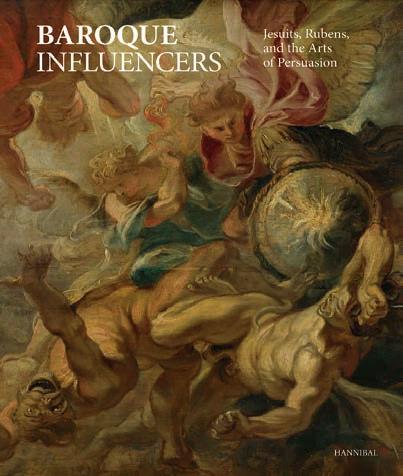 BY PIERRE DELSAERDT|ESTHER VAN THIELEN
BY PIERRE DELSAERDT|ESTHER VAN THIELEN
ISBN 9789464666311
RRP £50.00
OFFER PRICE £32.50
In what ways did the Jesuits deploy the Baroque visual language of the time to persuade the public of their vision on humankind, religion and society? In this beautifully illustrated book, which includes numerous artworks by Peter Paul Rubens and others, diverse authors rise to the challenge of finding answers to this complex question.
THE MEDICI PORTRAITS - AT THE UFFIZI AND GALLERIA PALATINA
 BY ADELE MILOZZI
BY ADELE MILOZZI
ISBN 9788833671789
RRP £14.00
OFFER PRICE £9.10
In this guide, the marvellous works, held in Florence’s Uffizi Gallery and Palazzo Pitti, are presented in chronological order, making it possible to trace the main stages in the history and genealogy of the Medici family.
48 ANTIQUE COLLECTING
SUBSCRIBER EXCLUSIVE
NOW! Email uksales@accartbooks.com, or call 01394 389950. Postage to UK addresses is £6, call for overseas rates.
ORDER
BOOK OFFERS UP TO 35% DISCOUNT
HALF AN HOUR FROM PARIS12 SECRET DAYTRIPS BY TRAIN
BY ANNABEL SIMMS
ISBN 9781843682271
RRP £14.99
OFFER PRICE £9.74
This guide takes the reader to 10 secret destinations easily accessible from central Paris by public transport. The spectacular medieval castle where Henry V died, Napoleon’s private château, dancing in fifties guinguette cafés, a Victorian gunpowder factory – these are just some of the unexpected delights discovered by Annabel Simms just half an hour from Paris.

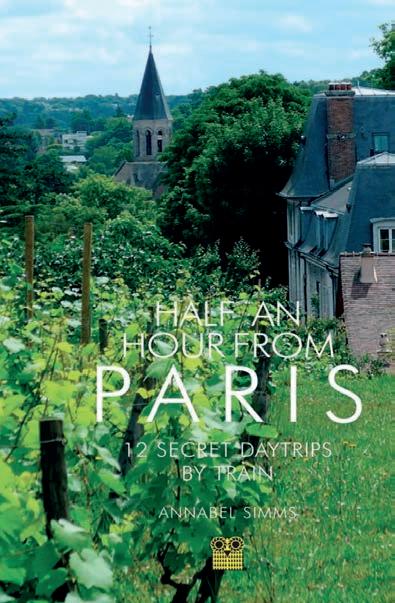
HIMALAYAN ART IN 108 OBJECTS
 BY KARL DEBRECZENY & ELENA PAKHOUTOVA
BY KARL DEBRECZENY & ELENA PAKHOUTOVA
ISBN 9781785514524
RRP £45
OFFER PRICE £29.25
In this beautifully illustrated volume, the fascinating story of Tibetan, Himalayan, and Inner Asian art is illuminated through objects from the Neolithic era to today. Paintings, sculptures, drawings, textiles, architectural structures and more serve as a guide to the historical traditions, rituals, social practices and art forms from Tibetan, Indian, Nepalese, Bhutanese, Mongolian and Chinese regions, emphasising cross-cultural exchange with Tibet at the centre.
GRAYSON PERRY - SMASH HITS
BY GRAYSON PERRY, VICTORIA COREN MITCHELL, PATRICK ELLIOTT, TOR SCOTT
ISBN 9781911054627
RRP £24.99
OFFER PRICE £16.24




Grayson Perry is one of Britain’s most celebrated contemporary artists and cultural figures. This book, which includes first sight of new and previously unpublished works, is published to accompany the largest-ever retrospective of Perry’s art. It offers a vibrant insight into his life and work, from his youth in rural Essex to sell-out stage shows at the Royal Albert Hall.

ANTIQUE COLLECTING 49
Rich Tapestries
UK impressario Andrew Lloyd Webber has loaned two rare tapestries by William Morris to Kelmscott Manor, the designer’s Cotswolds retreat, to raise money for essential restoration work. Antique Collecting reports
In collecting terms many sought-after treasures are known as ‘holy grail’ but two tapestries by William Morris and his friend, the Pre-Raphaelite artist Edward Burne-Jones, currently on show at the former’s summer home, are exactly that. Visitors to the manor, near Lechdale in Oxfordshire, will be greeted by two tapestries from Morris & Co.’s breathtaking Holy Grail series, designed in 1890, and regarded as one of the greatest achievements of the arts and crafts movement. e celebrated polymath Morris is known for his furniture designs, fabrics, stained glass and wallpaper, but he also had a lesser-known obsession – tapestry – which in a lecture in 1888, eight years before his death, he called: “the noblest of the weaving arts: in which there is nothing
Above Morris loved wall-hangings which gave the tapestry room “an air of romance which nothing else would quite do”, image courtesy of Kelmscott Manor


mechanical.” For Morris, tapestries epitomised the purity of medieval craftsmanship. It was like painting with threads, creating the atmosphere of a room – drama, calm or beauty. Morris determined to revive the art, which he believed had “practically perished”.
e manor’s staircase is now the temporary home to three of King Arthur’s knights: Sir Gawaine, Sir Lancelot and Sir Uwaine immortalised on the large-scale works bought by Lloyd Webber, a long-term supporter of Kelmscott, at auction in the ‘90s for £1m. e loan is to help raise £300,000 required to restore the faded Flemish tapestries depicting the Life of Samson that were already hanging in the manor when Morris rented it in 1871.
50 ANTIQUE COLLECTING
THE EXPERT COLLECTOR William Morris tapestries
Right William Morris’s bedroom with Lily wallpaper, image courtesy of Kelmscott Manor
Morris loved these rare 17th-century wallhangings mellowed by age, declaring that they gave the Tapestry Room “an air of romance which nothing else would quite do.” He gravitated there, using it as both a workspace and sitting room. It was tapestries such as these that inspired him to learn the technique himself and set about reinventing it. Plans are underway to carry out essential work on the tapestries and return the room to how it was when photographed in 1896.
e fundraiser has also shone a light on the tapestries created by William Morris himself – works with an incredible history. Some were thought lost for years, with others nding their way into some incredible collections today, including that of Led Zeppelin guitarist Jimmy Page.
Early obsession
How Morris, born to prosperous parents in Walthamstow in East London in 1834, developed an enduring interest in textiles and tapestries is not known. During the second half of the 19th century, tapestries and other old textiles became a feature of antiquarian domestic settings. Tapestry evidently made an impact on the young Morris.
It may have been during a boyhood trip to visit Elizabeth I’s hunting lodge in Epping Forest. Originally built for Henry VIII in 1543, the building included a set of faded verdure tapestries depicting forest scenes, which he remembered as “a room hung with faded greenery”.
Above left Hooded settle and round table designed for Red House. Both were also at Kelmscott House in London (Hammersmith), before being brought to Kelmscott Manor, image courtesy of Kelmscott Manor
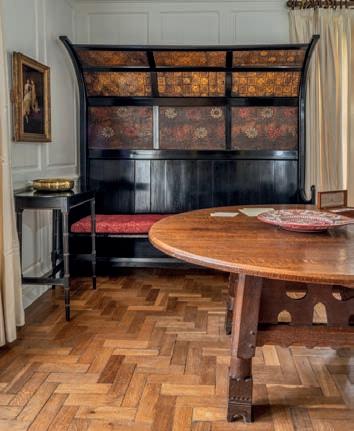
Above right Frederick H. Evans (1853-1943) the Tapestry Room at Kelmscott Manor, image courtesy of Getty
Right Frederick H. Evans (1853-1943) the Tapestry Room as it would have been in Morris’s day, image courtesy of Getty
Below left View of the Green Room painted in its original ‘Brunswick’ green – a blend of Prussian blue and chrome yellow which Morris found “restful to the eyes”, image courtesy of Kelmscott Manor

The Samson Tapestries
The Tapestry Room, in which the Flemish designs hung, had been a feature of the studio of his co-tenant, the artist Dante Gabriel Rosetti, in the room he used as studio. When their joint tenancy ended in 1874, the panels stayed in place.


In March 1896
Morris commissioned his friend and leading art photographer Frederick Evans to create a photographic portrait of the manor, providing the blue print which the Society of Antiquaries of London, which owns and runs the manor, is hoping to recreate today.
Evans photographed the room from a number of perspectives, giving us a complete view of how the tapestries were hung at that date. Morris wrote of the tapestries: “They were never great works of art and now when all the bright colours are faded out and nothing is left but the indigo blues, and greys and the warm yellow browns, they look better.”
e textiles made an enormous impression on the young Morris who later said: “Yes, that was more than upholstery, believe me.”
Meeting of minds
It was while reading theology at Exeter College, Oxford, that Morris met Edward Burne-Jones in 1853. ey devoured the work of the Romantic poets and also discovered Malory’s Le Morte D’Arthur, sparking an enduring interest with everything medieval.
Vacation trips to France in 1855 a orded the pair a glimpse of medieval tapestries in the cathedrals of Amiens, Beauvais and Chartres. It was, according to author Linda Parry, on the last night of their holiday while walking on the quay at Le Havre that the friends decided to shelve any ideas of entering the clergy, quit college and “begin a life of art”.
Morris soon decided that his forte was not painting and became articled to the architect G.E. Street, but he was drawn towards design and making, establishing Morris, Marshall, Faulkner and Co. in 1861 to pursue the manufacture of so-called ‘applied arts’. is became Morris & Co. in 1875, showcased by a shop on London’s Oxford Street.
‘The Stanmore Hall weaving of Morris’s The Attainment was purchased by the Led Zeppelin guitarist Jimmy Page in 1978; the piece failed to meet its reserve at auction in 2008 and remains in Page’s collection’
ANTIQUE COLLECTING 51
THE EXPERT COLLECTOR William Morris tapestries
Left Stairs at Kelmscott Manor where two of Andrew Lloyd Webber’s Holy Grail tapestries by William Morris are on view, image courtesy of Kelmscott Manor
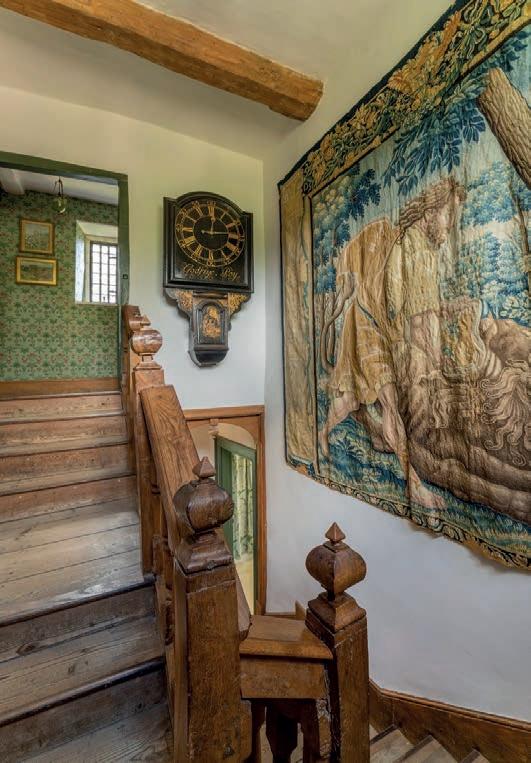
Below right Flora, tapestry, 1884-1885, the gure designed by BurneJones, the ground and borders by Morris, image courtesy of S Franses

Below left Jane Morris’s bedroom with Fruit wallpaper, image courtesy of Kelmscott Manor

Morris was a ne botanical draughtsman and the design recalls the Epping Forest tapestry he saw as a boy.
At the time of his rst weaving most tapestry was lowwarp where the frame and warp were parallel to the oor. Morris felt that this resulted in poor quality design.
In high-warp looms, the warp threads are set vertically in a vertical frame. e weaver must lift the warp threads to pass a bobbin through them. e technique allowed Morris to achieve the highly detailed designs he wanted.
He used wool as standard, with silk threads giving shimmer, which was used in owers and garments. Mohair and camel hair were used to give texture, especially for animals.
After weaving Acanthus and Vine, today part of the manor’s collection, Morris set up two looms at Queen Square where he passed on his new-found skills to John Henry Dearle, then aged 19, as an apprentice.
e move to Merton Abbey in 1881 allowed larger tapestries to be made. ere were three looms, each requiring three weavers.. e rst, from a drawing by Walter Crane was called e Goose Girl
Two early works, from a design by Burne-Jones, were of the goddesses Flora (below) and Pomona, which saw Morris designing the background foliage himself.
Move to tapestry
From 1878 to 1892, when Morris started to devote himself to the Kelmscott Press, he devised a plan to revive the ancient craft of high-warp tapestry weaving – a skill which had died out a century prior. Morris was fascinated by trying to understand medieval and Renaissance techniques. In order to do so he consulted a series of technical manuals (Arts et Métiers), published by the Paris Académie des Sciences.
In 1879, he installed a tapestry loom in his bedroom in Kelmscott House in London, where he designed and wove Acanthus and Vine, a near-symmetrical composition of birds amid scrolling leaves, which he nished approximately four months later.
COLLECTING
52 ANTIQUE
e Holy Grail tapestries
In 1886, Morris & Co. was commissioned to decorate Stanmore Hall in Middlesex, the home of the a uent mining engineer William Knox D’Arcy who wanted the dining room to be the sumptuous centre of the lavish interior.
e commission called for a suite depicting the 15thcentury legend of King Arthur. Burne-Jones created the main design, while Morris worked on the heraldry elements, with John Henry Dearle making recommendations for colours and adding foreground and background details.
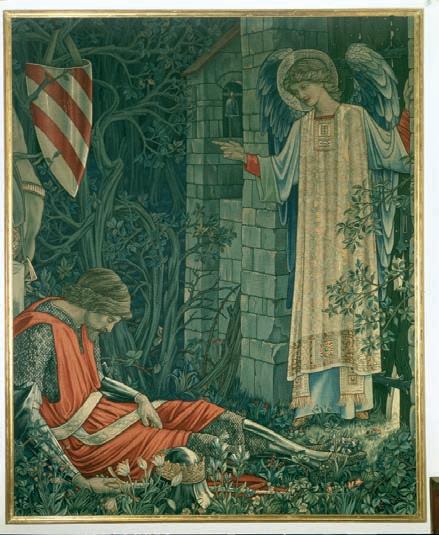
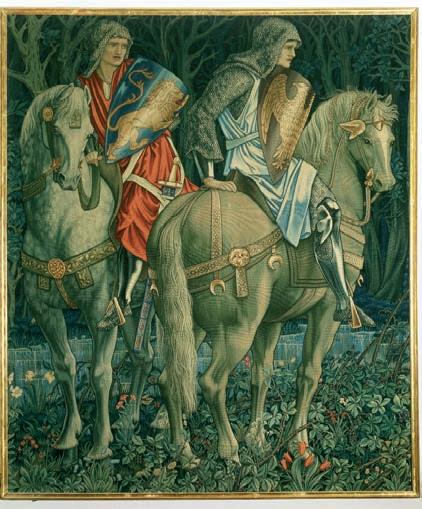
e tapestries cost £3,500 (£318,000 today); BurneJones received £1,000 as his fee for the design. e rst of the six narrative tapestries ( e Attainment) was completed in 1893, with three people working on the remaining ve over a period of two years.
Finally completed in 1895, the remaining ve panels were made up of e Knights of the Round Table Summoned to the Quest by the Strange Damsel; e Arming and Departure of the Knights; e Failure of Sir Launcelot to enter the Chapel of the Holy Grail; e Failure of Sir Gawaine and e Ship.
Reproductions and reprises
e original set remained at Stanmore Hall until D’Arcy’s death in 1920 when they were sold and dispersed. One ( e Attainment) was purchased by the Led Zeppelin guitarist Jimmy Page in 1978; having failed to meet its reserve at auction in 2008 it remains in Page’s collection.
Morris & Co. wove a second subset of the narrative panels ( e Arming and Departure of the Knights; e Failure of Sir Gawaine and e Attainment) for Laurence Hodson of Compton Hall in Wolverhampton which were acquired by the Birmingham Museums Trust (BMT) in 1907. In 1898 and 1899 a third complete set was woven for George McCulloch a colleague of Knox-D’Arcy who
Below e Failure of Sir Launcelot to enter the Chapel of the Holy Grail, from the Holy Grail tapestry series woven for George McCulloch between 1898-1899, © Lord Lloyd Webber
William Morris life and times
Born at Elm House in Walthamstow, then a village in Essex, now part of London, William Morris lived in various places throughout his life. Red House, Bexleyheath: In 1859, Morris commissioned architect Philip Webb to design and build Red House, which became his family home. It is located in Bexleyheath, in south-east London. The Red House was significant as it marked the beginning of the Arts and Crafts Movement, in which Morris played a central role.
Kelmscott House, Hammersmith: Morris lived at Kelmscott House, located on the River Thames in Hammersmith, London, from 1878 until his death in 1896. The house was named after Kelmscott Manor, his Oxfordshire country home that provided inspiration for much of his work.
Kelmscott Manor: While not his primary residence, from 1871, Morris spent considerable time at Kelmscott Manor, a country retreat located in the Cotswolds. The house was a source of inspiration for many of his designs and writings.
Right Kelmscott Manor in Oxfordshire was the Morris family’s summer retreat, image courtesy of Kelmscott Manor

Below right e tapestries hanging in the dining room of Stanmore Hall, image public domain

had presumably been impressed by the originals in situ. Summoned to the Questby the Strange Damsel from this set was acquired by BMT in 1980, the other four having been acquired at Christie’s by Andrew Lloyd Webber in 1994 for£1m, two of which are on show at Kelmscott Manor.
For more details on visiting Kelmscott Manor or to donate to the appeal go to www.kelmscottmanor.co.uk.
ANTIQUE COLLECTING 53
Left e Failure of Sir Gawaine from the Holy Grail tapestry series, woven for George McCulloch between 1898-1899, © Lord Lloyd Webber Collection
ANTIQUES UNDER THE HAMMER Lots in September




TOP of the LOTS
A pair of extinct New Zealand huias, one male (with a shorter beak) and one a longer-beaked female, has an estimate of £15,000-£25,000 at the North Yorkshire auction house Tennants’ natural history and taxidermy sale on September 8.
The pair was mounted in Victorian times by James E. Whiting, naturalist, of 19 Heath Street, Hampstead, and are presented perched on a branch and surrounded by hummingbirds, rocks and foliage.
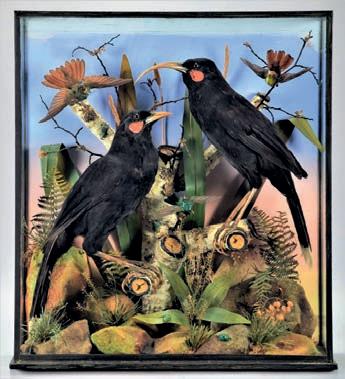
Huias were much prized as taxidermy specimens, with their tail feathers also sought after for millinery uses. This demand, coupled with the widespread deforestation of their natural habitat by European settlers, caused the species to be driven to extinction. The last confirmed sighting of a huia was in 1907, although there was said to be another sighting as late as 1924.
Princess Di’s iconic “black sheep” jumper, worn in June 1981 by the recently-engaged Diana at one of Prince Charles’s polo matches, has an estimate of £40,000-£80,000 at Sotheby’s fashion icons online sale in New York ending September 14.
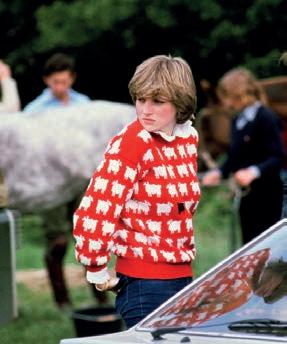
One of the first pieces created by Sally Muir and Joanna Osborne and their knitwear label Warm & Wonderful, the sweater took the world by storm when it was said to be a nod from Diana on how she saw herself in the royal household.
herself

In 2020, a replica of the sweater appeared in the fourth season of Netflix’s series, The Crown, worn by actress Emma Corrin. Sotheby’s currently holds the record for the most valuable Princess Diana dress ever sold – a strapless evening dress made of deep aubergine silk velvet – which achieved $604,800 (£475,000) in January 2023.

A William and Mary silver porringer, or bleeding bowl, has an estimate of £1,000-£1,500 at Kinghams Auctioneers, in Moretonin-Marsh, inaugural silver and objects of vertu sale on September 8.
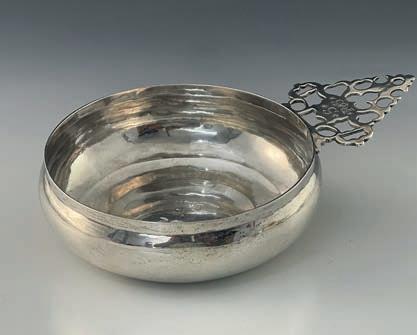
A pierced foliate trefoil handle is with the base marked with a lion passant and the sponsor’s mark MH below a crown, London 1691.
A porringer is a shallow, two-handled bowl historically used for various purposes, including serving food, although it had a more gruesome job in bloodletting, which was a widespread medical practice based on the belief that balancing the four humours (blood, phlegm, yellow bile and black bile) could restore health.
Porringers often had decorative elements with some featuring the owner’s initials or family crest.
A c. 1750 Jacobite air twist wine glass, engraved with a rose and thistle has an estimate of £3,000-£4,000 at BonhamsEdinburgh’s Scottish and Celtic sale on September 14.

Wine glasses were a way for Jacobite sympathisers to express their allegiance to the exiled Stuart monarchy Bonnie Prince Charlie and his father James Francis Edward Stuart. The best examples were engraved with various Jacobite symbols including roses and thistles (the emblems of England and Scotland), along with the Latin inscription Floreat Rex or Fiat Justitia, which means Let the king flourish or Let justice be done
A rare glass planter in the shape of a canoe by the celebrated art nouveau maker Emile Gallé (1846-1904) has an estimate of £2,000-£3,000 at Catherine Southon’s sale at Farleigh Court Golf Club in Surrey on September 13.
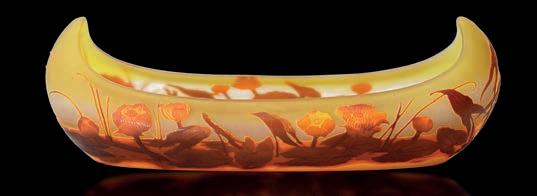
Born in Nancy in 1846, Gallé is known for his pioneering techniques in cameo glass, carved to create intricate designs and images.
Gallé was also a knowledgeable botanist, inspired by the number of horticulturalists who settled in Nancy in the mid 19th century and became specialists in creating new varieties of hybrids, including peonies, lilacs, clematis, gladioli and begonias – many of which appear in Gallé’s glass designs.
54 ANTIQUE COLLECTING
Above e late 19th-century New Zealand Huias are by James E. Whiting, London
Above right e Princess of Wales wearing the “Black Sheep” jumper image Tim Graham, Getty Images
to
(the emblems of England and Scotland), along with the Latin
One of Princess Diana’s most iconic jumpers is up for sale this month, along with the collection of Diana Steel, founder of the Antique Collectors Club
Above e 17th-century porringer is 21cm long and could have had various uses
Above right Jacobite wine glasses are highly sought after by collectors
TheSuffolk auction h ouse Bishop & Miller start s it s “collections series” of four sales this month, including that of Diana Steel one of the founders of the Antique Collectors Club (ACC) and the co-editor of this magazine when it launched in 1966.
Diana died in 2022 aged 82 and the majority of the collection comes from herhome in Woodbridge, Suffolk
Started by three friends (including Diana’s husbandJohn and the former magazine editor John Andrews) the trio of enthusiasts printing pamphlets on a kitchen table sharing information designed to appeal to fellow collectors.
Under Diana’s tenure the ACC went on to become one of the leading publishers of books on antiques and decorative arts, with authors including specialists and experts in the art world.
She later expanded the business, now ACC Art Books,into the US and the rest of the world.
Bishop &Miller’s director, Oliver Miller, said: “This is an outstanding private collection from a true devotee of fine antiques. The collection has been amassed over a number of years and it shows inits fine quality and selective objects within it.”
Highlights include a late 17th-century walnut and marquetry longcase clock, by James Clowes of London which has an estimate of £6,000-£10,000. Also on sale at the auction house’s Stowmarket saleroom on September 28 is a 17th-century English Delft Adam and Eve charger which has an estimate of £500-£700.
Other lots include aGeorge I walnut side chair, which has a pre-sale guide price of £300-£500 and a George I walnut and boxwood strung chest of drawers which is ex ected to make £400-£600. A Victorian album featuring a of early antipodean photographs, many annotated by hand, ranging from Government House in Melbourne to Fijian police in 1880 has an estimate of £700-£1,000.
Brian Watson glass collection
On September 27 the collection of the Norfolk-based glass specialist Brian Watson, who died this year, goes under the hammer in Stowmarket.
The collection was built up by the former primary teacher turned dealer and his wife, Gill, over 30 years and includes a rare 2nd-3rd century Roman glass cinerarium which has an estimate of £2,000-£4,000.

Glass funerary urns were considered a prestigious way to memorialise the dead and the domain of wealthy and elite members of Roman society. At this time Roman glassmakers had reached incredible artistic heights with both free-blown vessels and mould blown forms.
The third collection comes from the Herefordshire country home of Eyton Court with a particular highlight being a late 16th-century Flemish Oudenaarde tapestry, which has a pre-sale guide price of £6,000-£8,000. Miller called it “a collection that has been bought together with a keen eye and love for the objects.”

Another lot set to attract bidders is a coastal painting by the celebrated Yorkshire-born artist Donald McIntyre (1923-2009) who spent much of his life in Wales which has an estimate of £3,000£5,000 at the sale on September 29.

The fourth sale in the collections week is The East Anglian, at Bishop & Miller’s Norfolk saleroom in Glandford on September 2

1 A rare Roman glass cinerarium, 2nd-3rd century AD from the Brian Watson glass collection has an estimate of £2,000-£4,000 at the sale in Stowmarket on September 27 2 A late 17th-century walnut and marquetry longcase clock, by James Clowes of London, from the Diana Steel Collection, has an estimate of £6,000-£10,000 at the Stowmarket sale on September 28 3 At the same sale a 17th-century Adam and Eve Delft plate has an estimate of £500-£700 4 Donald McIntyre (1923-2009) Dragging a Coble Ashore, from the Eyton Court Collection, has anestimate of £3,000-£5,000 at the sale in Stowmarket on September 29 5 A good late 16th-century Flemish Oudenaarde tapestry from the same collection has an estimate of £6,000-£8,000 at the same sale
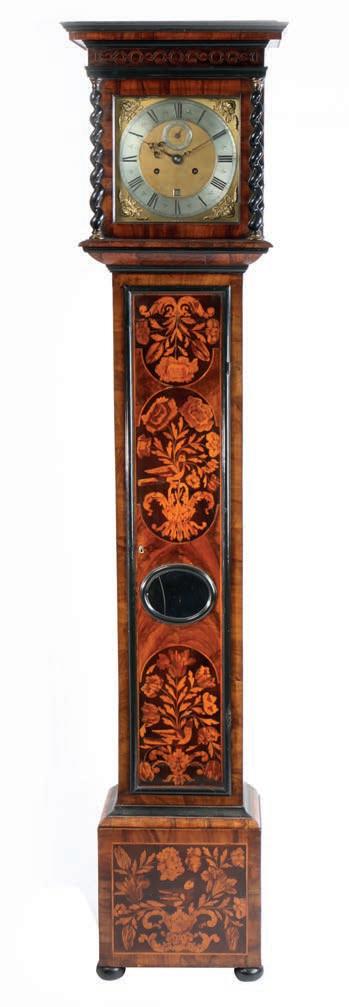
55 1 4
An Auctioneer’s Lot
relatives. Like them, he was renowned for developing new techniques and brimmed with business acumen.
By the mid-18th century, omas and John had made their mark. ey were more enterprising than most. anks to experimentation, they improved the quality of their pottery, sparking a rapid increase in demand. ey also traded directly with Liverpool and London rather than supplying goods to hawkers.
Burslem Big House
Josiah Wedgwood (1730-1795) is a name most people know, he was the world-renowned potter, entrepreneur and founder of the Wedgwood company in 1759. anks to his talent and ambition, he led the industrialisation of European pottery manufacturing during the Industrial Revolution, e ectively putting the Stoke town of Burslem on the map for pottery production.
Another from the same dynasty, omas Wedgwood (1703-1776), Josiah’s older cousin was another vital name in the Wedgwood story, although his contribution in saltglazed stoneware is far less recognised.

When an 18th-century glass wine bottle honouring omas came to light, I knew it was something special. e inscription on the bottle’s collar, states: omas Wedgwood of the Big House, Burslem, Sta ordshire. Born 1703. Died 1776. Such is its importance in the history of UK pottery it could make £8,000 at auction next month and I would be delighted if it found its way into a museum – it would certainly deserve its place.
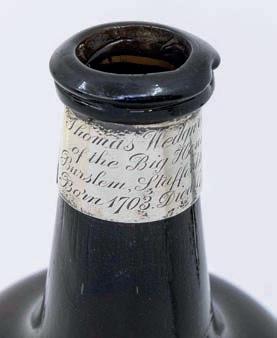
Business mind
e entrepreneurial spirit that ran through the Wedgwood family veins was particularly present within omas who became a giant in terms of his impact upon the early days of Sta ordshire Potteries.
In 1743, omas and his brother, John (1705-1780), took over their father’s potworks in Burslem. At the time Josiah Wedgwood would have been 13. It’s hard to imagine that he would not have been in uenced by their success.
One can only wonder what advice the brothers may have given their young cousin Josiah in those early days of the ceramics industry. While Josiah went on to achieve great success he must surely have been inspired by his older
Expansion was necessary in the shape of a new factory and Georgian property in Burslem, which was so extravagant it was called the ‘Big House’. e brothers’ rent book shows that between 1740 and 1767 they spent £13,000 on the acquisition of land, houses and buildings. at would have been equivalent to spending around £1.5m today. At the time £13,000 could have bought you 1,897 horses or paid 130,000 days’ wages.
Simeon Shaw in his History of the Sta ordshire Potteries, 1829, states: “ e excellent productions they now sent forth were so much in demand, that they erected a new manufactory… Of the White Stone ware they now made dishes, plates, and common vessels, also some elegant fruit baskets, bread trays, &c glazed with salt, and probably cast in moulds…
“ e White Stone ware was varied into a better Tortoiseshell, by rubbing manganese upon the vessels before they were glazed; for a di erent kind of ground za res were applied with either a sponge or hair pencil; and similar application of calcined copper, iron, and other metals, produced Cauli ower, and Melon ware, &c.”
Every new Wedgwood invention – green glaze, creamware, black basalt, and jasperware – was quickly copied and the manufactory soared to international success under Josiah. But its worthwhile remembering the genius of all the Wedgwoods, as this bottle so clearly does.
e omas Wedgwood bottle will be o ered in Hansons’ autumn ne art sale on October 5-6.
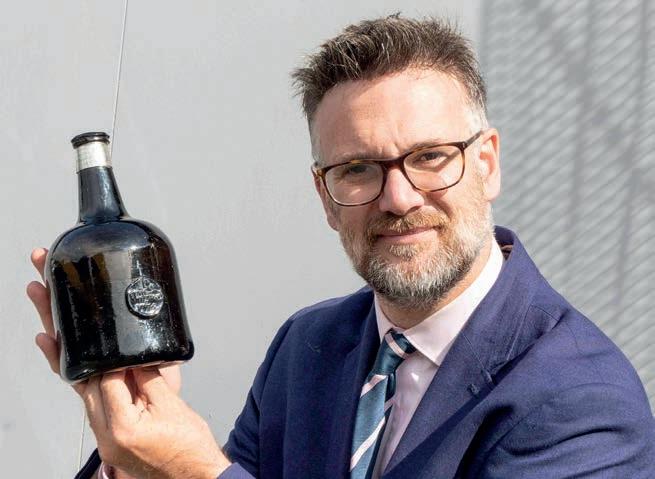
56 ANTIQUE COLLECTING
Charles Hanson raises a glass to a bottle honouring one of the Wedgwood dynasty’s lesser-known members – the pioneering potter omas Wedgwood
‘Such is its importance it could make £8,000 at auction next month and I would be delighted if it found its way into a museum –it would certainly deserve its place’
Top right omas’s name and the date 1775 is embedded in the glass, photo credit Mark Laban, Hansons
Above right omas’s name is also on the silver collar and embedded in the glass, photo credit Mark Laban, Hansons
Above Charles Hanson with the 18th-century glass wine bottle honouring omas Wedgwood
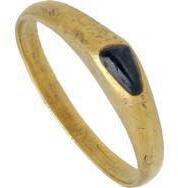





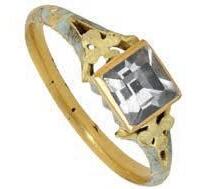
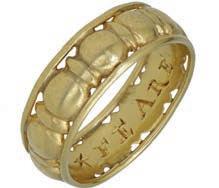










FORTHCOMING AUCTION JEWELLERY, WATCHES & OBJECTS OF VERTU TUESDAY 12 SEPTEMBER AT 11 AM TO INCLUDE A SELECTION OF EARLY RINGS ALL ENQUIRIES PLEASE CALL 020 7016 1700 OR EMAIL JEWELLERY@NOONANS.CO.UK NOONANS MAYFAIR 16 BOLTON STREET MAYFAIR LONDON W1J 8BQ WWW.NOONANS.CO.UK A 4TH CENTURY ROMANOBRITISH GOLD FINGER RING ESTIMATE £3,400–£3,000 AN EARLY 17TH CENTURY ENAMEL AND ROCK CRYSTAL RING ESTIMATE £3,000–£5,000 A MEDIEVAL LATE 13TH/EARLY 14TH CENTURY GOLD AND SAPPHIRE SET STIRRUP RING ESTIMATE £5,000–£7,000 A LATE 16TH/EARLY 17TH CENTURY HEAVY GOLD POSY RING ESTIMATE £1,600–£2,000 A LATE 13TH/EARLY 14TH CENTURY GOLD, DIAMOND AND AMETHYST RING ESTIMATE £4,000–£6,000 Malvern Flea & Collectors Fair Three Counties Showground, Worcs. WR13 6NW. Entrance 7.30am-3.30pm - £5 Holiday Monday 28th Aug Sunday 17th Sept Please check www.b2bevents.info in case dates have changed or been cancelled Tel: 01636 676531 www.b2bevents.info Hundreds of indoor and outdoor stalls offering everything from furniture through to toys. A fair not to be missed! THE NORTHERN ANTIQUE DEALERS FAIR LIMITED www.northernfair.com 01797 252030 28 Sept - 1 Oct 2023 Thursday 11.00 -18.00 Friday - Sunday 11.00 -17.00 To request a complimentary invitation for two please email AC@northernfair.com THE NORTHERN ANTIQUESFAIR EST. 1951 FINE ART DESIGN INTERIORS The Garden Rooms at Tennants Harmby Road, Leyburn North Yorkshire DL8 5SG www.doweswealthmanagement.co.uk Supported by ANTIQUE COLLECTING 57
FAIR NEWS
Abstract thinking
The Saatchi Gallery on London’s King’s Road is the location for the 32nd edition of British Art Fair from September 28 to October 1. Since it launched in 1988 the event has celebrated artists including Bridget Riley, Francis Bacon, Henry Moore, Barbara Hepworth, David Hockney, Terry Frost and John Piper, with many works released to the art market especially for the event. More than 70 dealers are set to take part including Osborne Samuel, Jonathan Clark, Redfern Gallery and the Fine Art Society.
To mark its return to the fair Whitford Fine Art will be presenting works by renowned British Abstract expressionist Albert Irvin (1922-2015), covering the period in his development from the early 1950s to the mid 1960s.

It’s a steal
Following a spate of thefts at fairs and markets around the country, Adams Antiques Fairs, which hosts a weekly event in London, has increased security on site.

A number of CCTV cameras have been added to the Royal Horticultural Halls where the fair takes place every Sunday.
A fair spokesperson said: “If you are working on your own ask a porter to take your stock to and from your vehicle. Their flatbed trolleys can take stock to and from the venue and will even pack your car.”

They also called on exhibitors to vary their departure times and route to and from the venue. The move comes after thieves got away with jewellery worth up to £50,000 when they targeted a dealer from Tara’s Hall Antiques as she was loading her car in nearby Greycoat Street. Anyone with information should contact the Met police by calling 101 quoting crime reference number 6551111.
Launch event
The antique furniture expert and author Christopher Payne will present a talk on his new book on the second day of the prestigious LAPADA (London and Provincial Antique Dealers’ Association) fair taking place from September 27 to October 1 at its home – a purpose-built pavilion in Mayfair’s Berkeley Square.

Payne will unveil his latest title, British Furniture 1820-1920 The Luxury Market, published by ACC Art Books, at 10.30am on September 28 on the stand of the Kensington gallery, Butchoff Antiques, which supplied a number of images for the book.
The landmark publication is arguably the first to assess British furniture design throughout the Victorian period, including the makers Gillows, Maples, Holland & Sons and Morris & Co.
Other dealers taking part in the event include Architectural Heritage, Hatchwell Antiques and VKD Jewels. Fair organiser, Freya Simms, said: “Our mission is to promote the joy of collecting, providing a platform for our exhibitors to share their knowledge.”
Northern charm
For the third year the Garden Rooms at the North Yorkshire auction house Tennants is the backdrop for the Northern Antiques Fair from September 28 to October 1.
Up to 40 dealers from around the UK will be taking part in the event with a number native to the North, including Lancashire-based Carnes Fine Art, Graham Ruddock from Barnard Castle and Keighley-based Mark Buckley Antiques.
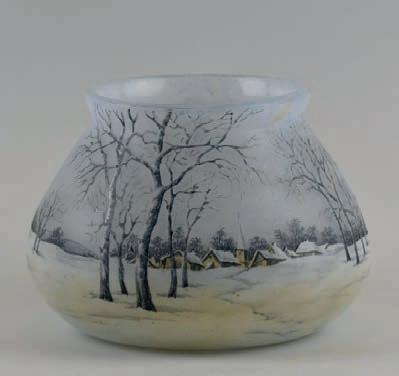
The event promises a mix of antique and contemporary works of art from the UK’s leading antiques and fine art dealers, with prices ranging from a few hundred pounds to five-figure sums.
The fair has been running since 1951, firstly in Harrogate and for the last two years at Tennants in Leyburn.
58 ANTIQUE COLLECTING
Above A.W.N. Pugin gothic revival oak centre table, c. 1828, which both appears in Payne’s book and will be o ered for sale by Butcho at this month’s fair
Above Albert Irvin RA (1922-2015) Untitled 9, c. 1965, oil on canvas, will be o ered by Whitford Fine Art at this year’s event
Above Security has been stepped up at the Horti
Two events are set to wow visitors to the capital, while a agship northern antiques fair returns to its popular home
AND ABOUT September
OUT
Above A Daum vase, c. 1900-1910, of a Dutch winter landscape. It is on o er from Solo Antiques priced £6,750
FAIRS Calendar
Because this list is compiled in advance, alterations or cancellations to the fairs listed can occur and it is not possible to notify readers of the changes. We strongly advise anyone wishing to attend a fair especially if they have to travel any distance, to telephone the organiser to confirm the details given.
LONDON:
Inc. Greater London
Adams Antiques Fairs
020 7254 4054
www.adamsantiquesfairs.com
Adams Antiques Fair, The Royal Horticultural Halls, Elverton Street, SW1P 2QW, Sept 10
Etc Fairs
01707 872 140
www.bloomsburybookfair.com
Bloomsbury Book Fair, Turner Suite at Holiday Inn, Coram Street, London, WC1N
1HT, Bloomsbury Book Fair, Sept 3
Bloomsbury Ephemera Fair, Sept 24
LAPADA
020 7823 3511
lapadalondon.com
LAPADA Art & Antiques Fair
Berkeley Square, London, W1J 6BR, Sept 27 - Oct 1
Sunbury Antiques
01932 230946
www.sunburyantiques.com
Kempton Antiques Market, Kempton Park Race Course, Staines Road East, Sunbury-on-Thames, Middlesex TW16 5AQ, Sept 12, 26
Wimbledon Antiques Market, Prince Georges Playing Fields, Bushey Road, Raynes Park, London, SW20 8TE, Sept 3
SOUTH EAST & EAST ANGLIA: including Beds, Cambs, Essex, Hertfordshire, Kent, Norfolk, Suffolk, Surrey, Sussex.
Blackdog Events
01986 948546
www.ablackdogevent.com
The Grand Brocante at Culford Hall, Culford Hall School, IP28 6TX, Sept 10
Castlewood Antique Fairs
01933 353517
The 9th Three Counties Antiques & Fine Art Fair, The Rufus Centre Flitwick, Bedfordshire MK45 1AH, Sept 9-10
Continiuity Fairs
01584 873634
www.continuityfairs.co.uk
Antique Fair at Epsom, Epsom Downs Racecourse
Tattenham Corner Rd, Epsom KT18 5LQ, Sept 19
Dovehouse Fine Antiques Fair
07952689717
dovehousefineantiquesfairs.com
Antiques and Decorative Arts Fair, Dorking Halls, Reigate Road, Dorking, Surrey, RH4 1SG, Sept 24
Grandmas Attic Antique and Collectors Fairs
www.grandmasatticfairs.co.uk
Antique and Collectors Fair, The Grange Centre, Bepton Road, Midhurst, GU29 9HD, Sept 10
Love Fairs
01293 690777
www.lovefairs.com
Lingfield Antiques, Vintage and Collectables Fair, Lingfield Park Racecourse, Racecourse Road, Lingfield. Surrey. RH7 6PQ, Sept 23
The Pantiles, Royal Tunbridge Wells. Kent. TN2 5TN, Sept 2-3
Marcel Fairs
07887648255
www.marcelfairs.co.uk
Antique and Collectors Fair, Sarratt Village Hall, The Green, Rickmansworth, Herts WD3 6AS, Sept 10
Antique and Vintage Fair –Eagle Farm Road, Biggleswade, Bedfordshire, SG18 8JH, Sept 17
SOUTH WEST including Berkshire, Buckinghamshire, Cornwall, Devon, Dorset, Gloucestershire, Hampshire, Isle of Wight, Oxfordshire, Somerset, Wiltshire.
Arun Fairs
07563 589725
Emsworth Antiques and Collectors Fair, Emsworth Community Centre., North Street, Emsworth, Hampshire, PO10 7DD, Sept 10
Continiuity Fairs
01584 873634
www.continuityfairs.co.uk
Matford, Matford Centre
Matford Park Rd, Marsh Barton, Exeter EX2 8FD, Sept 30
Grandmas Attic Antique and Collectors Fairs
www.grandmasatticfairs.co.uk 07960 502508
Village Hall, Highwood Road, Brockenhurst, SO42 7RY, Sept 24
EAST MIDLANDS including Derbyshire, Leicestershire, Lincolnshire, Northamptonshire, Nottinghamshire, Rutland.
Arthur Swallow Fairs 01298 274493 asfairs.com
Vintage Flea Market, EXO Centre, Lincolnshire Showground, Lincoln, LN2 2NA, Sept 17
IACF 01636 702326
www.iacf.co.uk
Newark International Antiques Runway Monday at Newark Antiques and Collectors Fair, Newark and Nottinghamshire Showground, Newark, Nottinghamshire, NG24 2NY, Sept 18
Stags Head Events
07583 410862
www.stagsheadevents.co.uk
Naseby Antiques, Vintage & Motor Vehicle Fair
Naseby Hall & Grounds
Northampton, NN6 6DE, Sept 9-10
Antiques & Vintage Fair
Coalville Leisure Centre
Stephenson Way
Coalville, LE67 3FE, Sept 16
WEST MIDLANDS
including Birmingham, Coventry, Herefordshire, Shropshire, Staffordshire, Warwickshire, Worcestershire
Ampfairs 01283 820151
Powick Stamps And Postcards Fair, Powick Village Hall, Powick, Near Worcester, Worcestershire, WR2 4RT, Sept 2
WALES
Continiuity Fairs 01584 873634
www.continuityfairs.co.uk
Royal Welsh Showground
Llanelwedd, Builth Wells
LD2 3NJ, Sept 2-3
Derwin Fairs 07790 293367
Llandeilo Antiques and Vintage fair, Civic Hall, Crescent Road, Llandeilo, Carmarthenshire, SA19 6HY, Sept 2
NORTH including Cheshire, Cumbria, Lancashire, Northumberland, Tyne and Wear, Yorkshire.
Arthur Swallow Fairs 01298 274493 asfairs.com
Decorative Home & Salvage Show, Ripley Castle, Ripley, Harrogate HG3 3AY, Sept 8 Antiques & Salvage Market, The Royal Cheshire County Show Ground, Clay House Farm, Flittogate Lane, Knutsford WA16 0HJ, Sept 23
The Northern Antiques Fair 01797 252030 www.northernfair.com
Tennants, Harmby Road, Leyburn, North Yorkshire DL8 5SG , Sept 28 - Oct 1
V&A Fairs 01244 659887 www.vandafairs.com
Nantwich Town Square Antiques Market, Nantwich Town Centre, Cheshire, CW5 5DH, Sept 9
Nantwich Civic Hall Antique and Collectors Fair, Civic Hall Nantwich Beam Street, Nantwich, Cheshire England, CW5 5DG, Sept 21
SCOTLAND
Glasgow, Antique, Vintage & Collectors Fair
07960 198409
Bellahouston Leisure Centre, 31 Bellahouston Drive, Glasgow, G52 1HH, Sept 17
IRELAND
Waterford Antiques, Vintage & Collectables Fair +353 85 862 9007
Navan Antiques, Vintage & Collectables Fair, Ardboyne Hotel Dublin Rd, Navan, Sept 3
Naas Antiques & Vintage Fair Osprey Hotel Devoy Quarter, Kildare Sept 10
SPECIALIST GLASS
ANTIQUE COLLECTING 59



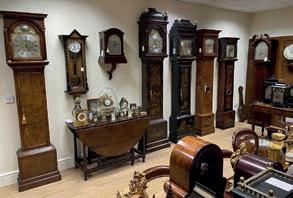
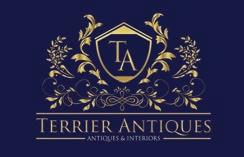
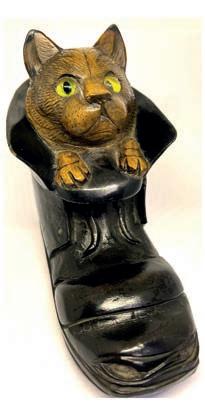

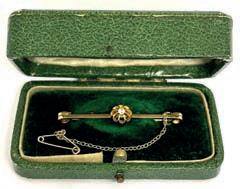
60 ANTIQUE COLLECTING Coachmans Holiday Co ttage and The Antiques Source Country House StyleCreated with Antiques in WestWiltshire he Perfect Self-Catering etreat for Guests inthe Village of Steeple Ashton Contact Penny Email: phornseys@gmail.com or Tel: 01380 870764 for Antique Sales or Bookings www.coachmans cottage.com www.theantiquessource.co.uk Whaley Bridge, High Peak, Derbyshire Tel: 07767 617507 or 01663 733209 www.antique-clock.co.uk The Chimes Antique Clock Centre For a superb selection of over 100 Genuine Antique longcase, wall, and bracket clocks Open 7 days by appointment 01422 843189 o ce@terrierantiques.co.uk www.terrierantiques.co.uk QUALITY ANTIQUES & OBJETS D’ART 26 Market St, Hebden Bridge, West Yorkshire, HX7 6AA
AUCTION Calendar
Because this list is compiled in advance, alterations or cancellations to the auctions listed can occur and it is not possible to notify readers of the changes. We strongly advise anyone wishing to attend an auction especially if they have to travel any distance, to telephone the organiser to confirm the details given.
LONDON: Inc. Greater London
Adam Partridge The London Saleroom, The Auction Room , Station Parade, Ickenham Road, West Ruislip HA4 7DL, 01895 621991
www.adampartridge.co.uk
Antiques and Fine Art, Sept 5
Bonhams 101 New Bond St, London, W1S 1SR, 020 7447 7447
www.bonhams.com
Old Master Paintings, Sept 13
Blazing a Trail: Modern British Woman, Sept 20
London Jewels, Sept 21
A Focus on William Kentridge, Sept 27
19th Century and British Impressionist Art, Sept 27
Bonhams Montpelier St, Knightsbridge, London, SW7 1HH, 020 7393 3900 www.bonhams.com
The Art of Luxury: Chanel (Online), Sept 11-20
Knightsbridge Jewels, Sept 13
Old Master Paintings, Sept 13
British and European Art (Online), Sept 18-28
Prints and Multiples, Sept 20
British and European Art (Online), Sept 18-28
Home and Interiors, Sept 27
Chiswick Auctions Barley Mow Centre, Chiswick, London, W4 4PH 020 8992 4442
www.chiswickauctions.co.uk
Old Masters & 19th Century Art, Sept 6
Jewellery, Sept 19
Designer Handbags and Fashion, Sept 19
Fine Oriental Rugs and Carpets, Sept 26
Chiswick Auctions 1Roslin Square, Roslin Rd, London, W3 8DH www.chiswickauctions.co.uk
Wine, Whisky and Spirits (Timed Online), 15-24 Sep
Interiors, Homes and Antiques, Sept 20
Christie’s 8 King St, St. James’s, SW1Y 6QT, 020 7839 9060 www.christies.com
Picasso Ceramics (Online), Sept 11-25
Contemporary Editions (Online), Sept 12-26
Prints and Multiples (Online), Sept 13-27
Elmwood’s 101 Talbot Road London, W11 2AT, 0207 096 8933 www.elmwoods.co.uk
Important Jewellery, Sept 6
Hand Bags and Fashion Sept 12
Fine Jewellery and Watches Sept 19
Forum Auctions 220
Queenstown Road, London
SW8 4LP, 020 7871 2640
www.forumauctions.co.uk
Books and Works on Paper (Online), Sept 7, 21 Editions and Works on Paper 1500 - 2022, Sept 27
Fine Books, Manuscripts and Works on Paper, Sept 28
Hansons Auctioneers
The Normansfield Theatre, 2A Langdon Park, Teddington TW11 9PS, 0207 018 9300
www.hansonsauctioneers.com
Fine Art & Collectables, Sept 30
Lyon & Turnbull Mall Galleries, The Mall, St. James’s, London SW1Y 5AS, 0207 930 9115
www.lyonandturnbull.com
Asian Works of Art (Live Online) Sept 13
Noonans Mayfair 16 Bolton St, Mayfair, W1J 8BQ, 020 7016 1700
www.noonans.co.uk
Jewellery and Objects of Vertu, Sept 12
Watches, Sept 12
Orders, Decorations, Medals and Militaria, Sept 13
Coins and Historical Medals, Sept 19-20
Phillips 30 Berkeley Square, London, W1J 6EX, 020 7318 4010
www.phillips.com
David Hockney, Sept 20
Evening and Day Editions, Sept 20-21
Roseberys
Knights Hill, Norwood, London, SE27 0JD, 020 8761 2522
www.roseberys.co.uk
Prints and Multiples, Sept 5 Modern British and 20th-Century Art, Sept 12
Jewellery and Watches, Sept 26 Fine and Decorative, Sept 27
Sotheby’s New Bond St., London W1A 2AA, 020 7293 5000 www.sothebys.com
Freddie Mercury: A World of His Own: In Love with Japan, Aug 4 to Sept 11
Freddie Mercury: A World of His Own: Crazy Little Things 1, Aug 4 to Sept 12
Freddie Mercury: A World of His Own: Crazy Little Things 2, Aug 4 to Sept 12
Timeline Auctions 23-24 Berkeley Square, London W1J 6HE www.timelineauctions.co.uk 020 7129 1494
Ancient Art, Antiquities, Natural History and Coins, Sept 5-9
SOUTH EAST AND EAST
ANGLIA: Inc. Bedfordshire, Cambridgeshire, Essex, Hertfordshire, Kent, Norfolk, Suffolk, Surrey, Sussex
Bishop and Miller
19 Charles Industrial Estate, Stowmarket, Suffolk, IP14 5AH, 01449 673088 bishopandmillerauctions.co.uk
The Brian Watson Glass Collection, Sept 27
The Diana Steel Collection, Sept 28
The Eyrton Court Collection, Sept 29
Bishop and Miller Unit 12 Manor Farm, Glandford, Holt, Norfolk, NR25 7JP bishopandmillerauctions.co.uk
The East Anglian, Sept 27
Bellmans Newpound, Wisborough Green, West Sussex, RH14 0AZ, 01403 700858 www.bellmans.co.uk
Antiques and Interiors, Sept 5-7
Burstow & Hewett The Auction Gallery, Lower Lake, Battle, East Sussex,TN33 0AT, 01424 772 374 www.burstowandhewett.co.uk
Luxury Watches, Fine Jewellery and Silver, Sept 1
Home and Interiors, General
Collectables, Ceramics, Sculpture, Jewellery and Silver, Sept 6 Homes and Interiors
Furniture, Rugs, Garden
Ornaments and Pictures, Sept 7 Antique Sale, Antiques, Oriental, Furniture, Objet d’Art, Sept 21 20th-Century Design, Sept 21 Fine Art and Sculpture, Sept 21 Luxury Watches, Fine Jewellery and Silver, Sept 29
The Canterbury Auction Galleries 40 Station Road West, Canterbury, Kent, CT2 8AN, 01227 763337
canterburyauctiongalleries.com
Antiques and Fine Art Sept 30
Catherine Southon Auctioneers Farleigh Court Golf Club, Old Farleigh Road, Selsdon, Surrey, CR6 9PE, 0208 468 1010
www.catherinesouthon.co.uk
September Antiques and Jewellery, Sept 13
Cheffins Clifton House, Clifton Road, Cambridge, CB1 7EA 01223 213343, www.cheffins.co.uk
The Interiors Sale, Sept 7
The Fine Sale, Sept 20-21
Ewbank’s London Rd, Send, Woking, Surrey, 01483 223 101 www.ewbankauctions.co.uk
Retro Video Games and Consoles, Sept 13
Jewellery, Watches and Coins, Sept 20
Silver and Fine Art, Sept 21 Antiques, Books, Clocks and Antique Furniture, Sept 22 Cars and Motorbikes, Sept 29
Excalibur Auctions Limited Unit 16 Abbots Business Park Primrose Hill Kings Langley, Hertfordshire, WD4 8FR 020 3633 0913
www.excaliburauctions.com
Movie, TV and Music Posters, Memorabilia and Vinyl, Sept 9 Toys and Model Railways
Collectors Sale, Sept 30
Gorringes 15 North Street, Lewes, East Sussex, BN7 2PE, 01273 472503
www.gorringes.co.uk
Weekly Sale, Sept 4, 11, 18, 25
ANTIQUE COLLECTING 61
AUCTION Calendar
Because this list is compiled in advance, alterations or cancellations to the auctions listed can occur and it is not possible to notify readers of the changes. We strongly advise anyone wishing to attend an auction especially if they have to travel any distance, to telephone the organiser to confirm the details given.
Horners the Auctioneers
Old Norwich Rd, Acle, Norwich, NR13 3BY. 01493 750225
www.horners.co.uk
Antiques and Collectibles, Sept 7
John Nicholson’s Longfield, Midhurst Rd, Fernhurst, Haslemere, Surrey, GU27 3HA, 01428 653727
www.johnnicholsons.com
Islamic and Oriental Auction, Sept 6
Fine Antique Auction, Sept 7 General Auction, Sept 23
Lacy Scott & Knight
10 Risbygate St, Bury St Edmunds, Suffolk, IP33 3AA, 01284 748 623
www.lskauctioncentre.co.uk
Homes and Interiors, Sept 9, 30
20th-Century Art and Design, Sept 15
Music, Film and Sport Memorabilia, Sept 15
Fine Art and Antiques, Sept 16
Lockdales Auctioneers
52 Barrack Square, Martlesham
Heath, Ipswich, Suffolk, IP5 3RF 01473 627110
www.lockdales.com
Coins, Medals, Militaria and Weapons, Sept 12-13
Mander Auctioneers The Auction Centre, Assington Road
Newton, Sudbury, Suffolk CO10 0QX, 01787 211847
www.manderauctions.co.uk
Antiques and Interiors, Sept 16
Parker Fine Art Auctions
Hawthorn House, East Street, Farnham, Surrey, GU9 7SX, 01252 203020
www.parkerfineartauctions.com
Fine Art and Frames, Sept 7
Reeman Dansie 8 Wyncolls Road, Severalls Business Park, Colchester, Essex, CO4 9HU, 01206 754754
www.reemandansie.com
Fine Art and Antiques Sept 26-27
Royal Memrobilia (timed)
Sept 1-17
Marvel and other Comics (timed)
Sept 8-24
Single Owner Picture Collection (timed) Sept 22 - Oct 1
Sworders Fine Art Auctioneers
Cambridge Road, Stansted
Mountfitchet, Essex,
CM24 8GE, 01279 817778
www.sworder.co.uk
Fine Interiors, Sept 5-6 Homes and Interiors (Online), Sept 12
Old Master, British and European Art, Sept 26
Jewellery, Sept 27
Toovey’s Antique & Fine Art Auctioneers Spring Gardens, Washington, West Sussex, RH20 3BS, 01903 891955
www.tooveys.com
Firearms and Edged Weapons, Militaria, Medals and Awards, Sept 5 (am)
Die-cast Model Vehicles and Accessories, Die-cast Model Figures and Accessories, Model Trains and Railways, Tinplate and Mechanical Toys and Models, Dolls, Dolls’ Houses and Accessories, Teddy Bears and Other Soft Toys, Sept 5 (pm)
Fine Art, Sept 6 (am)
Silver and Plate, Jewellery, Sept 6 (pm)
Furniture, Sept 7 (am)
Collectors’ Items, Works of Art and Light Fittings, Needleworks, Textiles and Clothing, Rugs and Carpets, Sept 7 (pm)
T.W. Gaze Diss Auction Rooms, Roydon Road, Diss, Norfolk, IP22 4LN, 01379 650306.
www.twgaze.com
Antiques & Interiors, Sept 1, 8, 15, 29
Blyth Barn Furniture Auction, Sept 5, 12, 19, 26
SOUTH WEST: Inc. Berkshire, Buckinghamshire, Cornwall, Devon, Dorset, Gloucestershire, Hampshire, Isle of Wight, Oxfordshire, Somerset, Wiltshire
Adam Partridge The Devon Saleroom, The Antique Village Station Rd, Hele, Exeter EX5 4PW 01392 719826
www.adampartridge.co.uk
Fine Art, Antiques & Collectors’ Items, Sept 25
Bearnes Hampton & Littlewood
St. Edmund’s Court, Okehampton Street, Exeter EX4 1DU, O1392 41310
www.bhandl.co.uk
20th century & Contemporary, Sept 12
British Bespoke Auctions
The Old Boys School, Gretton Rd, Winchcombe, Cheltenham, GL54 5EE 01242 603005
www.bespokeauctions.co.uk
Ballet Memorabilia, Silver, Jewellery, Collectables, Sept 21
Chorley’s Prinknash Abbey Park, Near Cranham, Gloucestershire, GL4 8EU, 01452 344499
www.chorleys.com
Asian Art and Carpets, Sept 19
Ceramics and Glass, Sept 20
The Library: Printed Books and Manuscripts, Sept 20
David Lay Auctions Penzance
Auction House , Alverton, Penzance, Cornwall 01736 361414, TR18 4RE
www.davidlay.co.uk
Coins, Railways and Collectables, Sept 7
Silver, Sept 14
Antiques and Interiors,Sept 21
All Things Musical, Sept 28
Dawsons Unit 8 Cordwallis
Business Park, Clivemont Rd, Maidenhead, Berkshire, SL6 4BU, 01628 944100
www.dawsonsauctions.co.uk
The September Jewellery, Watches and Silver Auction, Sept 21
The September Fine Art and Antiques Auction, Sept 28
Dominic Winter Mallard House, Broadway Lane, South Cerney, Cirencester, Gloucestershire, GL7 5UQ, 01285 860006
www.dominicwinter.co.uk
The Library of the Late Christopher Foyle of Beeleigh Abbey, Sept 21
Dore & Rees Auction Salerooms, Vicarage Street, Frome, Somerset BA11 1PU, 01373 462 257
Classic Cars: The Autumn Auction, Sept 23
Dreweatts Donnington Priory Newbury, Berkshire RG14 2JE 01635 553 553
www.dreweatts.com
Fine Furniture, Sculpture, Carpets, Ceramics, Works of Art, Day I and
II (Live Online), Sept 5-6
Fine Clocks, Barometers and Scientific Instruments (Live Online), Sept 13
Interiors (Live Online), Sept 19
Wine, Champagne, Port and Spirits (Live Online), Sept 26
Jewellery, Silver, Watches, Pens and Luxury Accessories (Live Online), Sept 27
Duke’s
Brewery Square, Dorchester, Dorset, DT1 1GA, 01305 265080
www.dukes-auctions.com
Silver, Jewellery, Watches and Coins, Sept 13 200 Years, Sept 14
East Bristol Auctions
Unit 1, Hanham Business Park, Memorial Road, Hanham, BS15 3JE, 0117 967 1000
www.eastbristol.co.uk
Miliataria, Sept 22
Hansons Auctioneers
49 Parsons Street, Banbury, Oxford, OX16 5NB, 01295 817777
www.hansonsauctioneers.co.uk
Fine Art, Antiques & Collectors, Sept 2
Kinghams
10-12 Cotswold Business Village, London Road, Moreton-in-Marsh, Gloucester, GL56 0JQ, 01608 695695
www.kinghamsauctioneers.com
Silver and Objets of Vertu, Sept 8
Lawrences Auctioneers Ltd Crewkerne, Somerset, TA18 8AB, 01460 703041
www.lawrences.co.uk
Books, Maps, Manuscripts and Photography, Sept 14
Mallams Oxford
Bocardo House, St Michael’s St, Oxford, OX1 2EB 01865 241358
www.mallams.co.uk
Prints and Multiples, Sept 3
The Oxford Library Sale, Sept 20
Mallams Cheltenham
26 Grosvenor St, Cheltenham. Gloucestershire, GL52 2SG 01242 235 712
www.mallams.co.uk
The Country House Sale, Sept 27
62
ANTIQUE COLLECTING
Mallams Abingdon Dunmore
Court, Wootten Road, Abingdon, OX13 6BH, 01235 462840
www.mallams.co.uk
The Interiors Sale, Sept 4
Moore Allen & Innocent Burford Road Cirencester, Gloucestershire
GL7 5RH, 01285 646050
www.mooreallen.co.uk
Vintage and Antique Furniture and Home Interiors, Sept 13-14
Timed Vintage And Antique Furniture Auction (Timed), Sept 15-20
Philip Serrell Barnards Green Rd, Malvern, Worcestershire. WR14 3LW, 01684 892314
www.serrell.com
Fine Art and Antiques, Sept 21
Special Auction Services
Plenty Close, Newbury, Berkshire, RG14 5RL 01635 580 595
www.specialauctionservices.
Antiques and Collectables, Sept 5
Dolls and Teddy Bears, Sept 12
Popular Diecast Toys and Trains, Sept 19
Jewellery, Watches, Coins and Silver, Sept 21
Music and Entertainment, Sept 26
Cotswold Auction Company
Bankside Saleroom, Love Lane, Cirencester, Gloucestershire, GL7 1YG, 01285 642420
www.cotswoldauction.co.uk
Silver, Jewellery, Asian, Antiques & Interiors, Sept 12-13
The Pedestal The Dairy, Stonor Park, Henley-on-Thames, Oxfordshire RG9 6HF, 01491 522733
www.thepedestal.com
Fine and Decorative Interiors, Sept 12
Wessex Auction Rooms
Westbrook Far, Draycot Cerne Chippenham, Wiltshire, SN15 5LH, 01249 720888
www.wessexauctionrooms.co.uk
Toys, Sept 7-8
Antiques, Collectables and Furniture, Sept 16, 30
Woolley & Wallis 51-61 Castle Street, Salisbury, Wiltshire, SP1 3SU, 01722 424500
www.woolleyandwallis.co.uk
Old Masters, British and European Paintings, Sept 6
English and European Ceramics and Glass, Sept 19
Arts of Africa, Oceania and the Americas, Sept 20-21
EAST MIDLANDS: Inc. Derbyshire, Leicestershire, Lincolnshire, Northamptonshire, Nottinghamshire, Sheffield
Bamfords The Derby Auction House, Chequers Road, Derby, DE21 6EN, 01332 210 000
www.bamfords-auctions.co.uk
Medals, Militaria and Firearms, Sept 11
Antiques, Interiors, Estates and Collectables Auction, Sept 16, 27
Bamfords The Bakewell Auction House Peak Shopping Village Chatsworth Road, Rowsley, DE4 2JE, 01629 730 920 www. bamfords-auctions.co.uk
Country Home Interiors & Collectors, Sept 6
Modern and Traditional Paintings, Sculpture, and Limited Prints, Sept 7
Batemans Ryhall Rd, Stamford, Lincolnshire, PE9 1XF, 01780 766 466
www.batemans.com
Jewellery and Watches, Silver and Gold, Coins and Banknotes, Sept 1
Gildings Auctioneers The Mill, Great Bowden Road, Market Harborough, LE16 7DE 01858 410414
www.gildings.co.uk
Antiques and Collectors, Sept 5
Fine Art and Antiques, Sept 19 Jewellery and Watches, Sept 26
Golding Young & Mawer
The Bourne Auction Rooms, Spalding Rd, Bourne, Lincolnshire PE10 9LE, 01778 422686
www.goldingyoung.com
Bourne Collective Sale, Sept 6-7
Golding Young & Mawer
The Grantham Auction Rooms, Old Wharf Road, Grantham, Lincolnshire NG31 7AA, 01476 565118
www.goldingyoung.com
Grantham Asian Art Sale, Sept 20
Grantham Collective Sale, Sept 27-28
Golding Young & Mawer
The Lincoln Auction Rooms, Thos Mawer House, Station Road
North Hykeham, Lincoln LN6 3QY, 01522 524984
www.goldingyoung.com
Lincoln Fine Art, Sept 13-14
Hansons
Heage Lane, Etwall, Derbyshire, DE65 6LS 01283 733988
www.hansonsauctioneers.co.uk
Decorative Art
Sept 11
John Taylors Auction Rooms
The Wool Mart, Kidgate Louth, Lincolnshire LN11 9EZ 01507 611107
www.johntaylors.com
General Antique sale Sept 5
WEST MIDLANDS: Inc.
Birmingham, Coventry, Herefordshire, Shropshire, Staffordshire, Warwickshire
Cuttlestones Ltd Pinfold Lane, Penkridge Staffordshire ST19 5AP, 01785 714905
www.cuttlestones.co.uk
Autumn Antiques, Sept 14
Antiques and Intreriors, Sept 28
Excalibur Auctions Unit 16
Abbots Business Park, Primrose Hill, Kings Langley WD4 8FR , 020 3633 0913
www.excaliburauctions.com
Movie, TV and Music Posters, Memorabilia and Vinyl, Sept 9
Toys and Model Railways Collectors Sale, Sept 30
Fellows
Augusta House, 19 Augusta Street, Hockley, Birmingham, B18 6JA 0121 212 2131
www.fellows.co.uk
Jewellery Day One, Sept 5, 12, 26 Jewellery Day Two, Sept 6, 13, 27
Pawnbrokers, Jewellery and Watches, Sept 7, 21
The Luxury Watch Sale, Sept 14
Fieldings Mill Race Lane, Stourbridge, DY8 1JN 01384 444140
www.fieldingsauctioneers.co.uk Antiques and Interiors, Sept 21-22
Dove For Peace 2 - An evening Charity Auction in aid of Save The Children, Sept 28
Halls Bowmen Way, Battlefield, Shrewsbury, Shropshire, SY4 3DR 01743 450700
www.hallsgb.com/fine-art.com
Fine Art, Antiques and Jewellery Auction, Sept 20
Hansons Auctioneers Bishton Hall, Wolseley Bridge, Stafford, ST18 0XN, 0208 9797954
www.hansonsauctioneers.co.uk
Vintage & Classic Cars & Automobilia Auction, Sept 2
Potteries Auctions Unit 4A, Aspect Court, Silverdale Enterprise Park, Newcastle under Lyme, Staffordshire, ST5 6SS, 01782 638100 www.potteriesauctions. com Antiques and Collectors
Sept 8, 10, 24
Trevanion
The Joyce Building, Station Rd, Whitchurch, Shropshire, SY13 1RD, 01928 800 202
www.trevanion.com
Fine Art and Antiques, Sept 13
NORTH: Inc. Cheshire, Co. Durham, Cumbria, Humberside, Lancashire, Greater Manchester, Northumberland, Tyne & Wear, Sheffield, Yorkshire
Adam Partridge
Withyfold Drive, Macclesfield, Cheshire, SK10 2BD 01625 431 788
www.adampartridge.co.uk
Northern and Fine Art with Sporting and Militaria, Sept 27-29
Adam Partridge
The Liverpool Saleroom, 18 Jordan Street, Liverpool, L1 OBP, 01625 431 788
www.adampartridge.co.uk
Maritime and Militaria with Antiques & Collectors’ Items, Sept 6-7
Anderson and Garland
Crispin Court, Newbiggin Lane, Westerhope, Newcastle upon Tyne, NE5 1BF, 0191 432 1911
www.andersonandgarland.com
Homes and Interiors, Sept 5, 19
The Modern Picture Auction, Sept 7
The Comics Auction, Sept 13-14
The Pictures Auction, Sept 21
The Modern Art and Design Auction, Sept 27
Capes Dunn
The Auction Galleries, 40 Station Road, Heaton Mersey, SK4 3QT. 0161 273 1911
www.capesdunn.com
Interiors, Vintage and Modern Furniture, Sept 5, 18
Collectors, Sept 5
Jewellery, Silver, Watches and Gold Coins, Sept 19
ANTIQUE COLLECTING 63
AUCTION Calendar
Because this list is compiled in advance, alterations or cancellations to the auctions listed can occur and it is not possible to notify readers of the changes. We strongly advise anyone wishing to attend an auction especially if they have to travel any distance, to telephone the organiser to confirm the details given.
David Duggleby Auctioneers
The Gallery Saleroom, Scarborough, North Yorkshire, YO11 1XN, 01723 507 111
www.davidduggleby.com
Coins, Bank Notes and Stamps, Sept 6
Jewellery and Watches, Sept 7
The Silver Sale, Sept 7
Antiques & Collectors, Sept 7 Collectors and Clearance, Sept 7
Fine and Affordable Art, Sept 8
Furniture, Rugs and Interiors, Sept 8
Duggleby Stephenson
The Saleroom, York Auction
Centre, Murton, York YO19 5GF, 01904 393 300
www.dugglebystephenson.com
The Autumn Art Sale, Sept 15
The Country House Sale, Sept 16
Jewellery and Watches Sept 28
Silver Sale, Sept 28
Decorative Art and Collectors, Sept 29
Collectors and Clearance, Sept 30
Affordable Art, Sept 30
The Furnishings Sale, Sept 30
Gerrards Auction Rooms
St Georges Road, St Annes
Lancashire, FY82AE, 01253 725476
www.gerrardsauctionrooms.com
Fine Art, Antiques, Jewellery, Gold and Silver, Porcelain and Quality Collectables, Aug 31-Sep 1
Omega Auctions Ltd
Sankey Valley Industrial Estate, Newton-Le-Willows, Merseyside WA12 8DN, 01925 873040
www.omegaauctions.co.uk
Audio Equipment and Music
Memorabilia, Day 1, Sept 12
Rare and Collectable Vinyl Records, Day, Sept 13
Ryedale Auctioneers
Cooks Yard, New Rd, Kirkbymoorside, North Yorkshire, YO62 6DZ
01751 431 544
www.ryedaleauctioneers.com
Monthly Antiques, Interiors and Collectables, Sept 1-2
Sheffield Auction Gallery
Windsor Road, Heeley, Sheffield, S8 8UB, 0114 281 6161
www.sheffieldauctiongallery.com
Antiques and Collectables
Auction, Sept 1, 29
Medals and Militaria, Sept 14
Fine Silver, Jewellery and Watches Plus Coins, Sept 14
Antique and Fine Art Auction, Sept 15
Special Collectable Stamps, Sept 28
Silver, Jewellery and Watches, Sept 28
Shelby’s Auctioneers Ltd
Unit 1B Westfield House, Leeds LS13 3HA, 0113 250 2626 www.shelbysauctioneers.net
Antiques and General Sale, (Online) Sept 5, 19
Tennants Auctioneers
The Auction Centre, Harmby Road, Leyburn, North Yorkshire DL8 5SG, 01969 623780 www.tennants.co.uk
Fine Wine and Whisky, Sept 1
Antiques and Interiors Sept 8, 22 Natural History and Taxidermy, Sept 8
Country House, Sept 15-16
Jewellery, Watches and Silver, Sept 16
Militaria and Ethnographica, Sept 20
Scientific and Musical Instruments, Cameras and Tools, Sept 27
Books, Maps and Manuscripts, Sept 29
Thomson Roddick
The Auction Centre, Marconi Road, Burgh Road Industrial Estate, Carlisle, Cumbria, CA2 7NA, 01228 535 288
www.thomsonroddick.com
Home Furnishings and Interiors
Auction Including Jewellery, Silver, Paintings, Porcelain, Collectables, Furniture Etc., Sept 4
Vectis Auctions Ltd
Fleck Way, Thornaby, Stockton on Tees, TS17 9JZ, 01642 750616
www.vectis.co.uk
General Toy Sale, Sept 5, 12 Specialist Diecast, Sept 7
Diecast and General Sale, Sept 14
The Danny James 1975-81 Superfast Collection, Sept 19-20
Military, Civilian Figures, Equipment and Accessories, Sept 21
TV and Film Related Sale, Sept 26 Model Trains, Sept 28
Wilkinson’s Auctioneers
The Old Salesroom, 28 Netherhall Road, Doncaster, South Yorkshire, DN1 2PW, 01302 814 884 wilkinsons-auctioneers.co.uk
Decorative Art, Fine Furniture & Effects, Sept 24
Wilson55
Victoria Gallery, Market St, Nantwich, Cheshire CW5 5DG. 01270 623 878
www.wilson55.com
Fine Jewellery and Watches, Sept 14
SCOTLAND
Bonhams
22 Queen St, Edinburgh, EH2 1JX 0131 225 2266
www.bonhams.com
The Scottish and Celtic Sale, Sept 14
Lyon & Turnbull
33 Broughton Place, Edinburgh. EH1 3RR, 0131 557 8844
www.lyonandturnbull.com
Five Centuries, Sept 6
Asian Works of Art (Online), Sept 13
Silver and Objets de Vertu, Sept 19
Jewellery, Sept 20
Rare Books, Manuscripts, Maps and Photographs, Sept 21
McTears Auctioneers
31 Meiklewood Road, Glasgow, G51 4GB, 0141 810 2880 www.mctears.co.uk
Antiques and Interiors, Sept 7, 21
Coins and Banknote, Sept 20
Jewellery, Sept 20
Watches, Sept 20
Whisky, Sept 27
The Scottish Contemporary Art Auction, Sept 28
Thomson Roddick The Auction Centre, 118 Carnethie Street,
Edinburgh, EH24 9AL 0131 440 2448
www.thompsonroddick.com
Home Furnishings and Interiors Auction, Sept 14
WALES
Anthemion Auctions, 15 Norwich Road, Cardiff, CF23 9AB., 029 2047 2444
www.anthemionauction.com
General Sale of Ceramics, Glass, Sporting Memorabilia, Sept 6
Jones & Llewelyn
Unit B, Beechwood Trading Estate, Llandeilo, Carmarthenshire, SA19 7HR, 01558 823 430
www.jonesandllewelyn.com
General Sale, Sept 9, 23
Rogers Jones & Co
17 Llandough Trading Estate, Penarth, Cardiff, CF11 8RR, 02920 708125
www.rogersjones.co.uk
Fine Art and Interiors, Sept 1 Jewellery and Collectables, Sept 22
Asian Art, Sept 25
IRELAND
Adam’s
26, Stephens Green, Dublin 2, D02 X665, Ireland 00 353 1 6760261
www.adams.ie
At Home, Sept 5
The Jewellery Box, Sept 6
Fine Jewellery and Watches, Sept 12
Important Irish Art, Sept 27
Fonsie Mealy’s
Chatsworth Auction Rooms, Chatsworth St., Castlecomer, Co. Kilkenny, Ireland 00 353 56 4441229
www.fonsiemealy.ie
None listed for September
Whyte’s
38 Molesworth St. Dublin D02 KF80 Ireland 00 353 1 676 2888
www.whytes.ie
None listed in September
64
ANTIQUE COLLECTING
LENNOX CATO

ANTIQUES & WORKS OF ART EST: 1978


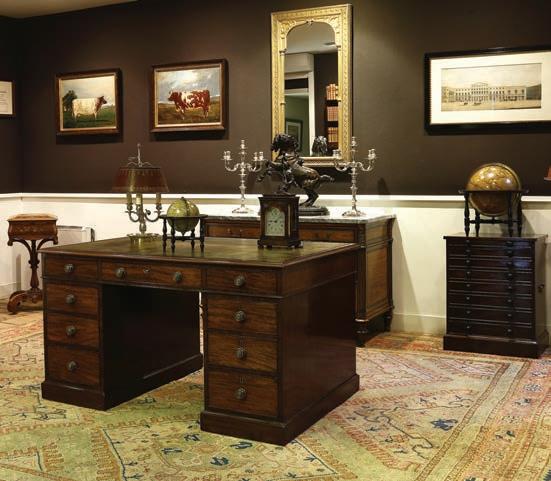

Labelled/ stamped branded furniture from Georgian to Victorian, eg Thomas Butler, Morgan & Sanders, J Alderman, Ross of Dublin (pictured), Gregory Kane, Wilkinson of Ludgate Hill, Robert James of Bristol, James Winter, W Priest, Samuel Pratt and many others. Tables all types, chairs, bookcases, , Davenport. mirrors etc. Campaign shower.
Georgian chamber horse exercise chair (pictured)
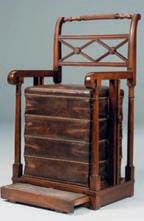
Signed and unusual furniture. Georgian, Regency, William IV. Sofa / Pembroke / side tables, library furniture / bookcases. Also Victorian campaign chests, armchairs etc.
Ross of Dublin, Morgan & Sanders, Williams & Gibton, James Winter, Hill & Millard and many others.

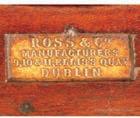
1 The Square, Church Street, Edenbridge, Kent TN8 5BD
01732 865 988 or 07836233473 cato@lennoxcato.com


www.lennoxcato.com
•WANTED• VINTAGE WRISTWATCHES


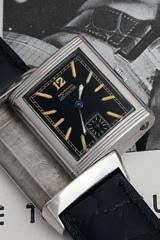
Omega Seamasters and pre-1980s Omegas in general.
IWC and Jaeger LeCoultres, all styles. Looking for Reversos. American market filled and 14k pieces possibly, at the right price.
Omega Seamasters and pre-1980s Omegas in general. IWC and Jaeger LeCoultres, all styles. Looking for Reversos. American market filled and 14k pieces possibly, at the right price.
Breitling Top Times, Datoras and 806 Navitimers.
Pre-1960s Rolex models, with a focus in pre-war tanks, tonneaus etc. Gold or silver/steel. Also World War I Rolex 13 lignes etc. Princes.

Breitling Top Times, Datoras and 806 Navitimers. Pre-1960s Rolex models, with a focus in pre-war tanks, tonneaus etc. Gold or silver/steel. Also World War I Rolex 13 lignes etc. Princes.

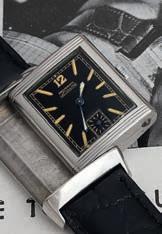
Unusual Georgian to William IV architectural features eg doors, door frames, over door pediments. 18th century staircase spindles and handrail needed. Anything Georgian or Regency with lots of character considered.
J Alderman. Daws and George Minter reclining chairs. Shoolbred/ Hamptons / Cornelius Smith Victorian armchairs.
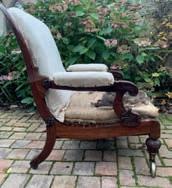
Marble fire surrounds. Georgian / Regency/ William IV. Bullseyes etc. Exceptional Georgian / Regency fire grates
Rectangular Georgian fanlight.
Sash windows x 4 identical. Georgian reclaimed. Approx 58” high x 36” wide. Wide reclaimed floorboards. Approx 100 m2. Early decorative oil / gas / electric light fittings. Ceiling, wall or table. Early gasoliers. Colza lamps. Gimble lamp.
Four identical reclaimed Georgian wooden sash windows with boxes, approx 60 high x 37 wide.
Roland Ward, Van Ingen taxidermy. Human skull. Hippopotamus skull. Stuffed crocodile / alligator.
Marble fire surrounds from 1750 to 1850ish. White or coloured. Bullseyes, William IV styles etc. Brass Regency reeded fire insert and Victorian griffin grate (pictured)
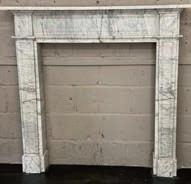

Quirky architectural features. Regency columns, corbels, marble and stone pieces, over door pediments, folding/rolling multi part Georgian room dividing doors.
Human skull, stuffed crocodile/ alligator. Grand tour souvenirs.
Longines, Tudors and Zeniths, pre-1970. Even basic steel models in nice condition. All the quirky oddities like Harwoods, Autorists, Wig Wag, Rolls etc, and World War I hunter and semi-hunter wristwatches.
Longines, Tudors and Zeniths, pre-1970. Even basic steel models in nice condition. All the quirky oddities like Harwoods, Autorists, Wig Wag, Rolls etc, and World War I hunter and semi-hunter wristwatches.
Early, pre-war ladies’ watches also wanted by Rolex, Jaeger LeCoultre etc. Prefer 1920s/30s deco styles, but early doughnuts also considered. Yorkshire based, but often in London and can easily collect nationwide.
Early, pre-war ladies’ watches also wanted by Rolex, Jaeger LeCoultre etc. Prefer 1920s/30s deco styles, but early doughnuts also considered. Yorkshire based, but often in London and can easily collect nationwide.
Victorian canopy shower bath. Decorated toilets etc Unitas, Simplicitas, Deluge etc. Decorated basins x 3. PM Antiques & Collectables are a modern and innovative antiques retailer based in Surrey. Specialising in a wide array of collector’s items, including contemporary art, entertainment and memorabilia, vintage toys, decorative ceramics, watches and automobilia.
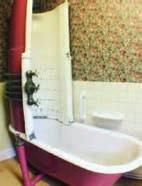
vintagejewellery@yahoo.co.uk or tel
07958 333442
For East Yorkshire town house renovation. ~ WANTED ~ vintagejewellery@yahoo.co.uk or tel 07958 333442 ANTIQUE COLLECTING 65 ANTIQUE COLLECTING 65
•WANTED•
or tel 07958
VINTAGE WRISTWATCHES vintagejewellery@yahoo.co.uk
333442
•WANTED• for epic East Yorkshire Georgian townhouse restoration. vintagejewellery@yahoo.co.uk or tel 07958 333442
We Buy & Sell pm-antiques.co.uk Contact us: phil@pm-antiques.co.uk 01932 640113 PMAntiques2015 PM_Antiques ADVERTISE TODAY PLEASE CALL CHARLOTTE KETTELL ON 01394 389969 or email: Charlotte.Kettell@accartbooks.com
Marc My Words
Above Custodianship of the 120-year-old family aspidistra has now fallen to Marc

Above right The 19th century Indian brooch, a present to his mother, was one of Marc’s rst antique purchases at the age of 14
Young love
It was also a very nostalgic process as my early memories of antiques, and my early appreciation of them, were enmeshed in my mum’s home and tied to her love of collecting.
We talked about these things, including an Indian brooch I had bought for her at a local antiques fair when I was just 14 years old. is exquisite little object from northwest India is decorated in the ewa technique and dates from the 19th century with a cut gold overlay set in green enamel.

It’s a rather beautiful thing and cost £5 of my hardwon paper round money 45 years ago. My mum treasured it and added a safety chain just in case. Movingly she handed it back to me before she died, telling me how important it had been to her, and reminding me how it had started my antiques journey.
Eclectic mix
Over the decades I bought my mum many items of jewellery, pictures and furniture. On occasion she would ask me to look out for a particular thing and when she decided to collect a certain genre or item – one being knife rests – I couldn’t help buying them for her.
e result was a cabinet lled with a very varied selection which I’m not entirely sure what to do with. Of course, she had her own taste, resulting in an eclectic mix of cherished pieces. We often laughed about the variety –including her love of kitsch glass sh which got seriously out of control.
Flower of England
The last few months have been di cult. My mum was diagnosed with cancer and sadly, there was nothing that could be done to help her. It’s been a time of sadness, re ection and joy as the many aspects of our relationship, the family and our lives, have been talked about.
For my mum it was a time of regret and eventual acceptance for the things she hadn’t managed to do in life, but also happiness for the things she had.
roughout those conversations there was a common thread involving her possessions. Being a widower, her concern was that her ‘collections’ would go to people who would appreciate them and, despite decades spent dealing with estates and probate, it was a very di cult thing to discuss with my own mum.
One of her most interesting belongings, however, is now a rather worrying responsibility. My mum had very green ngers and was an avid gardener. As a result she was the custodian of the family aspidistra which I am now entrusted with. It’s been in the family for more than 120 years. It also comes in its original gaudy Sta ordshire ceramic pot and the Edwardian plantstand it’s always sat on. None of it really ts my style, so they’ve been put into storage ready for the next generation. However, the idea of an antique plant appeals to my sense of history, reminding me of George Orwell when he said: “ e aspidistra, the ower of England! It ought to be on our coat of arms instead of the lion and the unicorn. ere will be no revolution while there are aspidistras in the window.” Don’t worry mum, I won’t let you down; not on my watch.
Marc Allum is an author, lecturer and specialist on the BBC’s Antiques Roadshow

66 ANTIQUE COLLECTING LAST WORD Marc Allum
Going through his mother’s estate brings back memories of Marc Allum’s early days as a collector, as well as custodianship of a family heirloom
‘My mother was the custodian of the family aspidistra which I am now entrusted with. It’s been in the family for more than 120 years. It also comes in its original gaudy Staffordshire ceramic pot and the Edwardian plantstand it’s always sat on’
The Canterbury Auction Galleries
Favourite star of the silver screen, Peter Cushing found international fame as Baron Frankenstein and Doctor Van Helsing in the most acclaimed films from the Hammer House of Horror.




During his lengthy acting career, Cushing also played Doctor Who, Sherlock Holmes and the villain of the original Star WarsGrand Moff Tarkin.

SUNDAY
1st OCTOBER 2023
Plus: collectible bespoke catalogue available for pre-order
Lots include: Signed film posters, movie scripts, scrapbooks, family photo albums, personal documents, notes, paintings, toys - and much more. This is a must-see auction for film enthusiasts. Register to bid at www.thecanterburyauctiongalleries.com
FINE ART AUCTIONEERS SINCE 1911 Established in 1911, we are Kent’s leading auctioneers and valuers of Art • Collectibles • Antiques • Jewellery • Clocks • Coins • Ceramics • Watches • Gold • Silver For professional and sensitive insurance or probate valuations, trust our specialists Telephone: 01227 763337 Email: general@tcag.co.uk www.thecanterburyauctiongalleries.com
SOON
MOVIE EPHEMERA
COMING
PETER CUSHING PERSONAL DOCUMENTS AND
FOR AUCTION
TheEytonCourtCollection
Friday29September2023at10amatourStowmarketsaleroom


viewing: Wednesday20September2023throughtoFriday22September2023between9am and4pm,Saturday23September20239am-1pm,Sunday24September20239am-3pm, Monday25September2023throughtoThursday28September2023between9amand4pm andonthemorningoftheauctionfrom9am.
www.bishopandmillerauctions.co.uk


Stowmarketsaleroom:19CharlesIndustrialEstate,Stowmarket,Suffolk,IP145AH enquiries@bm-auctions.co.uk01449673088
GlandfordAuctionGallery:12ManorFarm,Glandford,nrHolt,Norfolk,NR257JP norfolk.enquiries@bm-auctions.co.uk01263687342





























































 Lancaster
Lancaster





























































































































































































 BY PIERRE DELSAERDT|ESTHER VAN THIELEN
BY PIERRE DELSAERDT|ESTHER VAN THIELEN
 BY ADELE MILOZZI
BY ADELE MILOZZI


 BY KARL DEBRECZENY & ELENA PAKHOUTOVA
BY KARL DEBRECZENY & ELENA PAKHOUTOVA

























































































